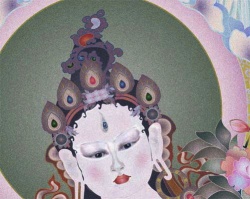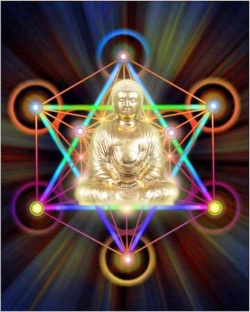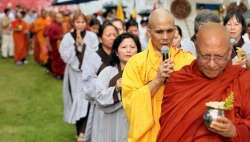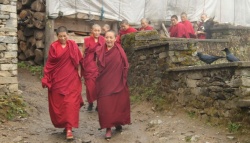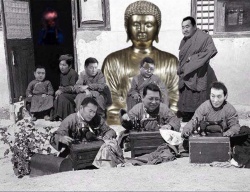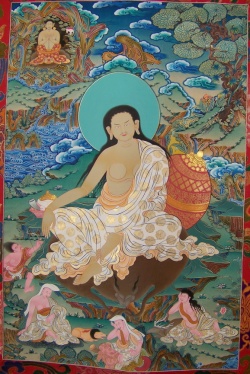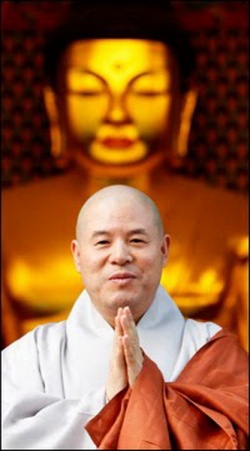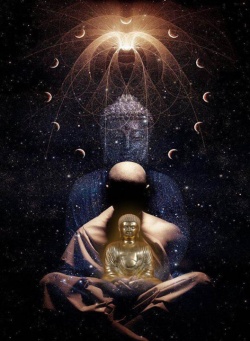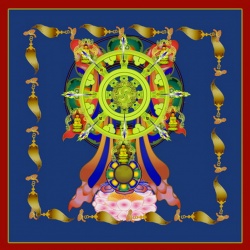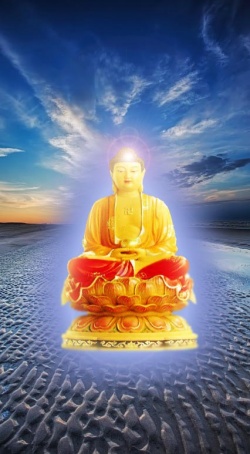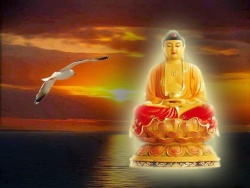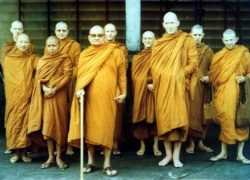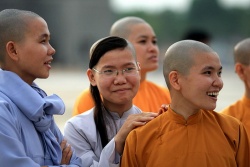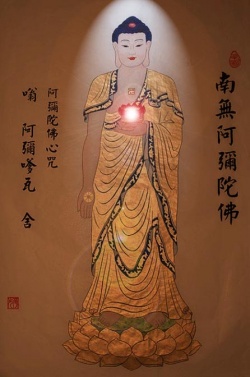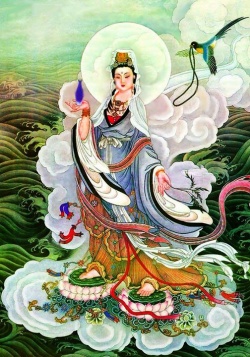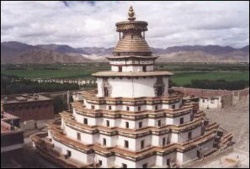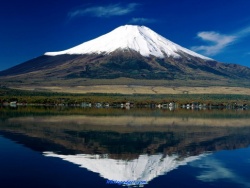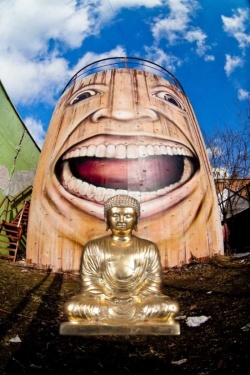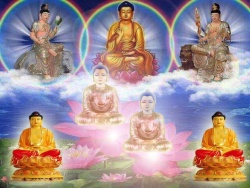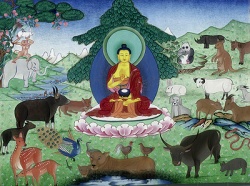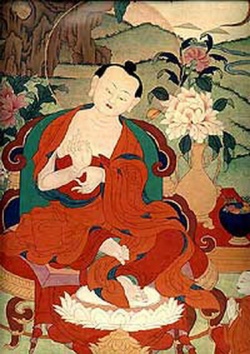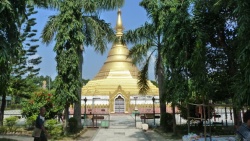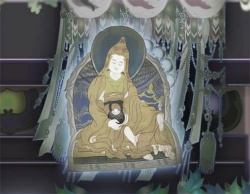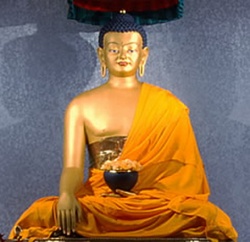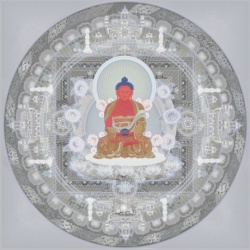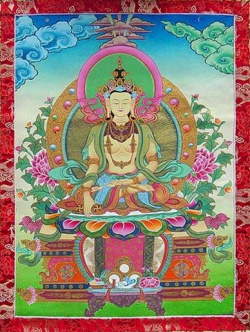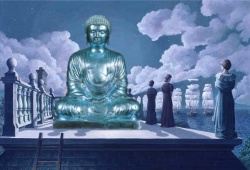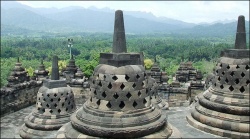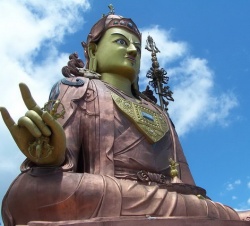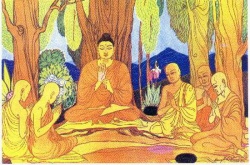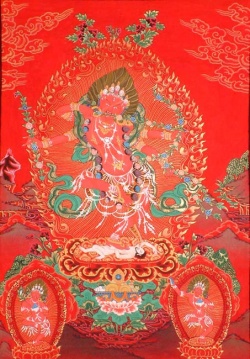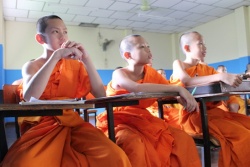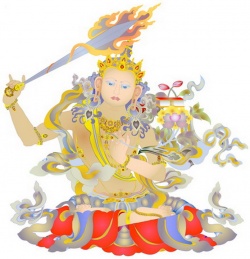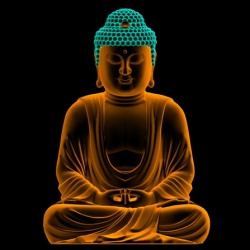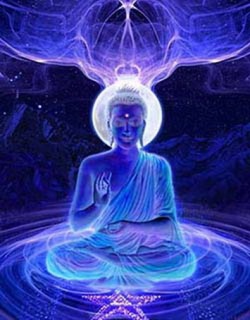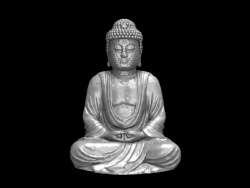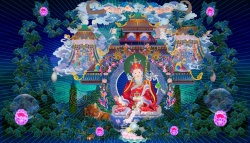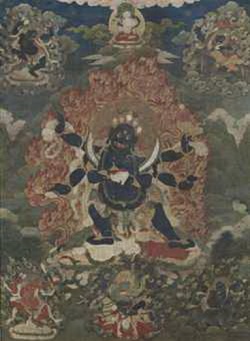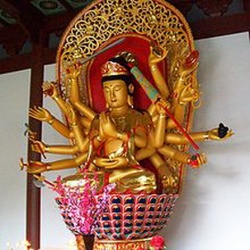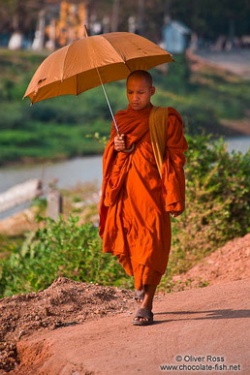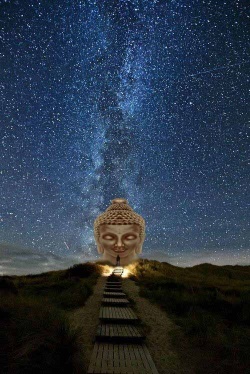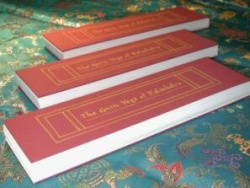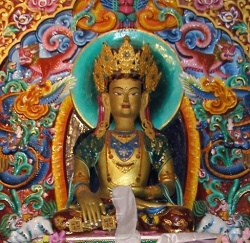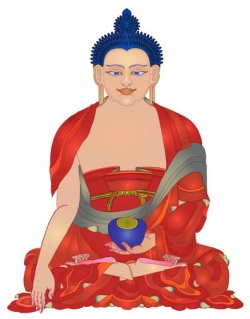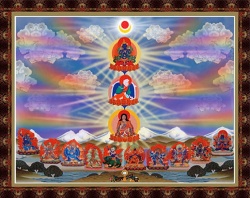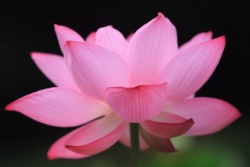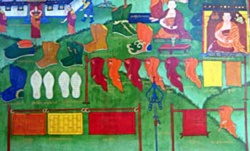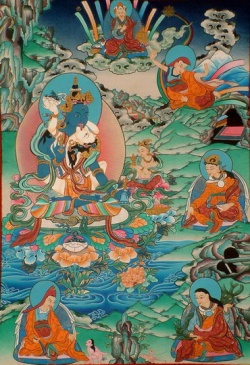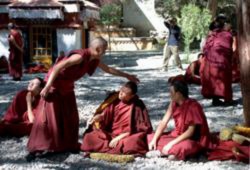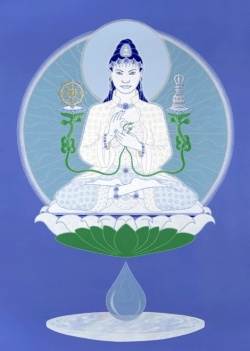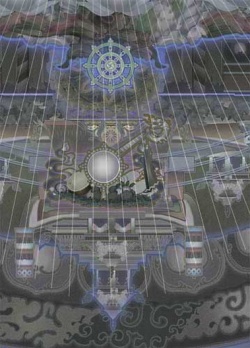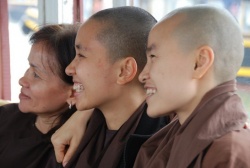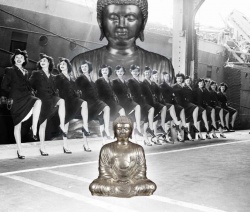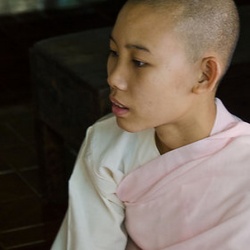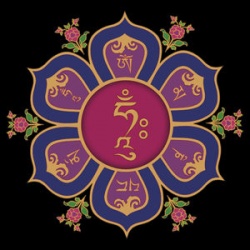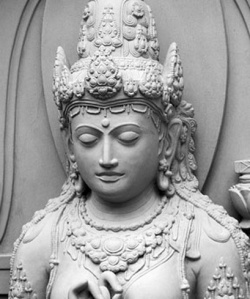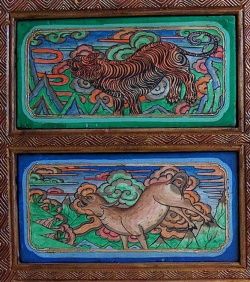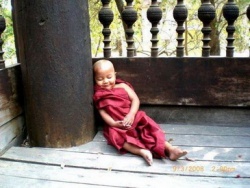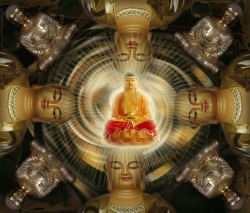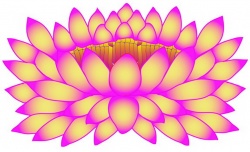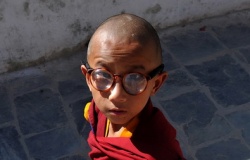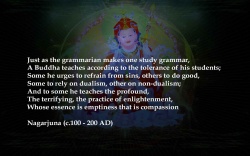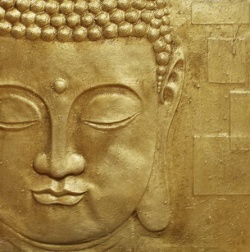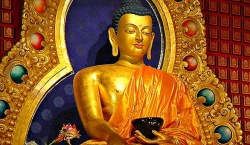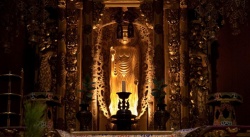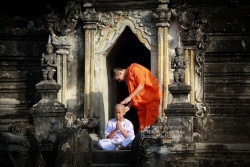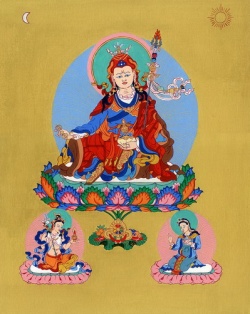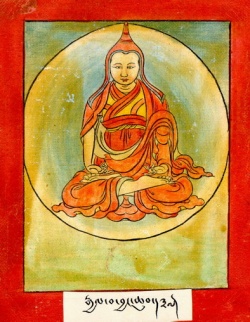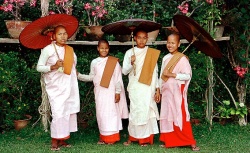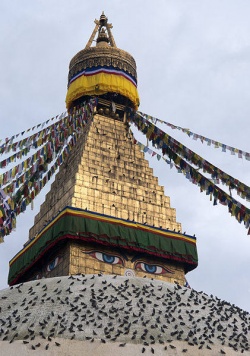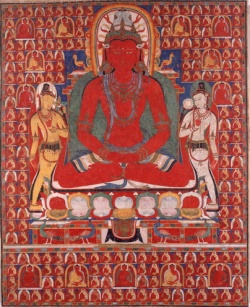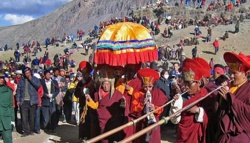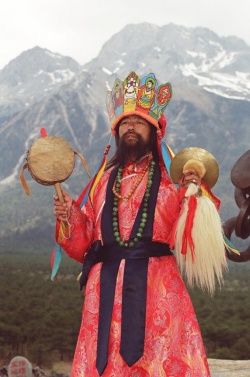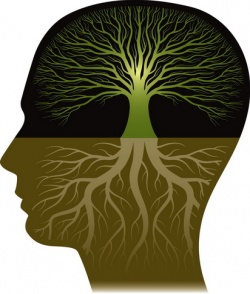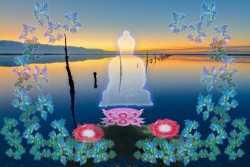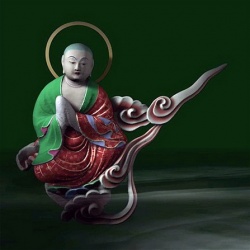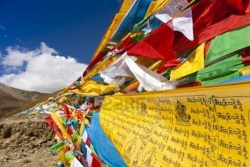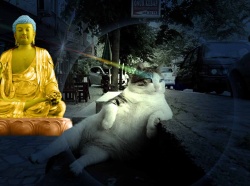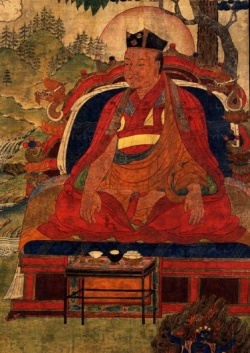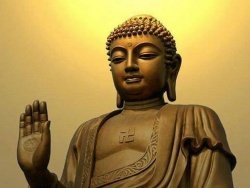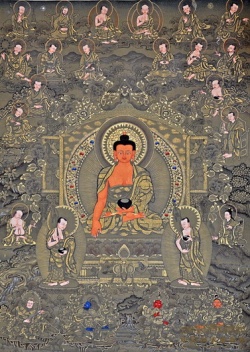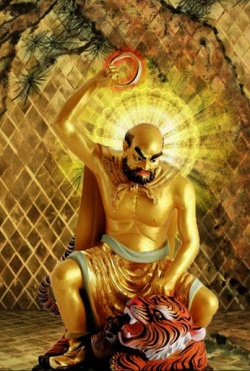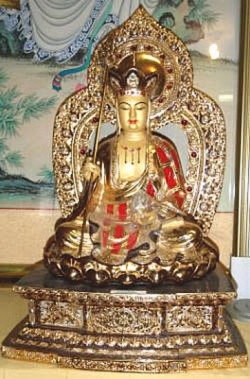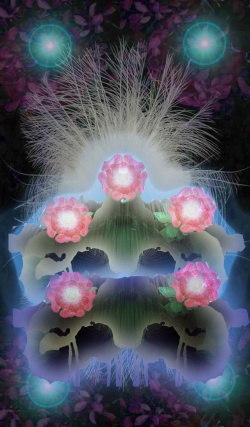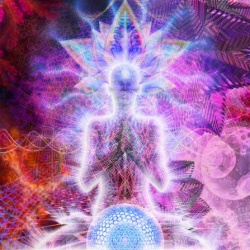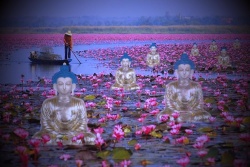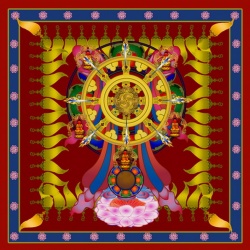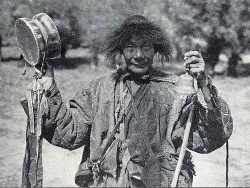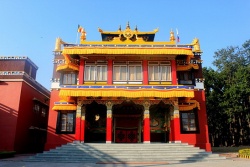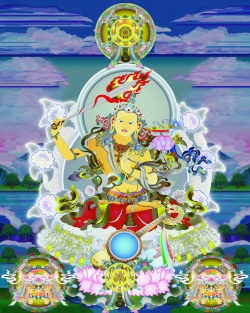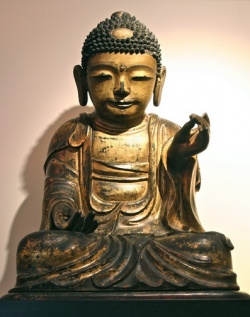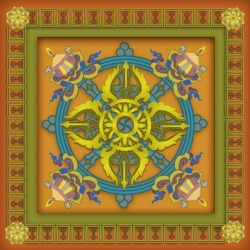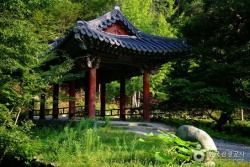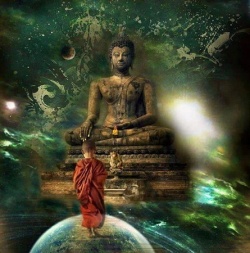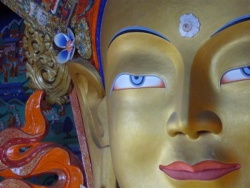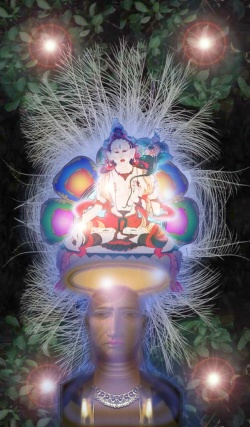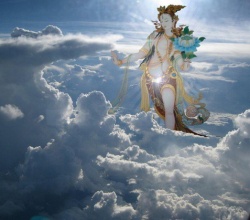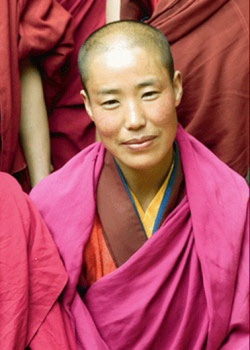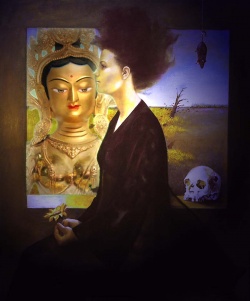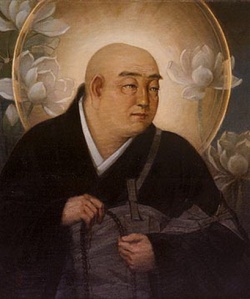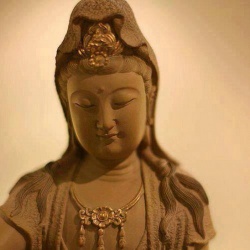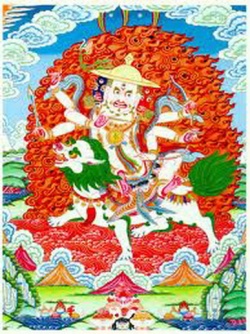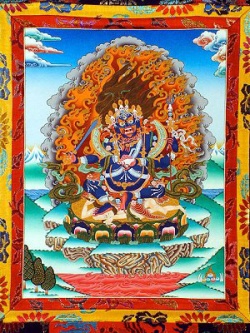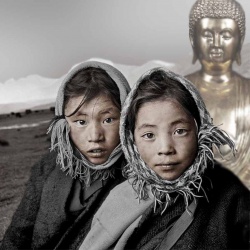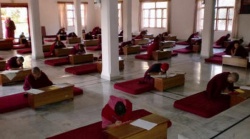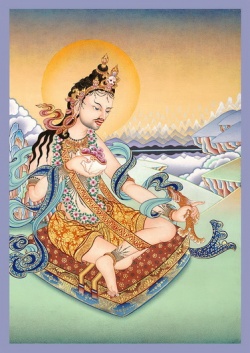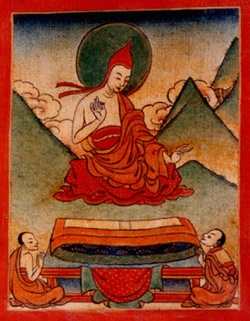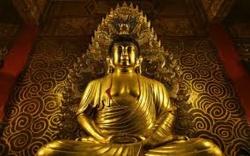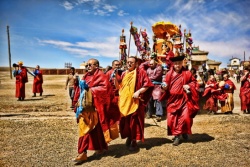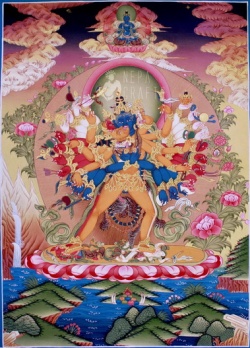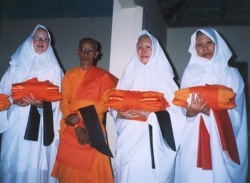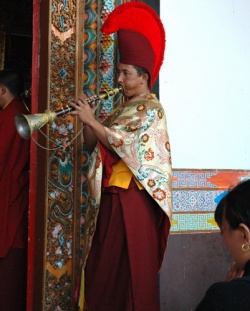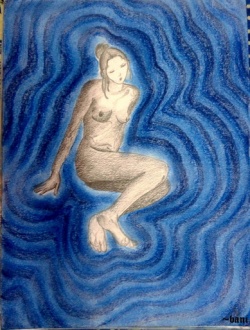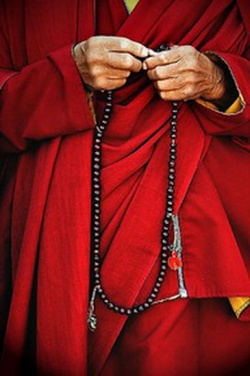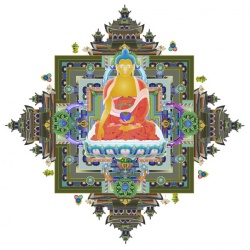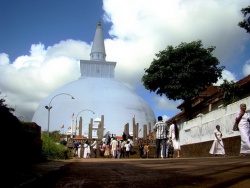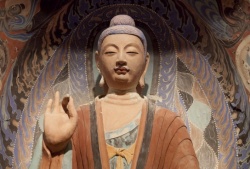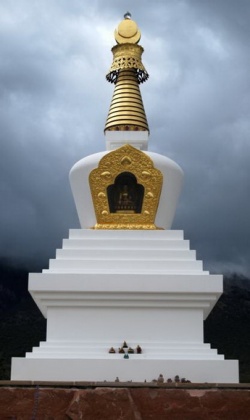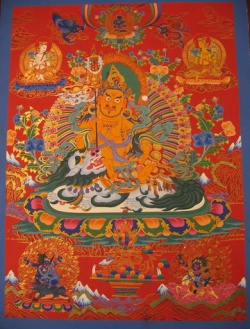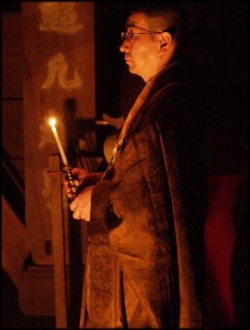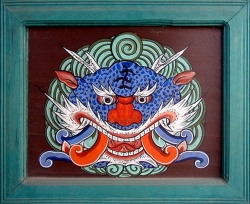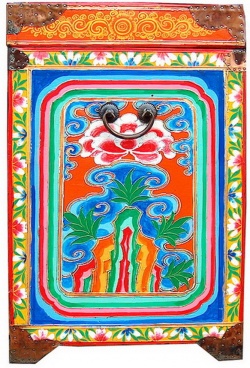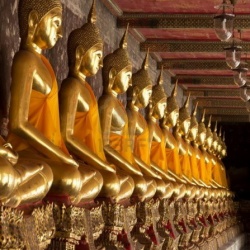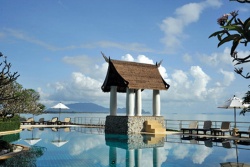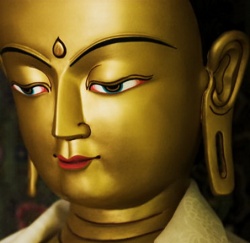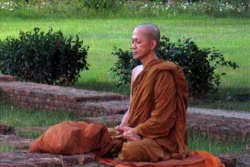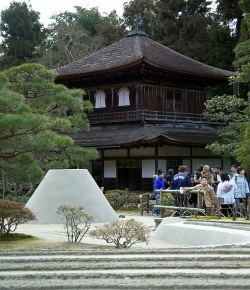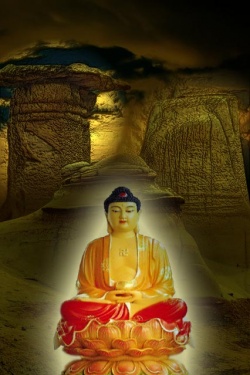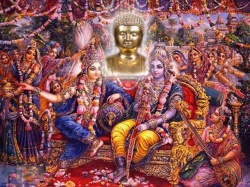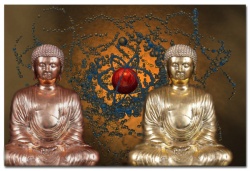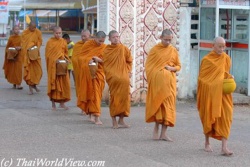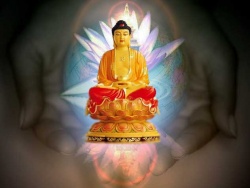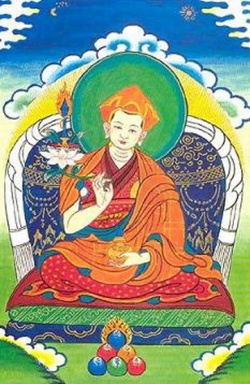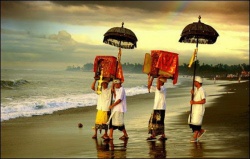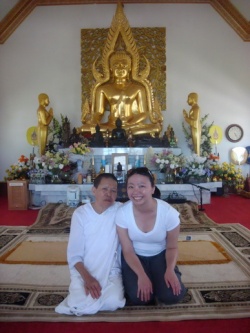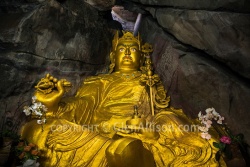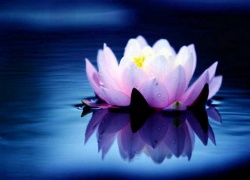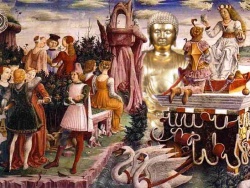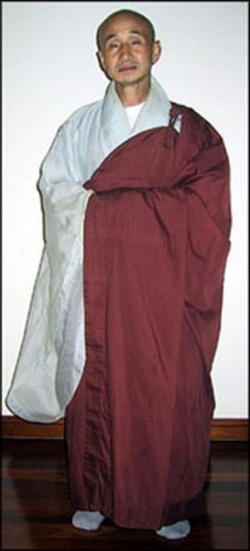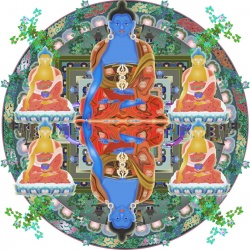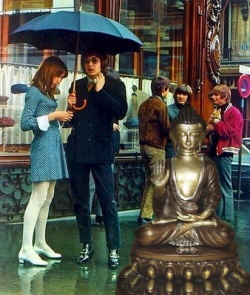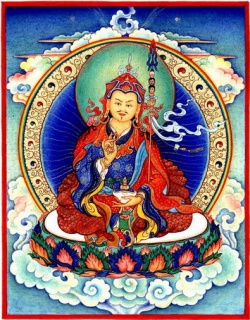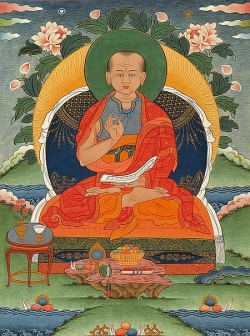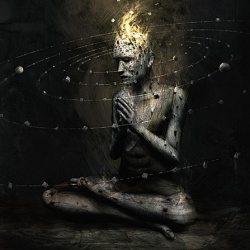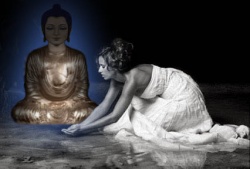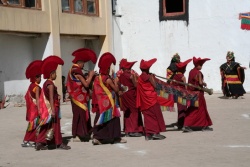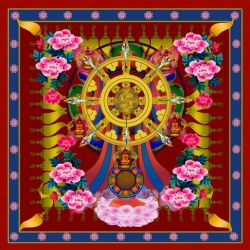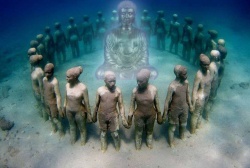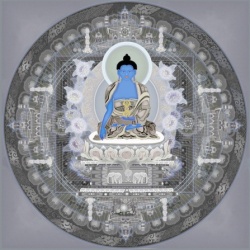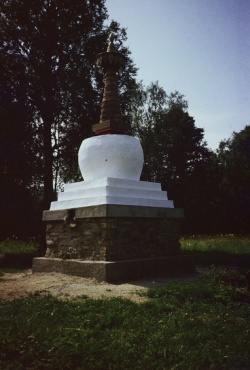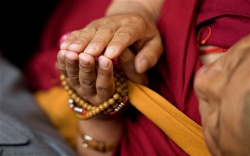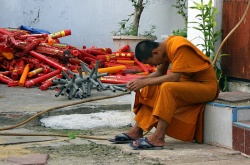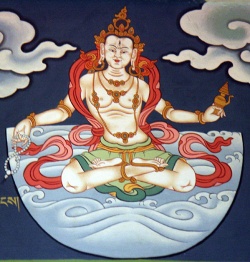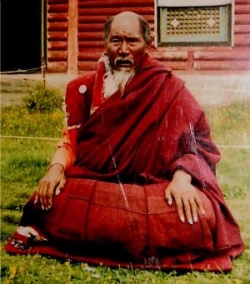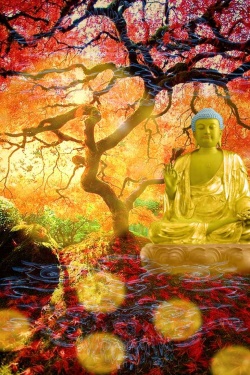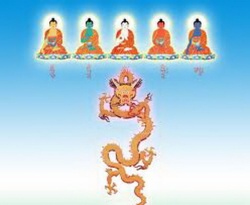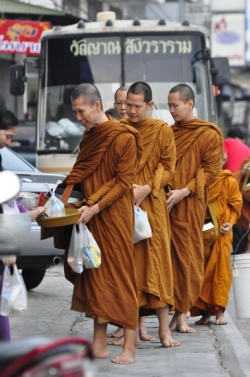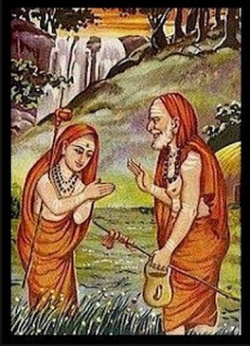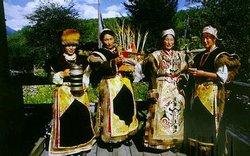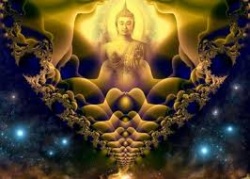The Venerable Mahāsī Sayādaw
Preface
Chapter 1
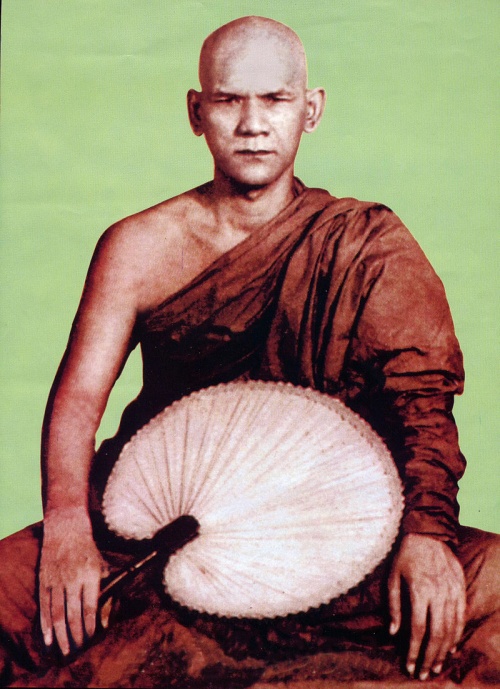
Kassani therapadānaṃ haṃ, subhaṃ bhutattasūcakaṃ. "Koyingyi" -- A Bright Student The time being the last part of the session for religious instruction at the monastery of Seikkhun village, the melodious sound of chanting and recitation flowing out from that institution and floated in the air could be heard distinctly. "Recitation" means the repeated utterances of the expression in words or phrases as explained by the teacher. It is a spell of teaching learnt by the pupil as pronounced by the teacher in turn between the teacher and the pupil. At this "Thugyi" Kyaung, i.e. monastery, which is obviously named after the designation of the headman of the village, the pupil's, voice rang forth more audibly than the voice of the teacher U Parama, the Presiding monk (Abbot) who could only be heard occasionally and feebly. As the person chanted the Dhamma with a clear sweet tone, the people nearby listening to the chanting could hear it and found it extremely pleasant and mellifluous. It is something like the speed of a "Theindaw" horse-a stallion of the first class pedigree, full of grace, smooth-going without the slightest hitch. Hearing the voice of fluent chanting, one could easily know that the chatterer was endowed with the gift of rare eloquence. Judging the nature and quality of the lesson that was imparted, the pupil who recited flawlessly was probably regarded as really wonderful. Simply because, Sayādaw U Parama's lesson that was given related to "[[[Sammoha-Vinodhani]]" commentary and its prelude. "Sammoha-Vinodhani" is relevant to Abhidhamma concerning Khandhā, Āyatana, Dhātu, Saccā, Pa ṭicasamuppāda, etc., which is a highly profound doctrine and which implies abstract metaphysics. That is why the Commentary itself is difficult. The lengthy explanation given in what is known as original Ṭīkā is even more difficult to be grasped than the Commentary itself. Among Pāḷi scriptures, it is considered to be the most fundamental and highly difficult. The explanation is pregnant with meaning, and precise. The whole text and its expression being deeply philosophical, it is doubly difficult. A person who could ably recite well is obviously not an ordinary person of intelligence, if he could do so without the assistance of the teacher in the course of his recitation. It was all the more surprising because the pupil who made the recitation was neither a senior monk (priest) nor a junior monk, but happened to be an ordinary "sāmaṇera" -a novice. A novice who had not yet been ordained as a senior priest and who was still a sāmaṇera at an early age of nineteen years but was capable of reciting philosophical text on Dhamma without a flaw and support was indeed a prodigy. Such a person with an outstanding ability can hardly be found, say, one in a thousand, (nay), one in a ten-thousand. As this elderly novice (koyingyi) was so fluent and faultless in his recitation, that one of the seven or eight priests by the name of U Nandiya, who also attended the course when coming down the stairs of the monastery was perforced to ask: "O, brother 'Koyingyi', have you studied the derivatives and intricacies relating to Dhamma-scriptures?" The reply being, "No, Sir", one could very well imagine the depth of knowledge, and know how wonderful was the wisdom possessed by that elderly novice. This sāmaṇera, a probationer in the religious Order was not only proficient in Piṭaka Scriptures called "Lessons for the Monks", but also in the worldly ( lokiya ) knowledge of mathematics. Since an early age of sixteen, he had perseveringly practiced the subject of Arithmetic called "Gaṇagambhīra" without the aid of a teacher, and within a short period of one month, he had completely understood and mastered all the methods of working out the sums and solving the problems as contained in that book. Knowledge of mathematics, which is the science of space and numbers, (comprising arithmetic's, algebra, trigonometry, geometry, etc.) is not at all easy. It has got to be taught, trained and practiced with difficulty. To become skilful or proficient in that kind of subject by merely practicing it without anyone's assistance and instructions, relying on the guidance of the book only, is a rare ability that must be attributed to his strange perfections (paramitas). There is hardly any room to doubt that this Koyingyi will also be able to acquire the knowledge of other subjects as well by merely devoting himself earnestly to those studies. When meritorious deeds are performed people generally used to pray for in a phrase- "May we be endowed with a gift to knowledge of the subjects appertaining to lokiya and lokottara, temporal and spiritual, by merely hearing or perusing it." 'Koyingyi' appears to be a personage whose wishes have now been fulfilled for having prayed, as already mentioned, in his past existences. This 'koyingyi', the elderly novice who has proved himself since his youth to have possessed an extra- ordinarily shrewd intellect far surpassing the usual ordinary mental capacity of his young age, is no other person than the embryo Venerable Mahāsī Sayādaw whose fame has spread all over the world reaching beyond the frontiers of the Union of Myanmar, and on whom depends the present-day Sāsanā in Myanmar as a reliable guide and an eminent teacher like a beacon signaling the light of Dhamma. ;Seikkhun Village The birth place of the Venerable Mahāsī Sayādaw is Seikkhun village which lies off the main road seven miles west of the town proper of Shwebo. The name "SHWEBO" in itself is well-known to all of us as the "Site of Victory" signifying the successful restoration of the Konboung Dynasty, the last of the line of hereditary rulers. It is indeed true and correct. As composed in a verse: "Foremost among the glorious past, Konboung Dynasty in history ranks first; With illustrious Alaungpaya and his comrades numbering o'er sixty; Forming a chosen team of warriors free; Ushering in a new Era of fame and glory." U Aungzeya who later became famous as King Alaungpaya the Great started rallying a small detachment of infantry forming a nucleus consisting of sixty men of the highest caliber and outstanding courage from among the village population living in the suburbs of the city of Shwebo which served as a dominant centre of his activity. He made it possible the existence of the Konboung Dynasty after reorganizing the dismantled state of the country which had fallen into chaos, disorder and turmoil. Had it not been for the revival and resuscitation of the hereditary line of the Konboung dynasty, no one could say for certain whether the Myanmar culture and fine arts which flourish to-day would have been dwindled into oblivion or have found a different expression simply because it was the Konboung Era that had left to us the remnants of the heritage of the Myanmar refined culture and arts. Just as Seikkhun village is an environ of the city of Shwebo at present, it happened to be one of the fringe villages within the limits of U Aungzeya's Shwebo township when it was established. At the time when forty-six ward elders of the Capital City were designated with coveted titles, the head of Seikkhun village had been conferred upon with the title of "Dhamma-Thura." Judging from the fact that Seikkhun village was one of the outlying villages at the time of the establishment of Shwebo town, it would appear that Seikkhun village was in existence well before Shwebo was founded. In the matter of rural development as the springing up of villages in the past were not as fast as at present, it seems that Seikkhun then was a big village. Be it as it may, it is clear enough that Seikkhun was a prosperous 'big' village at the time when the Venerable Mahāsī Sayādaw was born. This is evidenced from the fact mentioned in the epilogue in the book of dhamma known as "Vipassanā Meditation" wherein it was described as: "A big village bearing the name of Seikkhun renown, Reputed near and afar as almost a town." Mahāsī Sayādaw had once remarked that in those days, the number of dwelling houses in the village was probably in the neighbourhood of seven or eight hundred. At the present moment, Seikkhum village has grown into a large village comprising about twelve hundred buildings, and because of the famous "Ingyintaw" pagoda in its close proximity and of its close link with the well known personality of the Venerable Māhasī Thera, its name has risen to country-wide prominence. ;Sayādaw's Parents Seikkhun being one of the villages lying in the outskirts of Shwebo happens to be a source of economic support to the City of Shwebo from the business point of view. Its enviroment, being in abundance with resources of water supply such as dams and exquisite lakes, where "Kabo" canal has found its way through, paddy, maize, beans and other kinds of cereals are prolific. As nature has benevolently provided it with a wide expanse of greenish-brown arable land coupled with a number of pleasant gardens, orchards and lofty trees, it has become a prosperous village with a rich hinterland. Moreover, producing the well famed cotton piece goods and fabrics popularly known as "Chiba" cloths, the 'big' village is renowned as a small town within Shwebo district with its thriving handloom textile industry. Both the parents of the Venerable Mahāsī Sayādaw were the natives of that Seikkhun village. U Kan Baw is his father's name and that Daw Ok is his mother. Upon his parents' side they were all honest cultivators by occupation in the way of their livelihood as was customarily the case with the majority of inhabitants living in the rural area. In those old days, one bread-earner's income was sufficient enough to feed the whole family. Hence, although U Kan Baw and Daw Ok could not be regarded as being rich belonging to an affluent society, they were fairly well-off, and self-sufficient without having anything to worry about their own subsistence. The young people of that village generally addressed Sayādaw's mother as "Aphwa Ok", which literally means "Grandma Ok". Some of course, with due respect called her Daw Shwe Ok. This fact was mentioned by the Sayādaw himself in his written scriptural text by the name of Visuddhi Magga Mahāṭikā Nissaya (Nigon-last portion). It seems that mention was so made probably not to let the people run away with a wrong idea that the correct name of his mother was not either Daw Phwa Ok or Daw Shwe Ok. The Venerable Sayādaw loves the truth, and that is the reason why he once stated as mentioned hereinafter about his parents' occupation just as he had done in the case of his mother's true name. What he said with unassuming honesty was that the occupation of "Dagagyis" (his parents) was simple farming. As yeomen, they owned a plot of cultivable land that could be ploughed with just a pair of bullocks, i.e. about 12 acres or so in area. With this piece of land which seemed fairly adequate within one's own capability to manage, they lived on and sweated for their own living. ;The birth The Venerable Mahāsī Sayādaw, the second son of U Kan Baw and Daw Ok, was born at about 3 a.m. on the 29th. July, 1904 (the third waxing day of the Second Waso, 1266 of the Myanmar Era). U Kan Baw and Daw Ok had three other sons and three daughters besides the Venerable Mahāsī Sayādaw, thus making a total of seven children in all. The eldest son was U Tin who died at the age of twenty-eight. Next to U Tin was the Sayādaw, and younger than him was Daw Khin. Daw Khin died at an early age of sixteen. After Daw Khin came U Hmin, U Ba Yin and Daw Thin. All three died after they had reached the age of twenty. The youngest of the lot was Daw Sat, who passed away at the age of about fifty in the year 1333 M.E. Among all these children, U Tin, Daw Thin and Daw Sat got married, while Daw Sat had three sons and three daughters. The off springs of Daw Sat are still living. A passing reference to his brothers and sisters reveals that none of them lived long. Sayādaw's mother, having died at the age of 44 (forty-four) in the year 1286 M.E. may be said to have had a short life. Only Sayādaw's father alone had lived up to 78 (seventy-eight) years. The Venerable Sayādaw is now nearly seventy-six years old. Therefore, considering his age, it may be stated that his health is pretty good. By his careful way of living and by strictly adhering to the medical advice and directions of his first-rate physicians, he will not only reach the age of his father but will also have a longevity even much more than his father. We wish the Sayādaw a happy life exceeding the ordinary life span of a century. ;Assuming The Role Of Sāmaṇera Or Entering Into Priesthood Looking at the names of Sayādaw's elder brothers and sisters, it will be found that their names were all given in rhymes, such as, U Tin, U Khin, U Hmin, U Ba Yin and Daw Thin. Such being the case, it seems probable that the young boy who was the embryo Sayādaw must have been given a name in the like manner with a rhyme. What is really surprising is that the name of the Sayādaw when he was a boy happened to be identical with the name of the wealthy gentleman who would later entrust the Sayādaw with the ecclesiastical administration of the Sāsana Yeikthā (the present Mahāsī meditation Centre where the Sayādaw now resides), through great devotion and reverence. It could be just a coincidence. However, if it is stated that the very name given is nothing but a Nimitta- precursor of what the future will be, no one will probably deny. As is usually the custom in rural areas, the would-be Sayādaw, the boy, was sent to the monastery for his early education when he was 6 years old. It is really the case. In those old days when the knowledge of science had not yet gained popularity, the monasteries afforded a training centre for education, which imparted vocational as well as spiritual studies. Equipped with the knowledge acquired from such institutions where reside the community of monks, or a monk or two, it is not only possible for a person to stand on one's own feet for a livelihood but also to climb the ladder for the attainment of eminent positions such as, the high ranking posts of civil commissioners and Ministers and army Generals. That is the reason why men of intellect and people holding high ranks in those days were all the products of the monasteries. At the time of the embryo Sayādaw's first admission to school, though the knowledge of science was fairly advanced and well-known in Myanmar, there were no schools in villages where such technical subjects were taught as at present; the monasteries or monastic schools had to take the responsibility as the seat of learning to impart knowledge in both temporal and spiritual affairs relating to education, culture and discipline. As such, the future Sayādaw had received his early education relevant to what a boy of his age should know in the art of reading and writing, from U Ādicca, the presiding monk of the "Pyinmana" Kyaung (monastery) at Seikkhun village. In his boyhood at the age of twelve, he was novitiated as a young priest ( a novice) and became a 'sāmaṇera, - under the guidance of his old teacher U Ādicca, the abbot. As a ' sāmaṇera ' the name given to him was "Shin Sobhana" which fitted in with his personal appearance and personality. Certainly it is. Sayādaw bears the characteristic of a true native of Shwebo District possessing a good height and prominent features. His hands, arms, legs and other limbs of the body, etc. are also long, and slim, stout and full, matching his dignified stature. He is highly intelligent too. (In his portrait contained in a journal published in April-May, 1954, big broad ears are more conspicuous). His looks calm, dignified and serene truly reflects his tranquil state of mind and inner Peace-Samādhi which is far from being artificial. There is elegance and gentleness when he talks and walks. As it is hardly impossible for a human to erase or discard the inborn traits of character, by judging the Sayādaw's graceful looks and highly respectable demeanor as is found today, it can be assumed that almost the same condition relating to the manners and behaviour might have prevailed in the early part of his age. For this reason, the name "Shin Sobhana" (which means a person full of grace and dignity) that has been given to the young priest is so much in harmony with his handsome physical appearance and dignified personality, that the name itself exactly fits in with the man's personality. Furthermore, it seems that his preceptor must have given him the name of "Shin Sobhana" with wonderful foresight that this young priest, the would be-Mahāsī Sayādaw-would rise to great heights with radiance in this Sāsanā possessing the rate qualities of a famous prelate in the hierarchy of Buddhist Priests adroit in the field of practical Vipassanā (paṭipatti) and of the Buddhist scriptures (Pariyatti). From whatever angle it is viewed, the title or name of "Shin Sobhana" is pre-eminent. 'Koyin' Sobhana, the novice, after entering into priesthood, took his lessons on ten Jātakas (the Birth Stories of the life of the Blessed One in the last ten existences prior to His becoming the Gotama Buddha). The presiding monk being well aware of the young priest's keen intellect, taught him the Vinaya Pāḷi and Aṭṭhakathā- (commentaries) without the foundation of the basic knowledge of the Grammar. Thereafter only, the presiding monk let him study the grammar and 'Sangaka' -a doctrinal portion of the Tipiṭaka Dhamma. In the past, a student-pupil taking the course of lessons, was not ordinarily allowed to tackle with the Nissaya. Nor were the teachers willing to permit the pupils to deal with Nissaya. This was to prevent the pupil from taking things easy or becoming slack. However, as regards Shin Sobhana even at the time he was learning the advanced grammar, both the two volumes of "Nankyaung" nissaya and Dakkhiṇavaṃ nissaya were allowed to be studied in combination. Through unremitting application of his endeavour, he had succeeded in digesting it. Likewise, by also pursuing other branches of knowledge relating to grammar. he reached the stage of competency capable of teaching others. Shin Sobhana's intelligence was more obvious when he was learning the Ṭīkā. Even while perusing the Ṭīkā, he was able to memorize it and do the recitation by heart. Not only was his memory good, but also is intellectual faculty of reasoning power or intuition was remarkably penetrating. It has been mentioned earlier in this biography that at an early age of sixteen, he could grasp fully through practice the big book of Arithmetic called "Gaṇagambhira" inside a month without the aid of anyone. Shin Sobhana being endowed with the attributes of his inborn talent and wisdom coupled with his untiring effort, was able to acquire higher knowledge of the Pāḷi Commentaries and the Ṭīkā even in the capacity of a novice. ;Transfer Of Residence When Shin Sobhana was seventeen years old, circumstances had shaped themselves in such a way as to require him change his residence-monastery. In that year his earliest teacher Sayādaw U Ādicca abandoned the yellow robes, i.e, the role of a monk, and became a layman. Therefore, being left stranded without a teacher upon whom reliance could be made to enhance his knowledge of dhamma, Koyin Sobhana was compelled to shift his residence to "Shwe-Theindaw" monastery in north-Chiba village. There, he continued his studies and took lessons on the short volume of grammar called "Saddatthabedacinta" from 'Myaunggyi' Sayādaw U Ācara who was then the patron or the Chief of that Shwe-Theindaw monastery. Later, when another teacher by the name of U Parama became the Presiding monk at "Thugyi" Kyaung in "Ingyintawtaik", Koyin Sobhana again changed his residence to that monastery. On a site north-west of Seikkhun village about 400 "tās" (approximately 5600 yards) away, stands the historically famous "Ingyindaw" pagoda (shrine). According to its history, this pagoda was built and renovated and was reveringly treated as a place of worship successively by a number of previous kings, such as Thiridhammāsoka, Narapatisithu, Mindon Min, etc., during their regimes. It is a place which has earned its reputation through the ages as an attractive centre of pilgrimage and festivities. Annually, the religious festivals are celebrated commencing from the 8th waxing day of the month of Tagu (usually falls in April) to the fullmoon day of that month. During the festival days, the place become vivacious and is thronged with various ethnic groups of pilgrims, and traders (sellers and buyers) from all over Myanmar. All kinds of commodities and household goods which will meet the needs of both village folks and town folks are said to be available as desired. In the neighborhood of this majestic and beautiful "Ingyindaw" shrine, a number of monasteries can be found at present as of yore. All these monasteries in a group as a whole are called "Ingyindaw-Tike" ("Tike", sometimes spelt 'Taik' means a group or cluster of kyaungs). The present well-reputed Mahāsī Kyaung is one of them. In the past, however, this monastery did not bear the name of Mahāsī Kyaung. By tradition, the name of the Kyaung was usually given after the name or title of its Presiding Monk. The "Thugyi" Kyaung lay (and still lies) adjacent to Mahāsī Kyaung on the north-west. It was formerly an old rickety monastery but as the Headman of the village had reconstructed it, it carried the name of "Thugyi" Kyaung-meaning the Kyaung built by the Headman. This was the monastery where Shin Sobhana had resided till the end of the fourth Vassa after his ordination as a monk (Rahan). Koyin Sobhana continued to devote himself seriously to the religious studies comprising various branches of Piṭaka with the aid and direction of the Presiding monk of that "Thugyi" Kyaung. Particularly, at the age of nineteen when Shin Sobhana was still an ordinary young priest " sāmaṇera ", he had learned a lot and accomplished himself with " Sammohavinodani " Commentary and the voluminous Mūlaṭikā of the Piṭaka, which ordinary monks would not even dare approach or tackle. ;Gaining Admission To The Order Of Sanghas After attaining the age of nineteen, the time had come for Koyingyi Shin Sobhana to make a firm and supremely important decision in connection with his life's career. Appraising himself of his position in life as a sāmaṇera, he had to ponder deeply thus: "Having entered the realm of S āsanā , I have studied the Buddhist scriptural texts and literature to some extent. I have been able to acquire the knowledge of dhamma within a few years, which to others would have taken many years to achieve. Therefore, there is no doubt that I have the necessary ability, foresight and aptitude. If such fine qualifications were made use of in the pursuit of contemporary worldly business affairs, I'm sure I will really make a good headway in this worldly life, amass a good fortune and become prominent and prosperous. Similarly, after having acquired the knowledge of Buddha's dhamma to quite a considerable extent, I could become a person rich in experience of the spiritual knowledge in the world of human existence. Apart from that, in the life existence, there is ample scope for me to devote my genius and gain more complete knowledge of the religion. I have also studied the lessons in English in part from my relative U Candimā, a monk, while I was residing at "Shwe-Theindaw" monastery in Chiba village. If I were an ordinary layman in the mundane world, I would be in a position to continue to learn English to my entire satisfaction. For these reasons, should I revert myself to the level of this temporal life?" "Since I have learnt and gained considerable knowledge of the Buddhist Literature, I have come to visualise, superficially of course, the shallowness or depth of the Buddha's Sāsanā. In addition, since I have tasted the sweets of the noble priestly life, feeling of insatiable thirst and desire for tasting more of Buddha's Sāsanā has arisen in me. In fact I have a craving desire for practical application of the Buddha's Teachings. In particular, I am keen to practise wholeheartedly the kammaṭṭhāna meditation in accordance with the Buddha's direction and preachings. If possible, I wish to follow the footstep of the "Thee-Lon" Sayādawgyi whose fame has spread throughout this part of the country and make myself distinguished like this eminent Sayādawgyi. If I am really bent upon implementing these objectives successfully, I should continue to remain in the realm of Sāsanā. Hence, should I seek peace and happiness in this Sāsanā by going a step further to enter the role of a rahan (an ordained monk)?" Reaching the junction of the road-a dilemma-with these rambling and ramified thoughts, it would appear superfluous to say that the decision which Shin Sobhana had to make, was of paramount importance for him. However, looking at the present day affairs of the Sāsanā in Myanmar , it seems quite clear that the decision will be crucially significant for the future Sāsanā and posterity. If at that time, Shin Sobhana's decision arrived at were to return to the life of an ordinary worldling, the present state of the affairs of the Sāsanā (particularly Paṭipatti Sāsanā) might not have been the same as it is now. We can fairly surmise that it would have been quite different. In all the lives of the world-famous personalities which go down in history, their deeds and doctrines will un-doubtedly have the beneficial effect or leave an indelible impression in one way or the other on the country, race and religion. It hardly needs special mention as to what kind of decision Shin Sobhana had reached at that time. For the decision so made, Shin Sobhana who had then reached the age of 19 years and 4 months on Monday, the fourth waning day of Tazaungmon (month of November) 1285 M.E, received the higher ordination and rose to the rank of a senior priest in the name of "U Sobhana". At that time, Sayādaw Sumedā, an eminent personage was residing at
Sumedā monastery]] in Htansin village near Seikkhun. This distinguished Sayādaw was the Arch-Prelate of the so-called "Mahābo" Sect. Therefore, U Sobhana was ordained and admitted to the priestly Order by the Reverend Sumedā, the Arch Prelate and Ashin Neimmala Thera as his Preceptors assisted by Sayādaw U Parama and other 'Kamavācā Sayādaw together with thirty-five other 'kammakāraka' sang has who tendered their ecclesiastical vote by a resolution at the ordination service. To enable U Sobhana to be ordained a senior priest (Upazin), his uncle and aunt U Aung Baw and Daw Thit accepted the role of his benefactors for the ceremonial function.
Ashin Sobhana was not only bent upon acquiring the scriptural knowledge ( pariyatti) but also inclined to take up the parctice of meditation ( paṭipatti). By putting himself into practice, he wanted to know through personal experience that the noble preachings of the Blessed One are true and correct. However, at that stage, since he had not yet fully accomplished in his scriptural learnings, and being comparatively young also, he was constrained to suppress his eager desire for pursuing paṭipatti, but then he proceeded to gain the acquisition of the basic scriptural knowledge only, with relentless effort. Meanwhile, he taught others too as much as he could. While he was thus earnestly persevering to acquire pariyatti, he had never neglected to strictly observe the rules of conduct laid down for the priests (morality or Sīla) which is the basic requisite for the practical exercise of meditation ( paṭipatti). Even within the period of the first four months after he was ordained as a monk, he had seriously observed the meritorious practices according to the precepts called " dhutaṅgas " viz: rukkhamū dhutaṅga, pindapātika dhutaṅga, ekāsanika dhutaṅga, pattapindika dhutaṅga, etc.
For the purpose of acquiring the scriptural knowledge, he continued to take lessons from U Parama, the presiding monk of the "Thugyi Kyaung.
- Pāḷi "Pathamabyan" Entrance Examination
Examinations had become a fashion of the day among the world of monks in the Union of Myanmar at the time when Ashin Sobhana was admitted to the Order of Sanghas. The majority of the people would give recognition as a person of erudition only to a monk who had been successful in the examination. Also in matters connected with the affairs of the Sāsanā, there were works which could be beneficially performed if there had been success in the examination. To be quite candid, performances and preachings of a person who had passed the examination were used to be readily accepted and complied with faith and confidence by the public in general. The majority had a notion that only those who passed the examination had reached the required level of status deserving of recognition. As such, in order to be more effective in all performances and activities concerning the future Sāsanā, Ashin Sobhana sat for the first Pathamabyan initial examination conducted by the Government in the year 1286 M.E. even before his completion of the first Vassa as a senior priest. He got through the examination easily despite the fact that he had not the slightest idea as to what type of questions would be set at the examination simply because he had been equipped with the knowledge of the scriptures far in advance of the standard required of such an examination, and also because he had been teaching others.
In the year 1287 M.E., after a year (one Vassa) from the time of his higher ordination, Ashin Sobhana went to Syriaṃ opposite Yangon, on the other side of the river. He reached Syriaṃ at the beginning of the rainy season. From there, he proceeded to Bassein where a monk, a native of Seikkhun, was residing. Later, he returned to Syriaṃ and took up his abode as a retreat for a vassa (rainy season). In that year, as he had been very busy with his itinerancy, he could not find time to sit for the examination. In the year 1288 M.E., however, he appeared for the 'Pathamalat' examination as a candidate from Syriaṃ, while temporarily residing at Mya-Thein-Dan Kyaung of Kyaungdawyā Taik in Yangon. Without much weariness and effort, he found success in the examination. After passing this Pathamalat examination, Ashin Sobhana gave away in charity to the Presiding monk the monetary award that was donated to him by the Government, and then returned to Seikkhun taking along with him only the Pass Certificate. In the year 1289 M.E. while at Seikkhun, he appeared for the Final 'Pathamagyi' examination. As there was no examination centre at Seikkhun village, he had to go to Shwebo and then sat for the examination. It is to be noted and remembered as stated by Mahāsī Sayādaw that Ashin Lāsana, younger brother of the present Gandayon Sayādaw of Amarapūra Town , also appeared for the Pathamagyi examination at the same time with him, in the role of a 'sāmaṇera'.
- To Mandalay For Further Pursuit Of Studies
In the days of Ashin Sobhana, after his success in Pathamagyi examination, the road to examinations came to a dead end. There were no further steps to climb. Nor were there any classes for tuition or examinations as at the present day. Since considerable progress had been made in the study of scriptures and since examinations had reached the terminus, it was only necessary to receive doctrinary instructions from the teachers as might probably be found by chance. In some cases of course, it is only through the wise counsel of the teachers that the right way to correct thinking could be reached. To receive many a wise counsel and fruitful instructions of the teachers, it was imperative to stay where there were a number of teachers (of intellectual fame). Therefore, in the year 1290 M.E. after accumulating four vassas as a monk, Ashin Sobhana left Seikkhun for the Capital City of Mandalay known as "Yatanābon" which had the reputation as a centre of spiritual learning with a large number of competent teachers adroit in the field of Buddhist literature. Generally speaking, if a trip had been made to Mandalay, the most learned city in Myanmar, a person was said to be really learned. As regards Ashin Sobhana, however, he had an aptitude and skill in seeking knowledgeable experience. Rather, it would be more accurate to say that he was capable of learning.
During those days, at the well-established big monasteries in Mandalay, the student-sanghas were numerous; and also in almost every group of monasteries (Taik-Kyaung), a good number of eminent teachers (Sayādaws) were found to be present. It was the time when both the students and teachers alike were making tireless efforts in learning and imparting pariyatti- scriptural knowledge-, respectively. Since teachers were many and plenty, mediocre Sayādaws had hardly any chance to gain popularity or rise to fame. At that time in Mandalay, only if a monk was really very intellectual and exceedingly scholastic and smart in the art of teaching, he could hope to become a reputed spiritual teacher. Therefore, if anyone was desirous of acquiring the knowledge of pariyatti, Mandalay city being the seat of spiritual learning, must invariably be visited without fail. That was the reason why Ashin Sobhana had made his journey to Mandalay leaving behind his native place, his teachers, parents, relatives and others. On his arrival there, he went straight to "Bwadaw Kyaung" at Khinmakan Taik in Anaukpyin (western part of Mandalay) where there were people who had had communication with him.
Ashin Sobhana again proceeded with his studies in Pāḷi, commentaries and Ṭīkā under the guidance and supervision of the most eminent Sayādaws while residing at the 'Bwadaw Kyaung of the Khinmakan Taik. At that time, in Anaukpyin, Sayādaw U Lakkhaṇa of Chanthāgyi Kyaung was well-renowned and a very popular teacher. [[Ashin] Sobhana]] never missed the lesson classes of that Sayādaw. Neither did he remain absent from attending the classes conducted by the Sayādaws of Taungthaman and Khinmakan Taik Kyaungs, and of the Sayādaw U Indavamsābivamsa, etc,. residing at Taik Thit (meaning new Taik) which lies to the west of Aletaikgyi.
In this manner for a period of over one year, Ashin Sobhana had learned all the methods imparted by the teachers who had earned very good reputation in the field of pariyatti. It may be said that the duration of his one year's stay in Mandalay was brief. Nevertheless, since Ashin Sobhana was a person of great ability with a sufficient background experience in scriptures, over a year's stay in Mandalay may be regarded as more than adequate. On the other hand, it appears that Ashin Sobhana had an intention to stay in Mandalay longer than that period. However, in the year 1291, owing to an unforeseen circumstance which had caused him to leave Mandalay, he was obliged to depart from that city contrary to his original objective.
The year 1290 (Myanmar Era) in which Ashin Sobhana reached Mandalay , was the year when "Ye-Myet-Gyi" 'In' (the Great Lake ) was hit by unprecedented floods. The Venerable Sayādaw had once stated that he (Ashin Sobhana) had to travel by steamer from Mandalay to Kyaukmyaung (a reverie port near Shwebo) on his way back to Seikkhun owing to the death of one of his cousin brothers in that year.
- Arrival At Moulmein Taungwainggale
One day, a letter was received by Ashin Sobhana who was then residing at 'Khinmakan Taik'. This letter was from the Sayādaw of Taungwainggale Taik Kyaung of Moulmein. The letter conveyed a request with an invitation wishing Ashin Sobhana to come over to Taungwainggale to give instructions relating to dhamma to the pupils there. The Sayādawgyi of that Taik Kyaung was a native of Seikkhun though he was residing at Moulmein as a Presiding Monk. News had already reached him about Ashin Sobhana's outstanding success in the examinations and performances relating to pariyatti. That was the reason why he had requested Ashin Sobhana to assist him in promoting the Pariyatti Sāsanā and also because Ashin Sobhana was a native of Seikkhun just as he was. As the Sayādawgyi was a personage really worthy of great respect, and as he himself had also gained accomplishment in the Buddhistic studies to a certain extent at Mandalay, Ashin Sobhana left for Moulmein in that year (1291).
It seemed as if Moulmein Taungwainggale was according a warm and enthusiastic welcome to Ashin Sobhana who had left his native village heading for a new place to start opening a new chapter in his life's career. It is exactly so. Though it assumes the name of Moulmein Taungwainggale, it is, in fact, not within the city precincts of Moulmein. It is a Centre situated at a place about a couple of miles away to the east of the City. At this place there is a hill that tapers off into a projection forming a round shape nearly spherical or so, and in accord with its appearance and outline, it has been given a fitting name of "Taungwainggale".
Being in the lower region of the country where rains are abundant, this "Taungwainggale" (which literally means a small round hillock) is adorned with a variety of verdant trees always fresh and evergreen. Having stood at a good distance fairly far away from the city, there is peace and tranquility. To say that there is "peace and tranquility" means all worldly pleasurable sensations are totally extinguished in consonance with the maxim- "In the abode of virtuous men, kāmarāga, the sensations of sensual desires shall become extinct."
Just as the thriving big cities with full amenities of city life such as, gaiety, amusements and festivals are extending their invitation to those who are used to indulge in worldly pleasures of life, it would appear as if "Taungwainggale" also clothed with big shady trees and thick green foliage thus affording an extremely pleasant centre for the pursuit of noble dhamma without any tinge or trace of Kāmaguṇa, sensual pleasure, is beckoning the men of virtue.
Therefore, the moment there is a glimpse of Taungwainggale the mind of a person who had taken a glance at it will have already been bent towards the dhamma, Hence, a number of monasteries, namely Kusinayon, Sitayon, Padānikayon, Thayettaw Taik Kyanung, etc., have sprung up one after another in a row along with the inflow of numerous devout persons wishing to learn Pariyattī and practise Patipattī peacefully at the Taungwainggale. Taungwainggale which was welcoming the arrival of Ashin Sobhanā, being dressed up with its nature's accompaniments, such as lofty trees, forests and mountain ranges that could bring delight and calmness of mind to persons having a glimpse at it, and with monasteries for the community of monks built and donated with noble-mindedness by people who have faith and generosity, it has become a paradise or rather a haven fully crowded with the noble sanghas keen on pursuing and practising Pariyattī and Paṭipattī dhamma to gain peace and tranquility. The hill site where Ashin Sobhanā had arrived to reside was the Taik Kyaung at that Taungwainggale.
Depending upon the Venerable Sayādaw of Taik Kyaung whose birth place was the same as his, Ashin Sobhanā while residing at the Taik Kyaung monastery bore the brunt of work of the Sāsanā and the ecclesiastical duties of the monastery by giving lessons and delivering lectures on scriptures to the student-pupils. Ashin Sobhana while happily fulfilling the wish of the Venerable Sayādawgyi till the year 1293 at the Taungwainggale Taik Kyaung, which fitted in well with his mental background bent upon seeking "peace and calmness", not only shouldered the work of teaching the pupils but also personally devoted to the study of Pālī texts, Commentaries and Ṭīkās. While so doing, Ashin Sobhanā had learned and studied wholeheartedly the 'Mahāsatipaṭṭhāna Sutta' contained in Dīgha nikāya (Collection of Long Discourses), and Majjhima nikāya (Collection of Middle-length Discourses) together with Aṭṭhakathā- Commentaries and Ṭīkās. Why was special emphasis made on this particular Sutta into which he put his whole energy with care and with heart and soul? Of course, there was reason for doing so. This reason itself had changed or diverted the course of Ashin Sobhanā's work relating to the affairs of the Sāsanā.
The region where Seikkhun village, the birth place of Ashin Sobhana situates, is an outstanding place. It is because this was the region where eminent Venerable Mahātheras "Sayādawgyis" had taken residence giving preference to the acquisition of the knowledge of Pariyatti and Paṭipatti.
Looking from a distance directly towards the North-East from Seikkhun village, a large "Zedi" (Pagoda) can be seen standing at a site fairly far off. This pagoda is one in which the bones put in a receptacle (relics) of that highly distinguished Venerable "Thee Lon" Sayādawgyi, were enshrined.
This Venerable Sayādawgyi's reputation in the field of Paṭipatti, had spread throughout the country and he was looked upon as an Arahat possessing the attributes of Jhāna and Abhiññā, the super-natural knowledge or faculty. The prime donor of this famous pagoda was King Mindon (of Myanmar ). The site where this pagoda stood was the place where the said Venerable Sayādawgyi had his solitary retreat.
(In connection with the marvelous and extraordinary achievements of his Sayādawgyi relating to paṭipatti, the practical exercise of meditation, it can be found in the introductory portion of the book called "Mahāsī Method of Vipassanā Meditation Exercise". If desired reference may please be made to that book of Dhamma, where the basic factors were already mentioned in the prologue).
Again, directly to the South-East of that Seikkhun village about five miles away, also stands the 'Mahābo Village . Mahābo Sayādawgyi was a Prelate who gave paṭipatti an unqualified priority and who found happiness living in seclusion in the jungle. He was a well-renowned Sayādawgyi during the time of the Great King Mindon.
In particular, the two Venerable Sayādawgyis' pre-eminence in the field of paṭipatti being widely spread in the areas to which they belonged, Seikkhun village which is situated between the two tracts of "Thee-Lon" and "Mahābo" is filled with fragrance of the noble qualities of those two celebrated personalities. A few points of information relating to the personal history of these two personages, are more or less known by the people living in that area as handed down to them from one generation to another.
A study of the line of descent of Ashin Sobhana's teachers will reveal that they were the descendants of Thee-Lon Sayādaw and Mahābo Sayādaw. This is true. The teacher of Ashin Sobhana's preceptor Sumedā Sayādaw (U Nimmala) was Pinle Sayādaw U Vicāra. This Sayādaw's teacher was Sayādaw U Kheminda of Mekkhathā Rāma Taik (monastery) of Mandalay. The said U Kheminda was the pupil of Mahābo Sayādaw (U Paduma). Mahābo Sayādaw's teachers were Makyeekan Sayādaw U Nārada and Thee-Lon Sayādaw (U Candimā). Therefore, Ashin Sobhana who had been brought up in the said area, and in that environment and also among this famous lineage of spiritual teachers, could not help being mentally inclined towards paṭipatti. Having possessed the innate quality of profound stability of mind, it is extremely natural that he had become interested in the methods and techniques relating to the religious practices connected with the meditational exercise- (paṭipatti).
Moreover, since Ashin Sobhana had reached the status of a teacher giving scriptural lessons, he had also acquired ample knowledge of the literature concerning Buddha's preachings ( dhamma). Numerous teachings and discourses relating to the methods and practices leading to the attainment of magga-phala are contained in the Pāḷi scriptural texts. The practical methods of meditation exercise in accordance with the Pāḷi scriptures have been described in the Visuddhimagga. The Buddha Himself had preached in his famous Kesamutti Sutta called Kālāma Sutta that "any sort of preachings should not be accepted without first letting it to be subjected to critical examination, and by putting it into practice personally for one's own apparent realization, if it is found really beneficial, one should comply with it and indulge in it in a practical way; and then, if it is of no beneficial value, it should be rejected or discarded." Therefore, he had yearned for the achievement of the discriminate knowledge through practical application of the theoretical aspects of the facts which he had studied and acquired. Even while performing the duties of the Sāsanā in the role of a teacher and a lecturer, he had propelled his mind towards the domain of paṭipatti building himself up as " I shall personally pursue the knowledge through experience and put myself into practice", with a firm resolve-an irresistible urge indeed!
It is indeed true. Buddha's teachings is not that kind of dhamma which one should remain content by merely having a hearsay knowledge of the lessons or scriptural texts. It is a dhamma that should be properly understood and personally practised. To get liberated from this dreadful Saṃsarā (rounds of existences) which is abound with all kinds of miseries, or to completely eradicate the evils of loba (greed), dosa (anger), moha (delusion), etc., the Buddha had preached and explained in many different ways, adopting various methods.
The objective will not be reached without endeavouring to learn these methods through the medium of books and scriptures and without earnestly undertaking to take up the practice. One may know the right prescription (of drug) for treatment (of ailment), nay, one may have the medicine but if it is not compounded and properly administered, no benefit can be derived from the drug or the medicine. The nature of any drug or medicine is such that knowing its potency alone will bring no benefit or advantage.
It will be beneficial only if it can be dispensed or taken as prescribed. Likewise, as Buddha's dhamma is the kind of medicine that can cure or counteract the diseases of "greed", "anger" etc., and of birth and old age, how can it bring about beneficial results without personally putting it into practice? If no practical application of the Buddha's dhamma is made, it will be like a person who is unable to cure or give treatment for the dreadful diseases although the healing medicine is available in hand.
Nowadays, a number of Tourist Information Booklets or brochures for pilgrims and travellers' diaries will be found and obtainable. If the guiding instructions contained therein are familiarised, one will be able to impart a lot of information to others with reference to many places, although he might not have been to such places in person. His knowledge, however, being derived from information of the second-hand type, this knowledge will undoubtedly be miles apart from that of the person who has himself actually been to such places.
Though the information contained in Visitors' Guide may have indicated as to what rest-house or halting places are there in such and such a place and what kinds of goods, what sort of scenery or scenic spots can be found, changes might have already taken place at the time when one actually visits and sees the place personally.
One may, in fact, find a road better than the road as described in the booklet of Information, or a bad road, short road, long road or a short-cut road or a road which is safer, i.e., less risky road, etc. A lot of new things may be experienced too, which are not mentioned in the booklet. Such being the case, his knowledge regarding the place concerned will only be secondary in nature, unless and until he has personally been to that place. Neither can he say that he has himself personally been to that place. Therefore, relating to that place he cannot fully grasp all the information given in the booklet, and he will be able to tell only that "the booklet has stated so", or might probably say that "what has been mentioned in the booklet is so and so".
If one has already visited the place, he will able to speak comprehensively and firmly with full confidence of what he has personally seen, come across or experienced. Will the reader, therefore, be satisfied with what has been recounted to him as second-hand information obtained from the Visitors' Guide, or rather, with just the information furnished in the booklet, if he were in a position to travel and visit that place?
Ashin Sobhana does not wish to be like a person who has only read the booklet of information or like a person who has recounted the information after reading the booklet. He would prefer to be like a person who has been personally to that place and who has had personal experience. Being desirous of becoming a practical person as stated in the foregoing he has become inclined towards Paṭipatti.
Apart from that, though the preachings of the Buddha in Pāḷi are likened to the Information booklets, such booklets may not be free from mistake, whereas the Pāḷi texts are not so. It is therefore to be believed without an iota of doubt that the preachings being the utterances of the Lord Buddha, the Omniscience, who had gained Supreme Enlightenment and who had trodden the Path and found the Dhamma personally, should be accepted as absolutely true and correct.
It is entirely impossible for a person to put into practice the preachings of the Lord Buddha with benefit if he is doing meditation exercise with sceptical doubts. It is definite that if one practises with faith, it will surely reveal that what has been realized in practice is in entire agreement with the preachings of the Buddha. When it is so clearly known, it is certain that the feeling of immense faith, belief and fervour in the Buddha and the Dhamma will occur. Prior to his realization of the Truth, his faith and belief were based upon the personality, but after the realization, the faith that has arisen in him becomes manifold- more than a hundred or a thousandfold-the Faith that is extremely firm, unshakable, resolute, indestructible and immuned from anyone's interference or inducement. To cite an example: In the previous year, a scaffold was constructed at the Shwedagon Pagoda in Yangon for the renovation of its "Umbrella" the top portion of the spire. Those who wished to worship with great earnest up to the "Umbrella" of the pagoda were permitted to do so. Those who were fortunate to climb up to the top and worship, had seen with their own eyes a variety of jingle bells hanging on to the "Umbrella", the " Nget-ma-nar" (an ornamental banner-like piece of flat metal sharp-pointed at one end) and the "Seinbu" (a round piece of shimmering gold of bulbous shape almost spherical) which are adorned with priceless gems and precious stones. Their knowledge in connection with this "Umbrella" is really a firm knowledge. What has been written and recorded in the ancient architectural memoranda or records relating to this monument is found to be evidently true and correct. If anyone had told them that "what they said about the glittering crown-the "Umbrella" as being embedded with inestimable treasure of diamonds, gems and other precious stones is a mere exaggerated statement or a brag, and the photographs of these "Umbrella", " Nget-ma-nar" and " Seinbu" as being camera-tricks or fake", such a person who said so would probably be regarded by them as "one who was mentally deficient or rather a mental delinquent." Their confidence and faith will not be shaken a bit by the prattling talk of such a person. It is because, they have vividly seen it with their own naked eyes. In the same way Ashin Sobhana also wished to entertain that kind of unshakably firm faith in the three jewels of Buddha, Dhamma and Sanghā. He was desirous of giving support to the Buddha's preachings by his own achievement of the realization of its Truth with heart and soul. For his reason also, Ashin Sobhana was bent upon practising paṭipatti with his own personal effort.
A person who wants to practise paṭipatti should choose any one of the methods to his liking from among the many. It will be found that in the Visuddhi Magga (Path of purity) the method relating to Samatha vipassanā have been written and explained at length comprehensively. However, all methods and techniques so mentioned need not be adopted and practised. Only one of the methods should be chosen and exercised. From the time of his becoming a sāmaṇera- novice-, Ashin Sobhana had become interested in what had been stated in the last portion of the Mahāsatipaṭṭhāna Sutta after having gone through it and found the guaranty offered therein. This guaranty is "If 'mindfulness' exercise ( Satipaṭṭhāna) is diligently practised, one can become an Arahat or an Anāgāmi within a time period of seven years at the most or seven-days at the least (shortest)" The guaranty or undertaking given by the Buddha is really good to be accepted and practised. Therefore, if a person who intends to practise the kammaṭṭhāna meditation exercise, is one who has found and known this 'guaranty', it is absolutely certain that he will select the method of Satipaṭṭhāna.
After arriving at a decision to pursue and practise the Satipaṭṭhāna Vipassanā meditation, Ashin Sobhana had carefully and thoroughly studied the Satipaṭṭhāna Sutta. Thereafter, he checked it up with the commentaries and Tīkās, and seriously studied it until he was able to grasp fully the essence of the Buddha's words (preachings). He had earnestly learned the commentaries with all his might till he could memorize them. As such, when he was about to leave Taungwainggale, he was already fully equipped with knowledgeable experience academically. It might even be possible for him to practise with a fair amount of success by relying on the scriptural texts. Nevertheless, the work of practising kammaṭṭhāna meditation exercise is a practical one. In any kind of work which requires practical application of knowledge and effort, it would be far-reaching only if reliance is made upon a teacher or a guide who has the necessary practical experience. Only then, he will be able to avoid loss of time and labour. If the instructions of an experienced teacher are complied with, it will bring him a lot of benefit. He can also make sure of himself that he is on the right path.
When a mechanical device or a machine is bought, a booklet of instructions is usually attached. It is really tiresome to acquaint oneself with the instructions contained in such a booklet. Sometimes, one may come across that the machine cannot be operated because of wrong interpretation of the instructions or of lack of knowledge. If, however, instructions are received from a person who has had personal experience in handling such a machine, one can very easily understand the mechanism. It is certainly so. To some, even though they cannot read the instructions in English for not being able to understand that language, if they have the practical knowledge in the use of the machine, they know very well about its mechanism. Even those who have gone through the instructions, will be able to make good use of the machine without waste of time if assistance were obtained from such experienced persons. In all kinds of practical work, a teacher or an instructor is so much essential. In the absence of any teacher or instructor, it will be something like a blind elephant rushing through the jungle hitting recklessly here and there, and in the like manner as one will be groping in the dark, as it were, experimenting and guessing the work, it is extremely difficult for him to step on the right track. For this reason, the Lord Buddha had said " Yathābhūtamñānāya sattā parivesitabbā", which means "To achieve the true and correct knowledge, one should seek for and rely upon a teacher."
Ashin Sobhana having already realized the essential need for a practical teacher who could instruct according to the Buddha's preachings, and also by his own awareness, had to endeavour in search of a teacher. In the matter of procuring a teacher, Ashin Sobhana may be said to be fortunate with regard to the opportune time and place.
In amplification: it can be said that the right methods and techniques of Satipaṭṭhāna meditation exercise had become increasingly widespread and popular up to a period of one thousand years after the demise (Mahāparinibbāna) of the Buddha, and as it must be stated to have dwindled into oblivion, spiritual teachers qualified to instruct methodically had become scarce thus reaching a state when it was almost impossible to practise fully in accordance with the right techniques. As a matter of fact, it had almost come to a point of dejection causing one to raise his hands up (to give up) in the pursuit of paṭipatti. Those Sayādaws who had lived through the years and had seen the past stated that "Thee-Lon" Sayādawgyi after making his initial address to the congregation saying he would recount all his experiences in practising meditation to his heart's content, had preached in a systematic way how he had reached up to the stage Anāgāmī-phala and as to how he had indulged in Vipassanā meditation, how Vipassanā-nāṇa (insight knowledge) was gained by him in stages and how he was absorbed in a trance known as Phala-samāpaṭṭi. Thee-Lon Sayādawgyi had not put anything into writing in the form of a text on dhamma about his experiences. Are there people who have learned and inherited the techniques from the Venerable Thee-Lon Sayādawgyi? If there is still any who is linked with the Paṭipatti of the 'Thee-Lon' Sayādawgyi, it cannot be said that the rays of hope have not as yet completely vanished. Are there any such people who could be traced or found in one place or the other?
In this connection, Ashin Sobhana may be said to be fortunate. At that time, in Thaton, a town not too far away from Moulmein, a Venerable Sayādawgyi popularly known as Mingun Jatavaṃ Sayādaw was teaching practical methods of Satipaṭṭhāna meditation exercise. As it was stated that this method had been taught since about thirty years, the presumption is that the method and technique shown by the Sayādawgyi relating to Satipaṭṭhāna meditation practice true and on the right lines. When making further enquires, Ashin Sobhana surprisingly found out with delight that the Sayādawgyi was the lineage of the famous "Thee-Lon" Sayādaw.
Tradition has ascribed to Jetavan Sayādawgyi's life history as one who learned and accepted the methods and techniques of Satipaṭṭhāna meditation from 'Aletawya' Sayādawgyi happened to be one of the many disciples of 'Thee-Lon' Sayādawgyi. Such being the case, there is reason to believe that the methods of meditation practice of Jetavan Sayādawgyi had descended from Thee-Lon Sayādawgyi's practical methods in an unbroken continuity. When Ashin Sobhana was about to leave Taungwainggale in search of practical dhamma, it coincided with the time the Jetawaṃ Sayādawgyi was personally giving practical instructions and directions on the methods of exercising Mindfulness with vigilance i.e. " Appamāda Satipaṭṭhāna dhamma'. Therefore, it must be regarded as an opportune moment for Ashin Sobhana. Instructions on Satipattthāna being given at Thaton which is not far too remote from Moulmein and is within easy reach, it must be considered as fortunate from the point of view of the place. In the light of these favourable circumstances, Ashin Sobhana had come to a decision to approach the Venerable Jetavan Sayādawgyi as a Teacher to be able to dedicate himself to the practice of Satipaṭṭhāna. The budding lotus flower awaiting to blossom forth was indeed in readiness to be caressed and embraced by the soft dawning light of the early rising sun!
- His Stay With Jetavan Sayādawgyi
Ashin Sobhana considered that the time was ripe to visit the Venerable Jetavan Sayādawgyi at Thaton, and accordingly made his decision. He then had to seek permission from Taungwainggale Sayādawgyi. The Sayādawgyi was in fact relunctant to allow Ashin Sobhana to leave Taungwainggale. However, as it would be improper to deter Ashin Sobhana in the matter concerning the pursuit of Satipaṭṭhāna Vipassanā meditation, the Sayādawgyi was constrained to acquiesce. After receiving permission, Ashin Sobhana left the Taungwainggale Monastery on the seventh Waxing day of the month of 'Pyatho' in the year 1293, and this was the beginning of his long journey in search of the practical Dhamma.
First of all, when Ashin Sobhana left Taungwainggale, he was accompanied by U Tayzawunta, a priest who had put in six Vassa (years) as an ordained monk and whose temperament was compatible with his own. Being on a journey intended to pursue meditation practice, it was imperative to strictly adhere to the Vinaya Rules of Discipline and avoid impediments or obstacles to religious life as far as possible. They, therefore, started on the journey only taking along with them the eight requisites of a Buddhist priest ( Parikkharā), viz: (the bowl, the three robes, the girdle, a razor,a needle and a water-strainer).
The Rules of Discipline being essentially required to be followed rigidly, they left without even putting on slippers, that is, with bare feet and also brought along with them a lay disciple (Kappiya) for the purpose of handing cash for payment of train fares on their behalf. After reaching Martaban on the opposite side of Moulmein across the river, the Kappiya was asked to purchase railway tickets for two persons up to Zinkyaik station and only after they had obtained the passenger tickets, the Kappiya was sent back home. Although Ashin Sobhana had left Moulmein for the purpose of practising meditation under the guidance of the Jetavan Sayādawgyi, he had arranged to get down at Zinkyaik instead of going straight to Thaton, to visit, observe and worship the holy spots in that area as inspired by his urge. These are the renowned places of religious sanctity such as, Kaylatha, Myathabeik, Vepolla Hills, etc., and Kyaiktiyo Pagoda (standing on the summit of the hill bearing the name of that famous pagoda itself wherein enshrined the hair-relics of the Buddha) where virtuous men seeking for the noble dhamma do find mental peace, comfort and happiness. In the course of their extended journey, Ashin Sobhana and his companion priest took the train if by chance donors appeared to provide them with travel tickets, and if no such donors were found, they tramped on foot relying on their own energy and fervour.
The two monks led by Ashin Sobhana set out from Zinkyaik and made their way to places, such as Katun, Yinnyein, Kawkadok, Thaton Kaylatha hill, Myathabeik hill, Vepolla hill, Kyaiktiyo hill, etc., undergoing great physical hardships and discomforts, fatigue and many difficulties on the way. After reaching back to Kawkadok village, Ashin Sobhana and U Tayzawunta departed from one another and went on their own respective journey. U Tayzawunta dropped his mission and without visiting other places for further investigation, proceeded directly to Thaton Jetavan, to take up Kammaṭṭhāna meditation practice. Ashin Sobhana, however, wishing to visit and enquire about a well-known place, alighted from the train at Donwun station and proceeded on his own solitary journey eventually arriving at a forest retreat, a monastery where a monk 'Shweyaung-pyātaung', by the name of U Ohn Gaing was presiding. As all the monks residing at that monastery headed by the monk U Ohn Gaing were observing the ascetic practice known as Susanaṃ (cemetery) Dhutanga, Ashin Sobhana being a guest or a stranger priest (Agantuka) sojourning in that monastery, had to observe that Dhutanga practice together with other monks for four nights in succession throughout the length of his stay. After leaving this place, he continued his journey finally reaching Thaton where Jetavan Sayādawgyi was residing, on the fifth Waxing day of the month of Tabaung in the same year.
If may be recalled that Ashin Sobhana who had left Moulmein to practise meditation first visited Kaylatha Hill, etc., without proceeding direct to Jetavan Sayādawgyi. By his innate nature also Ashin Sobhana's mind was bent upon practising Kammaṭṭhāna. Now that he had also consulted with the persons who were pursuing meditation practice with great endeavour and zeal at their respective places where he had visited. He had also personally taken part in the practices they themselves had indulged in. The mind that had already had its natural tendency to Kammaṭṭhāna meditation practice was again animated and glazed with Kammaṭṭhāna and made more keen with added zeal. The influence of the work of meditation practice had pervaded the whole of Ashin Sobhana's mind. For this reason, without the slightest delay on the very day of his arrival at the feet of the Jetavan Sayādawgyi, Ashin Sobhana had sought for the dhamma on Kammaṭṭhāna. As requested, the Sayādawgyi also started giving instructions on the methods of Kammaṭṭhāna meditation and let Ashin Sobhana carry on with the practice immediately.
Ashin Sobhana then went on persevering with the work of practising meditation as instructed. Having come over to this place with his solemn determination to practise seriously, Ashin Sobhana put his inexhaustible energy into the practice with unremitting effort like a man trying hard to procure a spark of fire through friction by constantly rubbing the two hard stones (flints) without any relaxation. It involved no less than many days refraining himself from uttering a single world for about four months in the course of his meditation exercise, avoiding total sleep by continuous exertion to gain concentration and mindfulness and by noting every movement of the limbs without a miss while walking to and fro throughout the whole day during the time he indulged himself in such meditation practice. It was amazingly noticed that in spite of his vigorous practices with utmost diligence without the slightest regard for the health of his bodily Self, his physical body and strength remained normal-extremely strong and alert, robust and free from any kind of ailment. On one day when chance came in his way, Ashin Sobhana respectfully related to the Sayādawgyi an account of the state of physical condition experienced by him. The Venerable Sayādawgyi then remarked with an exhortation; "In the personality of an individual who is practising Satipaṭṭhāna meditation, the qualities of the Bojjhaṅga dhamma are taking place and because of the faculty of these Bojjhaṅgas, diseases and ills have been got rid of. Hence, the present condition of good health is the attribute of the power and faculty of the Bojjhaṅgas, and this fact should be properly noted and remembered."
This is exactly so. The requisites of the Bojjhaṅgas are sati (mindfulness or recollection), paññā (knowledge or wisdom), vīriya (energy or exertion), pīti (extreme joy or rapture), passaddhi (Tranquilily), samādhi (concentration or calmness), and upekkhā (equanimity), In the personality of those who are constantly practising the dhamma, these seven requisites for attaining vipassanā or supreme knowledge are always occurring. While practising meditation as turbid demerits-evils actions and viciousness will not take place, the mind becomes extremely purified. That is why the dhamma possesses very potent qualities. The mind or the consciousness that arises along with such dhamma has become extraordinarily clear, pure and very acutely powerful under the influential impact of the latter. If the mind so happens, the matter or substance connected with the mind or upon which the mind dwells, is also free of impurities and becomes very clear. As the "Hadayavatthu" - the bodily substance caused by the mind, is purified, the blood on which it depends also becomes pure and gets cleansed. Again because the blood is pure and clean, upādānakkhandhā, i.e. the aggregates of the body or Khandhā becomes clean and consequently, there will be no opportunity for the occurrence of the 'diseased' body. With the non-occurrence of the diseased material form, the body will be free from disease, and as such, it is definitely certain that Bojjhaṅga could dispel or wipe off the diseases and ills. For this particular reason, severe illness and diseases which had once oppressed or attacked the personalities of the Blessed One, Shin Mahākassapa and Shin Moggallāna had been completely eradicated or cleansed from the body or the Khandhā after listening attentively to the chanting of the Bojjhaṅga dhamma, just as the water cannot possibly stay on or remain still even for a second on the leaf of a lotus plant.
- Unavoidable Return To Taungwainggale
The original intention of Ashin Sobhana in coming over to Jetavan Sayādawgyi was to practise meditation for a period of about one year. It might have occurred to him then that his objective would be achieved only by practising for approximately a year. However, this must be deemed to be Ashin Sobhana's underestimation because of the fact that Ashin Sobhana, in spite of his less than one year's stay with Jetavan Sayādawgyi, has now reached the pre-eminent status in the personality of the Venerable Mahāsī Sayādaw, which, of course, evidently lends support to his calculated underestimation. For Ashin Sobhana, the days had rolled on unconsciously while practising earnestly with inspiration under the instructions of the Jetavan Sayādawgyi. However, an unexpected turn of events had taken place rendering it inevitable for him to return to Taungwainggale. On the 7th, Waxing day of Wāso in the year 1294, while still practising kammaṭṭhāna meditation, a telegram conveying the news of serious illness of Taungwainggale Sayādawgyi had reached the hands of Ashin Sobhana with a request that he should come back immediately. On the following day i.e. the 8th Waxing day of Wāso, he had to hurry back to Moulmein Taik Kyaung.
On arrival there, Ashin Sobhana found the condition of the patient Sayādawgyi almost critical with hardly a ray of hope for recovery, the Sayādawgyi being cruelly oppressed by the severity of the disease with the old age telling upon him. However, Ashin Sobhana without surrendering his hope did his utmost giving Sayādawgyi the best treatment with the help of the most reliable physicians apart from personally nursing the Sayādawgyi with all tenderness. However, on the seventh day after the arrival of Ashin Sobhana, the Sayādawgyi breathed his last and finally retired from the scene of this 'one life existence'.
After the death of the Sayādawgyi, of all the remaining disciples, Ashin Sobhana was the most senior, and he had the prospects of succeeding the chair of the Sayādawgyi as a presiding monk. Nevertheless, as Ashin Sobhana had only put in 8 years ( wassa), and with this handicap, not being feasible to accept the role of a presiding monk, he remained in the capacity of a chief care-taker of the monastery under the patronage of the Taungwaing Jetavan Sayādawgyi. After assumption of his duties as a chief caretaker for a period of about two years when he had completed ten years' training as an ordained monk in the year 1295, Ashin Sobhana accepted the offer of appointment as a presiding monk and permanently took his residence at the Taik Kyaung monastery managing the duties of the ecclesiastical administration as its Nāyaka (chief). From the time of his arrival back to Taungwainggale from Thaton, Ashin Sobhana could not find opportunity to devote his sole attention to paṭipatti only and in view of the prevailing circumstances also, he had to perform the task of teaching lessons on scriptural texts ( pariyatti).
- Preliminary Discourse On Kammaṭṭhanā Delivered
While residing at Taungwainggale Taik Kyaung as Chief Nāyaka, Ashin Sobhana continued to exert himself in the work of his paṭipatti. He had also to teach lessons on scriptures to his disciple sanghas. {It may be stated that in his continuous pursuit of knowledge in the practice of meditation as had been done under the guidance of the Jetavan Sayādawgyi, he had reached a satisfactory stage}. On the other hand, as his Taik Kyaung happened to be a monastery offering courses of study on Pariyatti, and as he had not yet come across people who were desirous of practising meditation, he had had no chance of giving instructions on Kammaṭṭhāna meditation practices while residing in Moulmein.
In the year 1300, however, Ashin Sobhana, the presiding Sayādaw of Taungwainggale Taik Kyaung, returned to his native village Seikkhun with a view to giving his blessings to his relatives there, and then, took his residence at Ingyintaw Taik Mahāsī Monastery of that village. The main object of his return to Seikkhun was to preach and give practical lessons to all and sundry living in that village on the methods of Satipaṭṭhanā Vipassanā meditation. Ashin Sobhana, therefore, started preaching a lengthy sermon covering a wide range on the system of "Appamāda" Vipassanā (Meditation through Mindfulness with vigilance) at the Mahāsī Kyaung. After having listened to the dhamma as preached by the Sayādaw, the number of people wishing to take up a practical course in meditation increased gradually with the result that it had come to a stage requiring to give practical instructions on the methods and techniques of Vipassanā meditation exercise. Those who went through a course of Vipassanā meditation practice in accordance with the instructions given by the Sayādaw, by and large, tasted the flavour of the noble dhamma attaining practical realization with a fair amount of success.
In Seikkhun village, those who earnestly took the course of practical Vipassanā exercise as pioneers were U Tun Aye, U Po Chon (Sayādaw's first elder cousin-brother), and Sayā Kyan (Sayādaw's first younger cousin-brother). The manner in which these three persons had practised was not superficial in the nature of past-time relaxation, but was really serious putting their heart and soul into the practice with utmost vigour. A good example of their earnest endeavour in carrying out meditation practice was divulged by the Mahāsī Sayādaw in the course of his sermon on "Basic Vipassanā Dhamma" expounded during the 'Thingyan' festival days on the occasion of the Myanmar New Year, in the year 1320 M.E. at the Assembly Hall known as "Hpanyin Dhammāyon" in Sāsana Yeikthā Meditation Centre, Yangon, as described below.
"All three of them after consulting among them-selves began to meditate in the first week for seven days. They put in all their energy into the practice relentlessly. Everyone of them brought a small packet of betel leaf and nuts duly prepared for chewing and a cigar (cheroot) along with them for their consumption-one each for seven days. These remained untouched, and eventually a total of 7 packets of betel leaf and nuts and 7 cigars all in tact belonging to each of them had to be taken back home on their return after expiry of seven days. Judging from this note-worthy incident, one can perhaps understand as to what extent they had devotedly striven with vehemence and rigour in practising meditation."
These three persons were the first, or rather the earliest disciples connected with the Venerable Mahāsī Sayādaw's method of Kammaṭṭhāna meditation exercise. On the third day of their devoted contemplation with respect, faith, seriousness and diligence, they reached the state of " Udayabbaya-ñāṇa", thereby gaining awareness of the incessant arising and passing away of Rūpa and Nāma, i.e. the knowledge of the psycho-physical phenomena. Having also found by personal experience the appearance of radiant light with rapturous feeling and serenity of mind, they were said to be overwhelmed with extreme happiness to have tasted the noble dhamma when they were not yet advanced in age. The continuation of the discourse on this dhamma was most gratifying for those who have not yet exercised in the practice of meditation and was worthy of emulation.
It is indeed really inspiring and interesting to note or hear the preachings on the achievement of the "Bhaṅga ñāṇa" stage (Insight into the dissolution of things) by U Po Chon, the first elder cousin-brother of the Sayādaw, from among the said three persons. This preaching evidently makes it clear that " Vipassanā ñāṇ a", means the knowledge which can definitely bring about the actual faculty of perception and realization of the true state of things. This would tend to indicate that Vipassanā ñāṇa cannot as yet be realised either by mere acquisition of the book-knowledge of the scriptures, or by hearsay knowledge. U Po Chon, on reaching the stage of "Bhaṅga ñāṇa", had found out the continual process of dissolution of all objects of awareness at every moment of seeing and encountering them. When looking at the trees they were found to be disintegrating followed by utter dissolution. As it was stated that he found the same process taking place when looking at the earth, it is convincing enough that he was becoming aware of the continuous arising and passing away of things without making special effort to contemplate and reflect. What is meant by it is-awareness had come to him automatically that everything is rapidly ceasing and vanishing. It is something like knowing definitely by practical application of the method in mixing the yellow and blue coloured solutions that the resultant effect of the mixture of the two colours (yellow and blue), would produce a green coloured solution. Thus, the nature of anicca (impermanence), dukkha (suffering) and anatta (not-self) are not to be invited or summoned by one. These are the natural phenomena which will clearly be realized automatically when contemplation and awareness have become accelerated and strengthened. What is meant by it according to the teachings is that only if it is so realized and when real Vipassanā ñāṇa occurs, the incessant arising and dissolution of things can be truly known and appreciated by merely contemplating and noting without the help of imagination. Emulating the example of the first three yogīs who had completed the course of practising meditation, the number of yogīs in Seikkhun who followed suit had come up to fifty. Among those yogīs, there were a good many who had reached the stage of Vīpassanā ñāṇa as had been accomplished by U Po Chon. Ashin Sobhana's performance of the work concerning Vipassanā by preaching and teaching according to his primary object had borne him up to the month of Tazaungmon of that year. Indeed, Ashin Sobhana's preliminary effort in promoting Vipassanā dhamma had a far-reaching effect and had been crowned with success.
Ashin Sobhana after seven months of devotion to teaching Vipassanā at Seikkhun, returned to Moulmein Taungwainggale in response to the call of his duty. After his arrival at Taungwainggale, however, he had to resume his efforts in imparting lessons on scriptures also while delving into the practical field of insight meditation exercise-thus combining the theoretical and practical knowledge of the dhamma- ' pariyatti' and 'paṭipatti' together.
At that time, a new Kyaung (monastery) had sprung up at a place between Taungwainggale and Taungwainggyi. This monastery was constructed by a rich timber merchant U Po Dan and his wife Daw Kyin Myaing and their son Maung Maung Saw of Daingwunkwing Quarter, Moulmein. As this monastery was built for Abayārāma Sayādaw of Mandalay to reside, it was given the name of "Abayārāma Taik". After its completion in the year 1302 M.E. Abayārāma Sayādaw took his residence there throughout the Buddhist Lent.
Abayārāma Sayādaw was a well-known personage who had written and published a considerable number of religious books on Nissayā which served as a resourceful guide for the Buddhist priests, in both Māgadha and Sakkāta, such as New Nissayā Dictionary (Abhidham), Moggalāna New Nissayā, Muddha Boda New Nissayā, Hitopadesa Nissayā, Amarakosa Nissayā, Katanta Nissayā, etc. Being a scholarly High Priest of much learning well-versed in the field of both Māgadha and Sanskrit languages, he was highly esteemed and respected by the sanghas irrespective of whatever their leanings might be to any sect or school of thought. He was the literary genius capable of rejecting and tackling or explaining all difficult problems relating to the Buddhist literature. Therefore, Ashin Sobhana, the Taungwainggale Sayādaw had often visited the Abarārāma Sayādaw residing at Abayārāma monastery and sought for elucidation on many difficult and ambiguous points found in the Buddhist literature with particular reference to certain words' formation, sense development and derivatives from the etymological and grammatical points of view appearing in 'Kammavācā' and some Pāḷi Commentaries i.e. Ṭīkās (Unquoted). To all such queries, Abayārāma Sayādaw had given clear explanation and interpretation as to what alphabets were deficient in what sort of vowels, what verbal roots were unrepresented in Pāḷi and what verbal forms had disappeared and so on.
In like manner as Taungwainggale Sayādaw Ashin Sobhana had had opportunity to seek for clarification and for jotting down notes of the Sayādaw's words of advice, and also since opportunity had afforded him to read and study the "Nissayas" written by that Venerable Abayārāma Sayādawgyi, he had regarded this Venerable sage as one of his own teachers. Later, in 1330 M.E. when efforts were made to print 'Moggalāna Nissaya Book' for the second time, Ashin Sobhana who had then already assumed the name of Mahāsī Sayādaw, sent a letter to the author of this biography with a request to instruct his disciples, both monks and laymen, to take part in offering a donation of one thousand kyats as a contribution towards the expenses for the reprinting of that book of Dhamma, making mention of the fact at the same time that he owed a deep debt of gratitude to Abayārama Sayādawgyi. (Extract of letter unquoted).
- Qualified Standard In Teaching
In 1302 M.E., after the arrival of Ashin Sobhana at Taungwainggale, the then Government under the British Administration further raised the standard of Pathamabyan Examination by introducing a new system of qualifying examination for Diploma in teaching dhamma. The standard required of this diploma examination was comparable to that of the examination held by the Mandalay Pariyatti Sāsanāhita Association and Yangon Zediyingana Pariyatti Association. In the year 1302 the first of this kind of examination was held in Mandalay at "Sudhamma-daw", and only those who had passed the Pathamagyi Examination conducted by the Government were permitted to sit for the examination.
Ashin Sobhana had heard of such a qualifying examination for Diploma in Teaching. Having himself passed the Pathamagyi examination, he decided to appear for that Diploma Examination. Of course, the basic foundation of Patipaṭṭī lies in Pariyatti. It would be adequate enough for a person who has no knowledge of Pariyatti to carry on the practice of meditation for his own good provided he has a teacher to be relied upon. However, for those wishing to preach others, it is absolutely necessary to become well proficient in the knowledge of Pariyatti. Only if they are adept in the theoretical knowledge of the scriptures, they will be able to appreciate the true value and essence of the Buddha's preachings, and then, only if they possess such knowledge, they will be able to take up the practice personally in accordance with the Teachings and also to impart his knowledge of the dhamma to others as well. There is hardly any doubt that Ashin Sobhana had grasped these significant points. For this reason also, he had made himself thoroughly proficient in Pariyaṭṭī. It is quite obvious that mere personal acquisition of proficiency alone in the theoretical aspect of the dhamma is not sufficient enough. It would require the recognition of the people in general that one is really proficient. Then only they will have confidence in what one preaches and accept what he preaches. However, it would be improper to blow one's own trumpet of his own academic achievement just for the sake of publicity or letting others know his ability. It would therefore be essential for a person to attain a degree of education or a diploma or to reach the required standard of proficiency which is generally recognized by the public. To enable those desirous of attaining the requisite qualification, the government had extended this privilege. Hence his decision to appear for the said examination.
As this Dhammācariya examination or the examination for the title of diploma in the teaching of dhamma is to be held every year alternately in Yangon and Mandalay, the year 1303 found Yangon as an examination centre. Taungwainggale Sayādaw Ashin Sobhana therefore had to come down to Yangon, and sat for this examination in the month of Nayon in that year. Since he had been originally accomplished with the knowledge of the scriptures prior to the examination, he got through it quite easily. Out of the nine subjects, viz: three main compulsory texts and six subsidiary or optional texts, he passed the three main and five optional texts with the exception of Aṅguttara commentary, and was awarded the title of "Thirī Pavara Dhammācariya" along with a certificate of that effect.
In those days, the type of questions set at the examination was such that if a person had digested the main texts with an adequate background of knowledge and experience in grammar, he could have easily passed in the optional texts without even devoting himself to the study of such texts. People used to say them that a person might have passed in the optional subjects like the six texts, but he must have only perfunctorily studied them just by having a cursory glance at the names of the texts among the books of dhamma kept in array in an almirah or a book-case. It means to say that even the contents of the book were never run through or the book itself was left untouched without turning a single page. Such persons who had not entirely read the book or who had read the book only superficially, generally came out with success in the optional texts. This had so happened because the type of the questions gave priority to the knowledge of teaching rather than to one's assiduity or ability in the knowledge of the scripture texts. The examination being fundamentally a text of skill and ability of a person in the subject of teaching dhamma, it will hardly be justified to find fault with it. However, after coming into existence of the Pālī universities, this system was modified, and thereafter only, questions that were set happened to be the type that could be tackled success fully only by persons who were well versed in the relevant scriptural texts. Therefore, at present there is no one who has found success in the examination getting pass marks at one attempt (within a year) in all nine texts, or eight, or seven or six.
There is room to think whether Ashin Sobhana had under the then prevailing general circumstances, passed in the eight texts within a year only by reading through them with little more than what was considered to be an ordinary superficial effort. It would, however, he wrong to think so. According to what had been heard from the mouth of one of his contemporaries who had sat for the same examination at the same time, Ashin Sobhana had since then studied exhaustively all the Nissayas and had gained accomplishment in them. In the course of a casual conversation with this Sayādaw on general topics, it was learned as will be mentioned hereafter, that Mahāsī Sayādaw is really an adept in such texts as Majjhima Nikāya (collection of middle-length discourses) called "a bag of texts".) He is well-versed in those scriptures not only now but since the time he had sat for the Dhammācariya examination. After leaving the examination hall, he went on explaining with all sincerity of purpose that such and such a question was from this and that Saṃyutta and was extracted from which Sutta and so on. That is the reason why he came out of the examination with flying colours within a year on his first attempt, passing in all the eight texts.{This Sayādaw who had recounted as stated in the foregoing is still living.} In the light of these remarks, it is evidently clear that Ashin Sobhana had met with success in the examination having been already equipped himself with the knowledge of all the Nikāyas even before he appeared for the examination. For this reason, the title "U Sobhana, Sāsanādaja-Thirī Pavara Dhammā-cāriya-1303" appearing with an emblem of a peacock on the reverse of the cover-page of the book-"Mahāsatipaṭṭhāna Sutta Pāḷi Nissaya" -his own masterpiece, written and published in the year 1313, embraces the full meaning of the distinctive Title of Dhammācariya.
- His Return To Seikkhun Village
At the time when Ashin Sobhana passed the Dhammācariya examination although Myanmar was peaceful and calm, it was nearly two years that the world war II had erupted in western Europe. It was the time when Germany, which had suffered defeat during the First World War and had since then building up its arsenal and mobilizing its military strength, had been seriously battling with the British and the French. It was a critical period when the Allies were subjected to frequent enemy air raids and to the attacks of U-boats, having been caught unawares. The British and the French were in fact unprepared for the war and a situation had arisen whereby they were in great fear of the imminent danger of a German invasion and conquest of the British Isles. As regards Myanmar, the conflagration of the war had not yet spread to its premises and therefore it was a moment of quiet happiness for the Myanmar people, while, on the other hand, the British Imperialists, who had once annexed the country, subdued its people and put them under their thumb as mere underlings, were gasping. As is usually the case when a country is on the verge of war and disaster, prophecies, predictions and omens became the fashion of the day and were indeed rampant. "Lightning strikes the umbrella stick" was the kind of presage that was them in vogue and that means Germany or Japan, the 'Lightning', was about to strike the English, the umbrella stick. The 'Lightning' which symbolized Germany or Japan was expected to come, and the people were awaiting in eagerness and looking forward to the arrival of the benefactor particularly from the East. It was a moment of suspense mingled with fear to accept and welcome the saviour along with the risks and dangers of the war. On the other hand the British government was making full preparations in Myanmar to prevent the danger of the approaching war. Home Guards' training and security measures were adopted to protect the people and the country from disastrous consequences of the possible enemy air raids and bombing. Deep and heavily sand-bagged air-raid shelters were built throughout Myanmar. Despite these urgent and feverish preparations for war in the country, the Myanmar people were behaving without much disquietude and were carrying on their routine work as if the situation was far from being tense, of course regarding the situation as being a little beyond normal.
However, after the fifth waning day of the month of Nattaw in the year 1303, the course of events took a different turn and became accelerated. On that very day Japan declared war on the British and the Americans and opened a new war front simultaneously followed by heavy and ruthless bombing raids on the Pearl Harbour, Hawaii, with its air force planes.
The British by then had calculated that Japan would soon expand its theatre of war and reach Myanmar. The British were also under the impression that the Japanese forces would enter Myanmar and annex it by switching its forces through the Shan States via Canton. Expecting this manoeuvre, massive concentrations of armed forces were made in the Southern Shan States. At the outset, the British planned to leave aside Tenasserim. Only afterwards, it had occurred to them that Tenasserim was strategically important for them because of the presence of a good number of air-fields within its confines. Realizing that they would meet with disaster if Myanmar fell into the hands of the enemy, they began to draw up schemes for the defense of Tenasserim. Not long before the declaration of war by the Japanese, the British government in taking the defensive measures issued orders to the effect that the people should shift from the strategically important places to other places of safety. The war clouds began to gather on the horizon.
Aerial warfare being essential for the successful conduct of the war in the present day, air-bases and air-fields became the main targets of the enemy for destruction. As Moulmein Taungwainggale was in close proximity of an air-field, and not being out of the danger zone all those residing in the monasteries and rest-houses (zayats) in the neighbourhood of Taungwainggale and the air-field were ordered by the army to shift to other danger-free places within seven days from the date of the order. Although the promulgation of the order of the British government caused a frightful shudder, panic and unhappiness to others, it was a god-gifted opportunity given to Ashin Sobhana of Taungwainggale. As a matter of fact, though Ashin Sobhana, by force of circumstances, had to reside in Taungwainggale, it was against his will, as his mind was bent towards Seikkhun, the site of his own victory in his work of imparting Vipassanā. Having first experimented his work in disseminating the seeds of Vipassanā at Seikkhun, he became very enthusiastic to continue boosting up his partially victorious task more effectively. But as he had had his duty to fulfill at Taungwainggale, it had not been possible for him to leave that place. Now that the British Government's Orders had afforded him the best opportunity to quit Taungwainggale. Therefore, immediately after the Government's orders were made known to him, he decided to return to Seikkhun.
After Ashin Sobhana's departure, one who took a look at the Taungwainggale Taik Kyaung would find a wonderful spectacle. Although Ashin Sobhana was said to have gone back to Seikkhun, the condition of his sleeping-couch and bed remained the same as before. His mosquito-net lay at the corner of the couch as usual. The bedding and pillows also remained where they were, as originally left over. It would perhaps appear unbelievable if it was really true that he had in fact left the place and returned to his native village. Ashin Sobhana had now gone away taking along with him only the Parikkhayā- the bare requisites of a priest for his use according to the Rules of Discipline, just as he had done in the past when he went away for some time in search of the noble Dhamma. This fact itself proved to be a standing witness to his magnanimous mind and remarkable lofty character.
Taungwainggale Taik Kyaung being a long-established monastery and revered by a large number of devotees was rich in various household goods for the use of the Kyaung, such as, cups, plates, utensils, receptacles, cane mats, floor mats, carpets etc. It was, therefore, extremely difficult to remove them from one place to another or to keep them properly in a safe place within a very short time. In the case of an ordinary person he might feel miserable and helpless with such a load of property to be cared for so much so that he could even get frustrated and dejected in respect of these properties. War is devoid of discipline. During the war, the entire monastery and all other buildings might be totally destroyed or devastated. Hence, to be worrying about these properties would bring one to no where as the situation was fluid and everything was uncertain. Therefore, it would be wise and proper to take an indifferent attitude and let the properties remain where they were at the monastery. It seems that Ashin Sobhana had imagined so. Nevertheless, he had left his instructions with his disciple monks ( Upazins) to remove all scriptural texts from the Taik Kyaung and send them to Mahāmyaing Monastery which was considered to be a safer place. Leaving aside the property belonging to the monastery which were difficult to be removed and carried and which he had also discarded, the total abandonment of all his personal belongings actually in constant use by him, was indicative of his feeling of detachment from worldly desires, an exemplary act which ordinary persons would find it hard to imitate and follow suit.
World War II had caused to upset the living conditions of many a people in one way or the other. Just as the people who were originally seemingly delicate, mild and soft-hearted in nature had joined the tough army as impulsed by their intense patriotism, there were some who had entered into priesthood being fed up with their own life's condition. It may be said that Taungwainggale Sayādaw was one among those whose condition in life's carrier had changed. Up to the time of his departure from Taungwainggale, Ashin Sobhana had striven to put Pariyatti and Paṭipatti on equal footing and kept them evenly balanced. While teaching Pariyatti, he had practised Paṭipatti. From now on, Ashin Sobhana will be found relentlessly making effort in the interest of all Buddhists while performing the duties of the Sāsanā in the role of a Kammaṭṭhāna Sayādaw putting his heart and soul in the pursuit of Paṭipatti as his supreme objective. Indeed, the radiance of Paṭipatti Sāsanā is going to emit its beam of light to reach the four corners of the World!
- Promoting Vipassanā Sāsanā At Seikkhun
About a fortnight after Japan had declared war on the British and the Americans, Myanmar practically had also suffered intolerably from the disastrous effects of the war. The Japanese started launching air raids on the City of Yangon on the sixth waning day of the month of Pyātho in the year 1303. There were many casualties as a result of bombing, strafing and marching-gunning from the air. The city people getting bewildered not knowing how to dodge the assailant or take cover for lack of experience in the dangers of the war, suffered considerable loss of lives. The horrors of war had spread far and wide and enveloped the whole country. At the initial stage after the Japanese had overrun Myanmar, the people in the country were under the vague impression that the war had come to an end. However, soon afterwards when the British and the Americans retaliated in full force with frequent air-strikes, there was always an imminent danger that might befall at any moment.
Although Myanmar, as a whole, was said to be terribly suffering from the onslaughts of the war, some of the fortunate villages in the outlying areas had escaped from such inflictions. Fortunately, these villages were free from the dangers of the war in contrast to other places which had to undergo a lot of hardship and trouble. Seikkhun village being included in the list of such lucky villages, Ashin Sobhana, who had arrived back to that village, was able to disseminate widely the seeds of the knowledge of Vipassanā meditation exercise by way of preaching and teaching while residing at the "Ingyintaw Taik Mahāsī Kyaung" in the village of Seikkhun. Because of the Sayādaw's fine ability in preaching others to become highly interested, and of his very effective and practical way of teaching, the number of Yogīs who came to meditate had increased from day to day and year to year.
Those who had personally found the taste of dhamma after practising meditation strictly in accordance with the instructions of the Sayādaw, became desirous of letting others also taste the sweets of dhamma like themselves. It is something like wishing others to equally share the experience of very good and tasty food after one had enjoyed tasting extremely delicious food. It was, however, impossible to invite all others to come over to Seikkhun. They came to realize that the most feasible line of action to be taken in the interest of all others would be to write a text book on dhamma and to publish it. For this very reason these Yogī devotees earnestly solicited Ashin Sobhana to write a book on practical Vipassanā meditation and the methods to be exercised as might be considered suitable for people with varying degrees of intellectual ability or knowledge, namely, of immature intellect, mediocre and mature intellect. In consideration of the request made by these lay devotees (Upasako), the Sayādaw had written the Text bearing the title of "The Method of Vipassanā Meditation".
- "The Method Of Vipassanā Meditation Text" Written
The Sayādaw after obliging the request of his lay devotees wrote the text on dhamma entitled "The method of Vipassanā meditation". It was the time when British and the Americans were embarking on the stage of their air attack in various parts of Myanmar. Shwebo town was under foray of air-attacks and was bombed almost every day. Yet amidst the continuous roar of bombs, the Sayādaw had completed writing the two volumes of "The method of Vipassanā meditation" within a period of only seven months. These two volumes of the text having had the royal-sized pages of about 950, it was really marvelous to be able to completely finish writing such a voluminous text book within a brief period of seven months. Some of course, might have been probably carried away with the idea that it could have been written only perfunctorily just for the sake of producing a book, since it was said to have been completed within a very short time. On the contrary, by going through a few pages of this text, it can be realized that this hugh and comprehensive text book was a real outstanding work of Ashin Sobhana's immense undertaking and stupendous achievement as it contained the promise of his genius with reference to Pāḷi, Commentaries and Tīkās combined with the practical aspects of the dhamma.
After writing this magnificent text, the responsibility for printing had cropped up. Being a war time period, it was not at all easy to print because of the scarcity of various printing materials. There was difficulty in printing this book in Shwebo too. However, the task of printing luckily found a solution with the assistance of a yogī who gave a piece of information which was far-reaching. Having heard about the difficulties in the matter of finding a printer, a yogī from Ywāthitgyi village of Sagaing district, who had come over to Seikkhun and was practsing meditation fervently put up to the Sayādaw that there was a printing press at Ywāthitgyi. When the Sayādaw expressed his opinion that it would be essential to have a person capable of reading through the printed proof and correcting the printing errors, this particular yogī again followed up with another information of the availability of one Sayādaw (a monk) at Ywāthitgyi. Acting on that information, Sayādaw Ashin Sobhana sent a written note along with the original manuscript copy of the text with necessary instructions entrusting the text to that Ywāthitgyi Sayādaw and added a request to go ahead with the work of printing the text. The said Sayādaw was immensely satisfied with the talented learning of the author immediately after reading through the text which in fact ably illustrates Ashin Sobhana's depth of wisdom and genius. These two Sayādaws became friends through the introduction of this text without knowing each other. Only after the printing of the text had started when Ashin Sobhana sometimes visited Ywāthitgyi, the two Sayādaws had the chance of meeting one another closely and thereafter only, ordinary acquaintance had developed into a firm friendship with a close intimacy. This Sayādaw later became a Kammaṭṭhānacariya. i.e. a teacher in meditational practice, after diligently practising Vipassanā according to the methods prescribed by Ashin Sobhana. This Ywāthitgyi Sayādaw is no other than the chief Nāyaka of the "Shwezedī Yeikthā" of the Sagaing Hills. He was the founder of that Yeikthā and was well-known as "Shwezedī Sayādaw", holder of the title of Agga Mahā Paṇḍita, Bhāsantaracheka, Pariyatti kovida, Paṭipatti māmaka, Cittrakathika, i.e. one who is skilled in pariyatti and is also eloquent in preaching and one who is devotedly attached to paṭipatti.
After having gone through the press, the first volume of "The method of Vipassanā meditation" text was brought back without a hitch from Ywāthitgyi to Seikkhun. However, the second volume of the text while remaining in the press-forms after being printed but before it went into the process of book-binding, was destroyed by fire when Ywāthitgyi village was badly hit by the incendiary bombs dropped from the aircraft belonging to the British and the Americans. As the fair manuscript draft of the second volume of the text had been consumed by the fire, another fair manuscript copy had to be re-written. Though the first volume was said to have been put to printing, only 200 (two hundred) books could be printed and published because of acute shortage and scarcity of printing paper during the war period. Therefore, only after the war was over, the first volume was again printed in Mandalay at "Thukhawadī press" and the second volume at "Hla Khin & Sons press".
- Glorious Quality Of The Text
Some of the buildings if presented to the eye from the frontal view look beautiful, though they are not when viewed from other angles. For the purpose of exhibiting the picture of such a building, it is important for a cameraman to possess an artistic eye. Only if the photograph is taken from a position which would produce a picture of a fine view of the building, then the building will be appreciated when the picture is exhibited. The photograph also will be listed as a fine piece of art. On the other hand, some types of buildings are not as such. From whatever angle they are viewed and observed, they will be found beautiful and delightfully pleasing to the eye. In respect of such a type of building, there is less responsibility for the cameraman or the photographer to choose the proper angle from which the shot is to be taken with the camera. No matter from whatever position the picture is taken and then exhibited, the building will be found as a thing of beauty and the picture will be classified as a good specimen of fine art. "The Method of Vipassanā Meditation" Text on dhamma written by Ashin Sobhana resembles the building belonging to the second category. From whatever viewpoint it is read and whatever may be the chapter or portion of the book that is read, all are to be found amazingly good and perfect. To put it in another way, this book "The method of Vipassanā meditation" is very much like a grand dinner table prepared and richly laid with sumptuous and delicious dishes. Just as every dish of food and curry is good, palatable and wholesome, every part or section of this book is full of flavour, highly remarkable and excellent. Therefore if anybody says that he is keen on reading a few good portions of it or passages in the book "The method of Vipassanā meditation", it is only left to advise or instruct him to go through the whole of the lengthy text book from the beginning to the end.
However, just as a person who was present at such a grand dinner would particularly mention about dishes which were nearest to his seat on the dining table and which he had greatly relished, it is desirable to make mention of a few facts in this section relating to what has been written in the book "The method of Vipassanā meditation." A considerable number of books on Vipassanā have been written and published in Myanmar. However, none has yet been found like this text book on "The method of Vipassanā meditation" which is remarkably comprehensive in the field of practical Vipassanā. The statements presented therein making comparisons between the practical aspects and the authentic references as are contained in Pāḷi commentaries and Tīkās, are as really outstanding as they are exquisitely delightful. It could provide a new outlook or a view just like looking at a familiar building from an entirely new and different angle. Particularly what is demonstrated at the beginning of the 2nd Volume of chapter V, gives one an agreeable taste with regard to the practical side of the dhamma. The whole chapter is filled to the brim with narratives and explanations similar to the kind of instructions given by a person who is escorting many people to reach a place where he himself has visited before Minute instructions and details are found to have been given so as to enable others to clearly understand and carry out correctly on the right lines the work of Vipassanā without ambiguity. Such an aptitude to be able to instruct so minutely is because of one's own personal assimilated experience and the ripe experience that has been reaped by teaching others in a practical way in the field of Vipassanā meditation. Otherwise, how extremely difficult would it be to give such kind of instructions. Minor or less important instructions in the way of a reminder, such as, "while mindfulness and the mental process of noting become strong and accelerated, the meditator will feel a subtle and slight thrill with a little tremor. A depressing periodic wave of sensation with a mild touch of chill might occur in the back or hinder surface of the body, or in the whole body. Don't fear. It is the occurrence of a pervading joy according to nature. There may be a sudden fright or a thrilling sensation on hearing soft voices or feeble sounds. Don't get frightened. It simply indicates consciousness or awareness of the state of severity of the feeling of touch as concentration gains momentum, etc.", are really very lucid and impressive. It is exactly like one recounting his own personal experiences. It is quite certain that a yogī who has received such minute instructions cannot possibly deviate from the right path. Therefore, if this chapter V is read through from the beginning to the end, it can be realized by mere guess alone that the author of this text book is by no means a person of ordinary caliber but a personage who has reached a very high stage concerning Vipassanā.
Is This The Kind Of Annā-Vyākaranam? (Or)
Is It The Kind Of Divine Revelation
Or Utterance Of Knowledge?
During the life time of Lord Buddha, many a Thera and Therī (senior Buddhist priest and senior Buddhist nun or priestess) who obtained the pure and spotless dhamma-eye had eulogized wholeheartedly with intense feeling of delight their own saintly personal experiences, achievements and viewpoints concerning dhamma with retrospection. The enthusiastic and joyous utterances or hymns (Udānam) so eulogized by these Theras and Therīs are well-known in Pāḷi Piṭaka as Therāgāthā. Therīgāthā, Therāapadaṃ and Therīapadaṃ. {The 'Psalms of the Brethren and of the Sisters or Bhikkhunīs-eminent saints, respectively, uttered occasionally in the form of songsof triumph or hymns expressing the peace or the calm delight within them beyond words to which they have attained or who have left the world and are free from worldly desires, etc.} In the apadam verses or stanzas they had described their past reminiscences and history. Could it be that what is contained in chapter V of that book- "The method of Vipassanā meditation" is something that resembles the expression of the said Udāna?
Thera Ashin Bākula said to his close friend Acela Kassapa whom he had known since his childhood: "O, my friend Kassapa! I had taken the meals provided by the state for only seven days in the capacity of a person wrapped up in kilesā (i.e. a person who is not yet free from moral defilements or human passions). On the eighth day, however, I had attained arahatta-phala (fruition attained through the faculty of Arahatship)." It is inappropriate to tell a layman not being a monk about one's own attainment of arahatta-phala. As mentioned hereinafter, the commentator had given the answer to the question raised by himself as to why such a statement had to be made. "The Thera had only stated about his achievement of arahatta-phala and not of his ownself as being an Arahat. Apart from that, the Thera was well-known as an Arahat. That was why he had stated so." After having read the answer given in the commentary, mention was made about the method of contemplation concerning all the four foundations of mindfulness in the Mahā Satipaṭṭhāna Sutta and in the statement of exposition of the commentary and Ṭīkā. However, only the portion relating to the contemplation of the body (Kāyānupāssanā) was written quite circumspectively while the methods of contemplation regarding the foregoing portions on mindfulness were only dealt with in brief. Hence, in respect of those yogīs who had to practise meditation relying only on the strength of the book, it was a great handicap for not knowing how to contemplate and note on the sensations or feelings- " vedanā". Nevertheless, such contemplation must have been actually practised in the past and that was why there had undoubtedly been a considerable number of people who had actually gained special knowledge of the dhamma that is, 'the awakening of the higher consciousness which leads to Enlightenment,' by devoting themselves to meditation in conformity with the said prescribed method. At that time, in as much as Vipassanā had nearly lost its contact with the people, such methods of contemplation and meditation practice had almost fallen into obscurity to the extent that those desirous of meditating in a practical way were on the verge of giving up hope. Sayādaw's text book on "The method of Vipassanā meditation" came to the rescue giving encouragement to such down-hearted people and helping them to clearly understand the other portions of the methods of contemplating mindfulness, as well. This text had distinguishingly provided a missing link in the broken chain of Vipassanā that had nearly sunk into oblivion. In regard to this point of fact, Masoyein Sayādaw U Tissa of Wetlet rendered the following graphic account in extolling the qualities of the Venerable Mahāsī Sayādaw.
"However, for the purpose of practising, it was barely known how to indulge in Kāyānupassanā only, and as regards the methods of contemplating on "Vedanā nupassanā" (the contemplation of pain, and unpleasant sensations). 'Cittānupassanā' (the contemplation of mental activities and noticing them as they occur), and 'Dhammānupassanā' (the contemplation of the mind-objects) it had become almost incomprehensible. It could not be understood as to how contemplation should be made on the simultaneous arising and ceasing of the extremely accelerated process of the mind, mental thoughts and formations. Everytime opportunity came in the way, consultations had to be made with those who were equally knowledgeable and with those teachers who had better knowledge than us. In so far as such consultations and queries were concerned, nobody who had been so consulted or queried was found to have already grasped the methods of contemplation on other aspects of mindfulness except the method of contemplation of the body. One could therefore very well imagine as to what extent we had fallen farbehind in the matter of contemplating with awareness relating to the higher aspects of the foundations of mindfulness stated in the Mahā Satipaṭṭhāna. As such, it had been a long time that we had become almost unbearable or choking, as it were, for not knowing the real concept or meaning of it. Our happiness knew no bounds when we came to discover the right methods relating to the latent ambiguity in the higher aspects of Mahā Satipaṭṭhāna meditation practice which in fact, had been found to be really good and satisfactory by men of virtue and wisdom as to become highly elated with joy, and for which we had to be grasping for breath in the past as if pricked in the heart by a sharp-pointed pin."
As a matter of fact, in connection with "The method of Vipassanā meditation" book, Sayādaw U Tissa had spurted out what had been lying dormant in his mind for not being able to hide his feelings which he had suffered. It is quite natural to those who, having come across difficulties in his lessons for which he cannot find a solution, could not help becoming uneasy and dispirited to the point of near choking, and them, could not help becoming highly elated by revealing his feeling of gratitude either to a person or a text book that has helped in finding a solution to the problems and difficulties.
- Essence Of Characteristics Etc.
Those who had sat for the Dhammācariya or diploma examination in teaching know the taste of its quality, etc. Among the questions relating to Abhidhammā and commentaries, one question on essence of their characteristics and their origin or cause had been prescribed. Therefore, every person appearing for the qualifying examination for teachership, will have to learn by heart the extracts from the commentaries which had been prescribed. The author of this writing had also passed the Dhammācariya examination only after learning the subjects (extracts) by heart. As efforts had to be made to study in order to get through the examination, no thought had been entertained to consider deeply the significance of the meaning of the essence of the characteristics, etc. Besides, it would be really difficult to personally realize its nature. It was, in fact, regarded as being almost absurd.
However, after reading through the paragraphs in chapter IV of 'The method of Vipassanā meditation' relating to the essence of characteristics, etc., It has not only been clearly realized that what was originally imagined had been wrong but had also been fully understood that the meaning attached to its origination and cause, had reflected in the knowledge or consciousness of the yogī. When Vipassanā meditation is put into practice, all such essence of the quality or characteristics, etc., even without studying them beforehand, have been realized as if a person failing to understand how to operate a machine in his possession, has been made to understand and work properly. A yogī who is lacking in knowledge may not know the essence of the characteristics by just naming them. However, as it has been stated that the essence of the characteristics can be obviously known only when perceived by the senses, these are the words or phrases which will definitely stir up the feeling to become interestingly bent upon practising meditation.
- The Meaning Of Paramattha
Paramattha or Paramat is the word known even by those who have some slight knowledge of " Sangaha ", a part of the branch of the knowledge of Abhidhammā. If it is stated that this word is familiar to all those who have pursued or are pursuing religious studies, it will not be wide off the mark. However, those who understand the real meaning of the word " paramattha" correctly and rightly, will not be as many as may be imagined. Everybody knows the name of " paramattha" as it conveys the sublime meaning of the characteristic of 'immutability'. Nevertheless, if the question arises as to what are those that have become unchangeable, it will not be easy to give the precise and correct answer. Some give the name of " Paramattha" because of its intrinsic attribute of unchangeability or immutability. On the other hand " pannaṭṭa', being changeable and mutable, it is generally said that it has not received the name of 'paramattha'. Difficulty arises when it comes face to face with the phrase or expression, viz; "As these persons are subject to the natural law of change-ceaselessly becoming and a never-ending change, it is called rūpa (form, shape or body)." For this reason, with a view to getting a way out of this difficulty, as it were, and because of its characteristic in causing to bring about "unchangeability", the unchangeability or immutability is to be regarded as the nature of " paramattha". As "phassa- mental factors" have the characteristic of the sense of touch, this phassa (contact), the connecting link between the organs of sense and the objects they cognize, will not alter or move away from its tactile nature in the personality of any individual, it is to be stated as 'paramattha'. Similarly, as lobha (greed) is capable of causing evil or bad consequences, it will never change its natural tendency to cause to bring bad effects. It is likely to cause and is capable of causing bad resultant effects in the personality of anyone. That is why many persons are saying that it is named " paramattha", and so on. Their conviction relating to paramattha is merely an appreciation of the sense of "immutability" or "unchangeability". 'The method of Vipassanā meditation' text, however, by disclosing the correct original meaning as " paramattha" merely to indicate that the conviction so entertained by such people is basically correct though it just narrowly missed the correct meaning and by showing comparison between the meaning of the Myanmar connotation of the word 'immutability' and the relevant Pāḷi phraseology, has revealed the true meaning. In revealing this interpretation, to make it more convincingly clear that his own assumption is absolutely sound, katthāvatthu (subject of discourse), commentaries, Mūlaṭikā, Anuṭikā and other Ṭīkās of fame are cited as authentic references.
A text on dhamma which is written with supporting references to Kathāvatthu, Ṭīkās and Anuṭikās in explaining the meaning of the expression " paramattha", is very rare indeed. Without being able to refer to or probe into these scriptural texts, certain teachers had written some books or made speeches quite desultorily according to their own whims and fancies, thus going off at a tangent not in consonance with the expressions and sense contained in the well-famed Ṭīkās. As these facts have been explained broadly, if the chapter relating to paramattha and paññatta in the book "The method of Vipassanā meditation" were read through, the meaning of the word ' paramat' in its true and natural sense cannot possibly be misunderstood. Therefore, one Sayādaw, a teacher who has a deep sense of thought and imagination had once stated "Only after I have read the Mahāsī text book I have become fully convinced of the nature and meaning of " paramaṭ". In the same way, a remarkable exposition of the essence and meaning have been found in various places of the Sayādaw's text book on "The method of Vipassanā meditation" which could bring surprise and cause to bring a mental illumination of the new learning even to intellectuals. If this text has been carefully read through, one cannot help having high regards for and a very high estimation of its author.
Now that it has filled a good number of pages in writing something about this Text. This chapter will therefore be brought to a conclusion with a descriptive account as to how the doors of the five sense-organs are shut out.
- The Manner Of Closing The Doors Of The Five Sense-Organs
The name of Ashin Pothīla is so well-known that there is hardly anyone who has not heard of him. He was an eminent Thera with a very brilliant scholarship, nay, an intellectual giant. However, as he was only teaching others the Tri-Piṭaka (Buddhist Scriptures) and had failed to practise practical Vipassanā meditation, the Blessed One used to address him as "Worthless Pothila" (meaning a rot)- every time the Buddha came across him in order to instill into his mind the feeling of repentance. As he was so dubbed frequently, repentance came to him. He then went round in search of a meditation teacher and after having seen many Theras who one after another had directed him to look for a Kammaṭṭthana Sayādaw (Teacher in meditation), eventually came upon a seven year old young sāmaṇera, who was an Arahat. This Arahat, the young Sāmaṇera, after satisfying himself by putting Ashin Pothila to test to find out if he still had his 'ego' - pride ( Māna) or not, gave him the Kammaṭṭhāna. In the method given by the young Sāmaṇera, the instructions were that if sensations appeared at the six sense-doors, five doors of the sense organs should be closed and only the mind-door ( Manodvāra) should be kept open and worked through it. Then, what is meant by saying that the five doors of Dvāras should be closed or blocked up? As no fuller explanation was given in the Commentary, it is difficult to understand. Should the eyes and ears be closed to prevent seeing or hearing? Even if the eyes and ears could be shut out to some extent, could the nose be closed? Again, even if the nose can be blocked up to a certain degree, could it be possible to prevent all other parts or limbs of the body from coming into contact with any other material objects or things? If it is not possible to do so, what is meant by closing the five sense-doors? If it is to be stated from the point of view of practical application, it has created a difficult situation. The key to this difficult situation is clarified in the book "The method of Vipassanā Meditation." In going through this statement of clarification in the Text, it is found easy. (In this regard, finding it easy means that it is easy to know the method. After the method is known, it is not at all easy to carry out in practice as desired by the young Sāmaṇera; it can be achieved only by continuous and relentless effort.)
To close the doors of the five organs of sense means to cause extinction of the mental urge or the sensation arising at the doors of the five sense-organs as has been explained by the Sayādaw. To say "Let the impelling force of mind-the mental urge-cease to function" is easier said than done. Nevertheless, how should it be done to bring about the extinction of this mental urge. Here, it becomes very obvious that the method of controlling and dispelling the mental urge to the extent of making it extinct is invaluable. Since the extinction of this mental urge is indispensable, it has become supremely important to achieve it. Then, how had Ashin Pothīla striven to make this urge- the impelling force of mind-become extinct. This question and answer has been precisely and explicitly given in the Text "The method of Vipassanā meditation". This very well-known method at the present day, the kind of training in contemplation based on the foundations of mindfulness, is "To contemplate and note continuously as 'seeing', 'seeing' at every moment of seeing, etc."
Thus, Sayādaw Ashin Sobhana while residing at Mahāsī Kyaung of Seikkhun village, had directed his energies in endeavouring to promote the paṭipatti Sāsanā by immersing himself in preaching Vi passanā dhamma, teaching practical method of meditation exercise and writing of books on dhamma. His fame and popularity had grown more and more just as there had been an increase, day by day, in the number of people who came to know him. Since about that time, both laymen and monks in the neighbourhood called him the Venerable Mahāsī, and then later used to address him as Mahāsī Sayādaw. From then on, up till present he has become famous as Mahāsī Sayādaw.
Although he was widely well-known as Mahāsī Sayādaw for taking up his residence at the Mahāsī Kyaung-Taik, the Mahāsī Sayādaw was not in fact the Chief Nāyaka (Presiding monk) of that Mahāsī Kyaung-Taik (monastery). He was only a Kammaṭṭhāna Meditation teacher. The Chief Nāyaka of the Mahāsī Kyaung is still living. How he has derived the name of Mahāsī Sayādaw from the name of the place he had resided, was mentioned by him in the first part of the Mahā Satipaṭṭhana Sutta Nissaya Text wherein it says "I, the Venerable Thera bears the name of Mahāsī by Paññatta depending truly on the name of residence though when young the name is Ashin Sobhana ". Why the monastery had received the name of Mahāsī Kyaung-Taik was also described in the epilogue to the book "Visuddhi Magga Mahāṭikā-Nissaya" as follows.
"At the entrance of that monastery there was a hugh Kukko tree. When this lofty Kukko tree was uprooted by the force of a violent storm, its hugh trunk was found to be hollow inside. The hollowed trunk having a barrel shape was ready to be transformed into a big drum. Therefore, the big trunk was then cut off and after being hewn with a few finishing touches in the interior to put into shape, it was covered with dried animal skin that was strained over ends of cylindrical frame and turned into a Big Drum. The broader face of this drum has a diameter of 40 inches and on opposite sideways it measures 34 inches. The narrower face at the other end of the drum has a diameter of 36 inches and on sideways- 31 inches. The girth measured 126 inches while the length from top to bottom is 105 inches. The sound of beating the drum is a signal to the people to assemble for the purpose of listening to the sermon to be delivered by Mahāsī Sayādaw. This signalling practice has since been adopted till now whenever the Venerable Mahāsī Sayādaw is present to give his preachings to the populace at Seikkhun. For this reason, the monastery assuming the Myanmar Vernacular name of the "Big Drum", bears the name of 'Mahāsī Kyaung-Taik'. ('Mahā' means 'Big' or 'Hugh'; 'Si' means 'Drum': 'Kyaung-Taik' means Monastery.)"
The exact measurements of the said big drum have been described above. Casually judging from the looks of this big drum, its circumference is roughly about twice the size of a man's folding in the arms when embraced, and when it is kept standing in a vertical position, the height is about 3 inches more than that of the door of the 'Hpanyin' Dhammāyone (the assembly hall) inside the Mahāsī meditation centre in Yangon. This big drum was made in the year 1295 M.E. The donors of this drum were U Po Htin and his wife Daw Kha, the dāyakās of Seikkhun village. The dimension of the show-room type place itself where this big drum is kept or exhibited is approximately about the size of a small kyaung or a dwelling place for a monk to reside. The drum is sounded by beating it at noon-mid-day, the time for holding a congregation for religious worship in order to let the people living in the neighbourhood of the monastery to hear. In those days when radios were not widely in use by many, this big drum of the Mahāsī monastery had proved to be as reliable a timepiece as the Big Ben (Westminster Chiming clock) of London, for all village folks residing in the neighbourhood of that monastery.
After Mahāsī Sayādaw's arrival at the Mahāsī Kyaung-Taik, the time signal emitting from the big Drum was more frequent. The signal was given to get the people (devotees) assembled at noon time not only for religious worship but also to serve as an announcement harelding the sermon to be delivered. It is for this close link between the preachings of the Sayādaw and the big drum, the name of Mahāsī Sayādaw has spread more rapidly. This big drum, up to this day, remains in splendour and dignity at the Mahāsī Kyaung in Seikkhun village as a treasured piece of symbol in memory of the Venerable Mahāsī Sayādaw.
- Return To Taungwainggale After The War
Even after the end of the war, Mahāsī Sayādaw continued to reside at Seikkhun village devoting his attention to the work of promoting Vipassanā Sāsanā. During the Second World War up to that stage, the Taungwainggale Taik Kyaung was looked after by Upazin U Wimala, one of the disciple monks of the Sayādaw. However, throughout the war as occasional visits could only be made, Taungwainggale Kyaung though not directly hit by bombs, had lost a good deal of its properties such as plates, and utensils having been looted and ransacked by miscreants. They made havoc to the extent of removing the roofings of the main buildings of the monastery and of the corridors. One-foot timber floor pieces and six by three inches wooden beams were not even spared. The original donors of the monastery reveringly requested the Sayādaw to return to Taungwainggale saying that they would renovate the Taik Kyaung if the Sayādaw had his desire to return to the Kyaung to reside. To this request, Mahāsī Sayādaw had given his word that he would come back and stay as long as he might consider appropriate. In compliance with the Sayādaw's wish, they repaired the Kyaung and restored it to good condition. When renovation had been completely done, Mahāsī Sayādaw returned to Taungwainggale monastery.
Just on the eve of Myanmar gaining its independence General Aung San fell a victim as a martyr at the hands of the murderous traitors. Thakin Nu had to take the place of General Aung San according to the rule of discipline in war-a maxim "One hero stepping in the shoes of another fallen hero". The fortunes of Myanmar's politics had swung in another way while Mahāsī Sayādaw was residing at Taungwainggale Taik Kyaung and that was soon after Bogyoke Aung San and his team of comrades had met their ill-fate. It was a turning point in the history of Myanmar heralding a new era. After having been in subjugation under the British for over a century (counting from the time of annexation of Lower Myanmar), on the fourth of January at 4.20 a.m, in the year 1948 (the ninth waning day of the month of Pyātho in 1309 M.E.). Myanmar was able to proclaim its Independence with full sovereignty and absolute freedom. At the time of Myanmar's proclamation of its Independence, Mahāsī Sayādaw who was still at Taungwainggale Taik Kyaung had been spontaneously reciting Mahā Saṃaya Sutta, Mahā Dhamma-samādāna Sutta, etc, after taking his seat with reverence before the image of the Lord Buddha and at the same time paying homage and praying with a fervent wish for the health and prosperity of the whole of the Union of Myanmar. In that year, on the tenth waxing day of the month of Tabaung as the annual general meeting (of the organization for the promotion of Saddhammapāla Vipassanā-founded over more than one year ago, under the patronage of the Venerable Mahāsī Sayādaw) was to be held, Mahāsī Sayādaw had to return to Seikkhun, Shwebo, during the early part of the month of Tabaung.
After a few month's stay at Seikkhun following the close of the general meeting or assembly at the beginning of the Lent in 1311 M.E., the Sayādaw had to go back to Moulmein Taungwainggale Taik Kyaung. After the Lent had ended, during the latter part of the month of Nattaw, in response to the invitation he had to proceed again back to Seikkhun where he was obliged to conduct the libation ceremony to be held in respect of the newly built Taik Kyaung which was to be donated to the Sayādaw at Seikkhun Mahāsī monastery. In the course of his return journey while temporarily stopping at Yangon en route, he had personally seen a place on the site of the Thāthana Yeikthā (meditation centre) where forty-nine Sanghas had read the paritta (hymns which were read for protection to be immuned from dangers). As shown to him by the late Sir U Thwin. On that occasion, he had no inkling whatsoever that this particular site would happen to be a place where he would have to reside permanently for the promotion of Sāsanā. It seems as if the nats (celestial beings) had brought him there reminding him as: "Your Eminence, Behold now the place where thou shall have to reside in future!"
- Mahā Satipaṭṭhāna Sutta Nissaya
After his return to Seikkhun village, Mahāsī Sayādaw continued to devote his time and energy to the work of promoting Vipassanā. Not being able to cope with the increasing volume of work single-handed he had to enlist the support of his disciples as his assistants who were qualified in teaching meditation practice and these disciples had had adequate practical experience in meditation. Among them the two, namely, Sayā Kyan and Sayā Kywet were the first to be entrusted with the instructors' duties. The two teachers as Kammaṭṭhāna instructors bore their responsibilities well. They had goodwill wishing others to derive benefit like themselves by practising insight meditation through mindfulness. The two instructors later requested Mahāsī Sayādaw to write a book on Mahā Satipaṭṭhāna on which people could rely for the achievement of the true dhamma and in which refuge could be taken by all. The Sayādaw conceded to the request made by his two disciples and wrote a new Nissaya Book entitled "Mahā Satipaṭṭhāna Sutta".
Though it may be said to be a Nissaya, it is not merely a guide in name but really resourceful and dependable, adorned with a variety of meanings and effective explanations of the definitions relating to literary usages and terms. It is all the more surprising in that it contains the elucidation of the work program of Vipassanā meditation exercise along with the comparative statements of the processes.
At the beginning of the Nissaya itself, the meaning has been given as "Kurusu-in the country of Kuru." At first sight it might appear grammatically wrong in the usage of the term between the singular and plural number. However, only when the explanatory foot-note relating to the phrase is seen, it is clearly known as to why the singular number is used. There is only one Kuru country. But, according to Pāḷi grammar, the plural number is used in Pāḷi language. It is important when Pāḷi is translated into Myanmar to fall in with the Myanmar terminology. In Myanmar terminology, it is unusual to use a plural number in respect of a country. Therefore, to agree with the Myanmar terminology, the words "in the country of Kuru" has been translated in the form of a singular tense. Indeed, the Sayādaw had conformed strictly to the instructions given by the Lord Buddha as " Samaññaṃ ñatidhāveyya". Apart from this, it has been pointed out that the said country of Kuru is no other than the State of Delhi, in India. In the far-off days, Sayādaws had no chance of acquiring the general knowledge of places, such as towns, cities, or countries. The people also had not much experience in the knowledge of geography, Therefore in regard to towns, cities, and countries mentioned in Pāḷi language, they were unable to explain or instruct to make them clear and convincing. At the present day, however, books and other informative reading materials are numerous. Besides, one could travel widely to reach such places. In this regard, the present-day Sayādaws are in a better advantageous position than those of the past. As this vantage position has been expressed in terms of the words "The State of Delhi", it has become obvious that the New Nissaya ab initio is really an outstanding piece of literary work. This is but one of the extraordinary features relating to the grammatical comments.
In particular, concerning the work of Vipassanā, the explanation given regarding how mindfulness can be realized while meditating, is of great value and significance. Since it would appear as if the work (of Vipassanā) is accomplished by those who have reached the stage of the attainment of Magga-phala without practising the method of meditation through mindfulness while listening to the sermon only by mere satisfaction derived from what has been heard, the Commentary has explained that this false notion should not have been entertained, and that worry, grief and lamentation could only be got rid of only through the method of Mindfulness. But the explanation given in the Commentary being extremely pithy and brief, it can hardly be understood. In order, therefore, to make it clear and understandable, ample clarification has been made in the New Nissaya.
In the story ( vatthu) of Tissa Thera who practised meditation after putting his two thighs into dislocation, the Commentary says " vedanaṃ vikkhambhatva- overcoming or dispelling the vedanā (suffering)." It is, however, very difficult to comprehend as to how the vedanā had been overcome or dispelled. This difficulty in comprehending its meaning has also been clarified in this new Nissaya.
Then, the method of contemplating and noting as "walking", when walking, etc., had also been ridiculed by those who were ignorant. It seems that such an incidence had actually taken place even during the time of the commentators. Hence, comprehensive explanation must have been so given on this point in the commentary. Be it as it may, as this explanation has been again amplified and elucidated in this new Nissaya, it is definitely sure that if this wider explanation had been read, the intention to deride or ridicule would naturally pass off and would even invoke a feeling of respect and regard. It is also clearly revealed as to what extent the manner of contemplation to note as "walking" when walking, etc., has become important in the practice of Satipaṭṭhāna meditation.The statement written in support of the explanation given in the commentary relating to the difference in degree of knowledge between the yogī practising contemplation and the ordinary layman in respect of their respective awareness of the act of "walking" when walking, being a statement that can bring about the true realization or the right view, it is of immense value and is beneficial for the Sāsanā. In the manner described above, the whole book-Mahā Satipaṭṭhāna Suttta new Nissaya in Pāḷi is exuberantly diffused with statements which would open the eyes of Vipassanā knowledge.
Sayādaw had finished writing this New Nissaya on the first waning day of the month of Tabotwe, 1310 M.E., and handed it over to Sayā Kyan and Sayā Kywet who had originally requested for the same.
- The Rendezvous Of Two U Thwin(S) Or The Meeting Of Two U Thwin(S)
In Myanmar, there is hardly any person who does not know Sir U Thwin. He was reputedly a very wealthy person, opulent and rich in both tangible and intangible property so much so that he had been popularly addressed as a "multi-millionaire". He was also a person who had unremittingly performed many things in the interest of the country. Therefore, during the British regime, he was honoured with knighthood. During the time following Myanmar's achievement of Independence, he was conferred upon with a very eminent title of "Thado Thiri Thudhamma". He had made energetic efforts in the highest interests of the people of Myanmar, his religion and Sāsanā. This is quite evident from the list of his numerous meritorious deeds, and with an unwavering respect for deep devotion to the Sāsanā, he had done enthusiastically all that which would help to flourish and promote the Sāsanā. He was, however, not fully satisfied with the way the British had supported the Sāsanā in Myanmar. He had in his heart the spiritual welfare of his country and kept his mind at work as to how he would carry into effect for the enhancement of the Sāsanā when Myanmar gained Independence. To fulfill this objective, after the Second World War when attainment of independence for Myanmar was rest assured, the rich man Sir U Thwin started making preparations to implement his project for the everlasting development of Sāsanā. In his program for planning this scheme, priority was given to the founding of a religious organization in which all influential persons in power on the Government side starting from the President of the Union of Myanmar and the Prime Minister should partake, his idea being that this organization should make it a point to encourage all activities relating to the Sāsanā within the entire country.
In considering the affairs of the Sāsanā, there was not much difficulty to promote Pariyatti sāsanā. However, in regard to the matter of promoting Paṭipatti sāsanā, it was found not so easy. The problem was, of course, the availability of a teacher in Paṭipatti. A meditation teacher must be a person who could instruct the right method of meditational practice in accordance with the Teachings of the Buddha. Since he ought to be a person who would be placed in high esteem and reverence throughout the life time as a spiritual teacher, he must be worthy of respect and reverence from all viewpoints. To find such a person was far from being easy. Therefore, Sir U Thwin, the millionaire, was making enquiries on his own to get a qualified meditation teacher. He had to inquire as such to put himself in readiness when responsibility was given him to look for a teacher in Paṭipatti after the establishment of an organization for future promotion of the Sāsanā. Thus, while Sir U Thwin was making consultations with the Prime Minister and other persons for the purpose of establishing an organization for the welfare of the Sāsanā, he was at the same time enquiring to find out a teacher in Paṭipatti of his own liking.
Buddhas Sāsana nuggaha Organization was founded by Sir U Thwin and other respectable persons on the thirteenth day of November, 1947 (the First Waxing day of Nattaw, 1309 M.E.) Sir U Thwin was then elected as the President of that Organization. The aims and object of this Organization are to promote the Sāsanā both in the field of Pariyatti and Paṭipatti to the best of its ability with utmost endeavour. With this end in view, when consideration was made to set up a meditation centre for the enhancement of Paṭipatti Sāsanā, Sir U Thwin himself took the initiative in generously donating outright a plot of garden land measuring over five acres, the place where the present Sāsana Yeikthā is situated, on the ninth Waning day of the month of Tawthalin, 1310 M.E. (6th September, 1948). Thereafter, full preparations were urgently launched for the construction of the buildings on the site where Sāsana Yeikthā now stands.
In the month of Wāgaung, 1309 M.E., Sir U Thwin set out his journey to Upper Myanmar . He then proceeded from Mandalay to Sagain where his daughter Daw Khin Khin Gyi was residing. While sojourning at Sagaing in his daughter's house, he visited a place called "Chat-thin Retreat" in Sagaing Hills. At that time, a rice mill owner by the name of U Ba Thin happened to be staying at that Retreat, and in the course of an informal talk on current topics between Sir U Thwin and U Ba Thin, they came upon the subject relating to Sir U Thwin's quest for a teacher in Paṭipatti. Thereupon, U Ba Thin claimed to know a high priest at Seikkhun village in Shwebo Township by the name of Mahāsī Sayādaw and told Sir U Thwin that according to his honest opinion, this Sayādaw would probably meet with Sir U Thwin's satisfaction being endowed with the requisite ability and qualifications. Sir U Thwin then requested U Ba Thin to kindly invite the Sayādaw whose sermon, he said, he would relish to hear, U Ba Thin gladly took the responsibility and invited the Sayādaw to come over to Sagaing.
In fact, without even personally hearing the sermon preached by Mahāsī Sayādaw, a person would perhaps know the aptitude and many-sided genius of the Sayādaw as being an adept in both Pariyatti and Paṭipatti if he had the chance of reading through the Text "The Method of Vipassanā Meditation" written by the Sayādaw. Sir U Thwin was in real earnest to meet the Sayādaw personally and judge him closely from all aspects. Hence, his request to U Ba Thin to invite the Sayādaw despite the fact that the time was during Vassa- (rainy season for four months, a period of retreat for the Buddhist priests during which they are ordinarily forbidden to travel).
Persons who have practical wisdom, insight and sound imagination are generally scrupulous and highly disciplined in the matter of selecting a teacher. They do not usually acknowledge a person as acceptable solely on the strength of his perfect academic attainments and qualifications. A man's personality, feature, completeness of his bodily limbs or rather physical anomalies, mental behaviour, etc., must be looked into, and only when everything is found satisfactory, then they would hold their respect and veneration for him as a worthy teacher. According to what is mentioned in "Sāsanā Lankāra", King Narapatisīthu, the ruler of the kingdom of Pagan at one time ordered his courtiers to investigate about a priest who was reputed to be "well-learned, wise and talented" to know whether his bodily limbs were perfect and free of anomalies, with a view to appointing that priest as the King's Prelate, if found satisfactory. But having heard that the priest had in his foot a severed 'big' toe, the king regarded it as an anomaly and rejected to appoint this priest as his own Guru (master), and sent him away to Mon state to promote Sāsanā after bestowing upon him the title of "Vilāsa". It seems that Sir U Thwin was making his own investigations just as King Narapatisīthu had done. As such, reflecting that if the sermon were to be heard at the Assembly Hall of "Chatthin" Gyaung (Gyaung means centre of retreat), the presence of many standing pillars inside the Hall would probably obstruct his clear view of the Sayādaw, he made a request that the congregation be held in another spacious Assembly Hall with a hope that the arrangement so made would fulfill his wish according to his objective. Therefore, arrangements had to be made to hold a congregation at "Samiddhodaya Retreat" (a well-known place in Sagaing Hills) with the permission of the Sayāgyi (Nun) Daw Marlaryi, the chief Nun of Samikddhodaya, where Mahāsī Sayādaw was to deliver his sermon.
In response to the invitation, Mahāsī Sayādaw came on the second Waning day of the month of Wāgaung. He had come over to Sagaing even during the period of "Vassa", because it was not against the rule of discipline for a priest to spend the night at a place away from the place (monastery) of his "vassa" if at all an invitation is accorded to him to come and deliver a sermon which the convener wishes to hear. At the time of delivering the sermon, Sir U Thwin occupied an appropriate place in the Hall from where he could see and observe and then hear the Sayādaw as he had already planned. From the time the Sayādaw alighted from the automobile, Sir U Thwin had been making his observation. While also listening to the sermon, he was constantly observing and watching the Sayādaw's personal behaviour, gait and manner of speech. Having been satisfied with regard to the Sayādaw's reputation since the time he had heard of him from U Ba Thin, Sir U Thwin had warily and discreetly examining with his own eyes, the entire physical structure and frame, limbs, joints etc., of the Sayādaw whether anomalies or abnormalities would be detected or not. In examining the Sayādaw's physical complexion and body, Sir U Thwin found no anomalies or defects whatsoever, and only noticed an extremely satisfactory state of the Sayādaw's striking personality and demeanour. From the moment of taking his seat on the Dhammasana throne or the pulpit, the Sayādaw was seen preaching in a state of serenity limbs. He was preaching with utmost dignity in a tranquil state of mind without any distraction. He was found delivering the sermon fully engrossed without slur, slander, scandal or prattle and without any superfluity, emphasizing only on the essence of the dhamma. On that occasion, the sermon delivered was on "Mālukyaputta Sutta" dhamma. The dhamma that was so preached (The Venerable Mālukyaputta being in seclusion and plunged in meditation) went in harmony with the composure, respectable appearance and behaviour of the Sayādaw. These facts had been mentioned by Sir U Thwin to persons of his close acquaintance after the return of Mahāsī Sayādaw. It was stated that he had noticed the Sayādaw's well built frame, conspicuous height, and dignified appearance even at the moment of his first sight. Certain parts of the limbs such as the hands and feet that had protruded from underneath the yellow robes he wore, were carefully observed. In this connection also, Sir U Thwin found with satisfaction the noble features of the Sayādaw with manly characteristics, dignified, inspiring, stately to behold, neither too lean nor bulky and fine in presence. What has transpired to him from the looks, Sayādaw possessed a tranquil mind with absolute calmness and serenity, which reflected the inner profound wisdom and samādhi. Sir U Thwin was also gratified at the sight of the prominent ears-broad and big. Regarding the eyes, they were found to be penetrating, sharp and alert. When hearing the voice, the sound of preaching was mellow, modest and simple, yet audible, without any pretension, and exaggeration and without being flowery. On hearing the preachings of the Sayādaw, Sir U Thwin was highly pleased and therefore, mentally gave recognition to the Sayādaw as "This eminent teacher is the Saviour I have been searching for."
Considering the above facts, it is vividly clear that Sir U Thwin had very thoroughly examined in the matter of selecting a teacher whom he would hold in reverence with adoration. Just as the examiner was completely thorough in all respects, the person who was subjected to observation and scrutiny was fully accomplished in ever way. He had successfully gone through the crucial test. He possessed all the attributes and qualifications which Sir U Thwin had wished for and aspired. Persons who were so much in common and harmonious with one another could not possibly be men of ordinary caliber and standing. They could be persons who were closely knitted together in their relationship and had prayed for realization of the same objective in their previous existences. King Thīri Dhammāsoka (Asoka) had held his veneration for Nigrodha Sāmaṇera from the moment of his first sight at the young priest. Feeling of affection and attachment had also taken place. This unusual occurrence was not without reason. Of course, the reason being that in their past existences, the Sāmaṇera was the elder brother while the younger was the King and that they had together performed meritorious deeds.
Now that Sir U Thwin, the millionaire, had held great veneration for Mahāsī Sayādaw with a feeling of delight from the time he had first met the Sayādaw. These were the two personages who would jointly make their ceaseless efforts to re-enhance the Paṭipṭṭi Sāsanā in Myanmar with glory and splendour. Who could deny that such two great persons were not either the two brothers or close relatives in their previous existence? Amidst these congenial circumstances, the Sayādaw's name in his childhood was surprisingly found to be identical with the name of the Millionaire. The strange meeting between the two U Thwin (s) was indeed a memorable incident which should invariably be recorded in the annals or history of the Buddha's Sāsanā.
At "Samiddhodaya" retreating centre, Mahāsī Sayādaw gave his preachings on practical Vipassanā meditation to over three-hundred audience led by Sir U Thwin for five days in succession. The first three days were conducted according to the original program whereas the sermons delivered on the next two days were at the request of the Sayāgyī Daw Marlaryi, the Chief Nun of Samiddhodaya Retreat.
The preachings that were delivered successively for five days on the practical aspect of Vipassanā meditation exercise were greatly appreciated by the whole congregation. Among the congregation, those personages who had had the experience of dhamma were more keenly interested and exultant. It was not an easy task to preach on the subject of Kammaṭṭhāna meditation in Sagaing Hills. The majority of the congregation who had listened to the dhamma were mostly priestesses (nuns). They had the background experience in the practice of meditation ( Paṭipatti Kammaṭṭhāna) and had studied the scriptural texts in the field of Pariyatti. As it was stated that such a kind of assembly had highly extolled the dhamma that was preached, it could be clearly known that the preachings of Mahāsī Sayādaw being in conformity with the principles of Pariyatti, really proved to be beneficial in the practical sphere of the work of Vipassanā meditation. That was the reason why the Chief Nun of the Samiddhodaya Retreat had fervently requested Mahāsī Sayādaw to preach for two more days, for not being satisfied with only three days.
And yet, the said Chief Priestess still being discontented with the knowledge gained by mere listening to the dhamma, went to Seikkhun village during the month of Tazaungmon in that year and plunged herself in practical Vipassanā Meditation. After having found the true realization of the dhamma through practical Vipassanā meditation, she sent her information to Sir U Thwin relating to what she had personally experienced.
Again, the Chief Nun of Samiddhodaya wishing others attain insight knowledge through mindfulness just as she had gained, urged her close friends to go and indulge themselves in the practice of Kammaṭṭhāna at Mahāsī Meditation Centre. At her instance and encouragement, the "Aungmyebon San-Kyaung" Sayādaw of the Sagaing Hills had visited Seikkhun Mahāsī Centre and practised Vipassanā meditation with great success. The said Sayādaw later became a right-hand man (one of the most reliable monks) of the Mahāsī Sayādaw in both the fields of Pariyatti and Paṭipatti. This Sayādaw was no other person than the famous compiler and author of Sāsanā Piṭaka Pāḷi-Myanmar Dictionary, Sayādaw Ashin Ñānuttara Thera, Agga Mahā Paṇḍita, the Chief Nāyaka of Kabā-Aye Zabudipa Monastery, who had passed away in the previous year. (A brief biography {memoir} of the said Sayādaw can be found in the last chapter of this book-just before the end.)
A fairly good number of buildings meant for Yogīs to meditate having been constructed within the precincts of Sāsana Yeikthā-the Meditation Centre-founded by the Buddha Sāsana nuggahā Organization, Yangon, consultations were made for the selection of a Kammaṭṭhāna Teacher. Sir U Thwin proposed the name of Mahāsī Sayādaw of Seikkhun, Shwebo Township , whom he had met and whose sermon he had heard, as the most suitable candidate for the appointment of a meditation teacher. With great delight, this proposal was unanimously accepted by all members of the executive Committee of the Organization who gave their consensus approval to appointing the said Sayādaw as a meditation teacher, and also resolved that the Sayādaw be invited to Yangon.
In the year 1311, during the period of the Waxing of Tazaungmon (early November), Mahāsī Sayādaw was temporarily residing at a meditation Centre at the foot of 'Myodounk' Zedi (shrine) in Shwebo town, generally known as 'Mawdaw-myin-tha' Pagoda. Sayādaw's intentions of his stay there was to encourage that meditation Centre. At the time while the Sayādaw was preaching and teaching at that meditation Centre, it so happened that the Prime Minister was at Shwebo on tour and was paying his visit to Myodounk Zedi. The elders of the town who accompanied and escorted the Prime Minister to that pagoda, had incidentally mentioned in the course of their conversation, of the presence of Mahāsī Sayādaw at the meditation Centre located at the foot of that Shrine. Thereupon, the Prime Minister immediately called on Mahāsī Sayādaw and after paying obeisance solicitously requested the Sayādaw to come over to Yangon for the purpose of preaching dhamma. The Sayādaw bearing in mind that the work of preaching dhamma was his paramount duty, promised to visit Yangon. After receiving the solemn assurance of the Sayādaw, the Prime Minister entrusted the persons concerned with the responsibility of making arrangement, to bring the Sayādaw from Shwebo to Mandalay via Sagaing. Later, according to the arrangements that had been made, Mahāsī Sayādaw left Shwebo taking along with him another monk by the name of U Muninda of Shwebo. They first reached "Sinmyar-shin" Meditation Centre at Sagaing in the company of the responsible elders who acted as escorts. On the day of his arrival, the Sayādaw spent the night at that Centre after delivering a sermon. There, Mahāsī Sayādaw also requested "Shweminwun" Sayādaw U Kosalla to accompany him to Yangon. On the following day, (the sixth Waning day of Tazungmon) they crossed over to Mandalay. Thereafter, Mahāsī Sayādaw together with Shwebo U Muninda and 'Shwe-minwun' Sayādaw U Kosalla proceeded to Yangon from Mandalay by air. On their arrival at Yangon Airport . Mahāsī Sayādaw and his party were met and accorded a warm welcome by Sir U Thwin and other members of the Buddha Sāsana nuggaha Organization.
- The Growth Of Meditation Centres
When making his way to Yangon, Mahāsī Sayādaw carried with him only the eigth requisites of a Buddhist priest, such as, the robes, begging bowl, etc., and he had no other extra things for his personal use except a pair of slippers he had put on. Not even a diary was with him. At that time, there were only a few buildings at Yangon Sāsana Yeikthā. To the south-east of the "Sima" (a temple meant for ordination of priests) stood four small-sized wooden kyaungs in a row for Kammaṭṭhāna teachers to reside, a Kyaung as a dwelling place for the Sayādaw and another building at one place where the Sanghās were to take their meals. Although the "Sima" was consecrated on the fifth Waxing day of Tagu, 1311 M.E., the appurtenances thereto had not yet been constructed. It was in a condition in which only rites of ordination could be temporarily performed. In the same manner, the assembly hall was just a kind of pandal made of white metallic material at site where the present "Hpanyin" Dhammāyon (Assembly Hall) stands.
The yogīs who would take up the practice of meditation were then still lacking. However, immediately after his arrival at the Yeikthā, the Sayādaw had expressed his desire to teach the method of meditation if there were people who were bent upon meditating. From then on, the number of people desirous of taking up meditational practice had increased gradually reaching up to twenty-five in number in the month of Nattaw. Therefore, on the full moon day of Nattaw, the Sayādaw gave a discourse on the basic practice of the Satipaṭṭhāna Vipassanā to the group of the said twenty-five yogīs. In the days that followed, everytime the new yogīs came over to stay at the Yeikthā, the Sayādaw had given them the same methodical training in the right system of Satipaṭṭhāna Vipassanā. Owing to the increasingly large number of yogīs with the passage of time when the Sayādaw was unable to teach and preach personally, the recorded-tape version of the dhamma was given by himself with effect from the month of Wāso in 1313. In the year 1316 M.E., the discourse or the exposition of the Satipaṭṭhāna Vipassanā was copied in writing from the recorded tape and then published in the form of a book. This discourse had been reprinted, and has now run to the eighth edition.
This "Discourse on the basic practice of the Satipaṭṭhāna Vipassanā " as its name implies, is the dhamma which conveys instructions in detail to those who had originally no basic knowledge of the practice of Kammaṭṭhāna. It carries the same spirit as contained in chapter V of the book "The method of Vipassanā meditation". However, as it is an instruction on practical training in meditation between the teacher and the pupil and as it is meant for the beginners only to gain fairly sufficient knowledge, it is not as fully amplified as in chapter V.
After giving Kammaṭṭhāna religious exercises through the medium of this dhamma, the meditators were orally examined by the Sayādaw everyday. The yogis had to explain and answer in detail truthfully without omitting anything relating to all occurrences they had experienced in the course of their meditation. They were guided on to the right track as might be considered necessary relevant to the experiences they had gone through. This method of examining the yogīs daily is one of the most satisfactory methods of training in the system of practical meditation adopted and prescribed by Mahāsī Sayādaw. By following this method, there is no need to worry about the yogī going astray from the right path and getting on to a wrong track. As this path has been personally trodden and as instructions have also been given to many other people and also with the availability of a fully qualified teacher, it is indeed most encouraging. No feeling of anxiety need be entertained as to what one should do on reaching a certain stage of progress. The teacher is always standing-by and is ready to offer his expertise as to what should be done depending upon the progress that has been achieved. Because of this fine system of training in meditation practice, Mahāsī Sayādaw's method of Kammaṭṭhāna practice has met with great success.
Among those who had come over to the Yeikthā and had meditated under the guidance of the Sayādaw, (particularly the priests), there were some who would in turn disseminate the seeds of Vipassanā knowledge when they got back to their own native places. To such people Mahāsī Sayādaw had given particular care and attention to enable them to achieve the real dhamma and to know the methods as well that could make them eligible to become good teachers. After their return to their respective places-towns and villages-, they set up branch meditation centres under the patronage of Mahāsī Sayādaw and then carried on the task of enhancing Vipassanā Sāsanā. Not many years after the arrival of Mahāsī Sayādaw at Yangon, a considerable number of meditation centres had been established in various parts of Myanmar. Even in such places as Bhamo and Myitkyina, branches of meditation centres were found strictly adhering to the methods and practices prescribed by Mahāsī Sayādaw. The same thing had happened in the southern and northern Shan states. Just as there are Mahāsī Yeikthā branches in the southern edge of Myanmar , such as, Ye, Mergui and Tavoy, they are also found in Akyab town. etc, in the Arakan state. In fact, meditation centres have sprung up throughout the entire country, nay, in almost every nook and corner of the country.
Later, meditation centres under the tutelage of Mahāsī have appeared in countries outside the frontiers of Myanmar, such as, Thailand, Sir Lanka, etc. According to the list of Mahāsī Yogīs within the Union of Myanmar, put up at the twenty-third (23rd.) Anniversary of the Festival of offerings " Puja" (a gesture of respect) in honour of Mahāsī Sayādaw held in Yangon Sāsana Yeikthā on the 4th. Waxing day of Nattaw, 1334 M.E., there were 600,000 yogīs. In Thailand also even in the previous years, the number of yogīs had risen to over 100,000 while in Sir Lanka there were over 10,000 yogīs. There are a number of Mahāsī yogīs in Cambodia (Khmar), India, etc. etc., as well. Even in the past years, the total number of yogīs, both laymen and monks, had therefore gone up to more than 700,000. Hence, the unbounded loving-kindness and outstanding achievements of the Venerable Mahāsī Sayādaw have caused to bring about a heavy downpour of Vipassanā in all places throughout the world including Myanmar. In recognition of his glorious contribution towards the promotion of Paṭipatti Sāsanā, Union of Myanmar, Buddha Sāsanā Council has elected the Venerable Mahāsī Sayādaw as one of the fifteen 'Ovāda-Cariyas' concerning Kammaṭṭthana, an Exalted rank which carries with it annually a highly honoured award of Kyats 150/- worth of property, which is being offered up till now.
- Receiving The Eminent Title Of Agga Mahā Paṇḍita
Just more than two years after his arrival at Sāsana Yeikthā in 1313 M.E. (1952 A.D.), Mahāsī Sayādaw was conferred upon with the Title of Agga Mahā Paṇḍita. In the same year, beside Mahāsī Sayādaw, 'Man-U' Sayādaw of Yangon Bahan Kyaungdawyā Shwegyin Taik and Sasanazawtikāyon Okkyaung Sayādaw U Nārada of Mandalay Dekkhināyāma Payagyi Taik also received the similar Title of Agga Mahā Paṇḍita.
Since the year 1303, Mahāsī Sayādaw had earned the title of Sāsanā-dhaja-siri-pavara Dhammācariya. To earn that title, Mahāsī Sayādaw had to sit for the Dhammācariya teachership examination held by the government. The title of Agga Mahā paṇḍita is not the kind of title gained through an examination. As it is the kind of title that is bestowed upon the Sayādaws in recognition of their virtues and attributes of Sīla, Samādhi and paññā it is highly eminent and distinctively superior. That is the title which can be received only by eminent Sayādaws endowed with the qualities of Sīla, Samādhi and paññā. In brief, the title of Agga Mahā Paṇḍita is on par with or analogous to the title of 'Rāja Guru' that was given in the long ages past. Having accepted this title conferred upon by the government, Mahāsī Sayādaw has automatically reached the status of a high ecclesiastic of equal rank with the holder of the title of ' Rāja Guru' who was revered and paid homage by the monarch.
Sayādaws who have received this eminent title of Agga Mahā Paṇḍita are offered in donation by the government annually with rice for meals in the shape of a grant of Kyats seven-hundred and fifty. The extent of his achievements gained by the Mahāsī Sayādaw in fulfillment of his spiritual fervour that has been glowing within him, may be stated thus: He had held the key position of Chaṭṭha-Sangiti-Pucchaka and had performed his onerous task on the occasion of the Sixth Buddhist council; had disseminated the seeds of Vipassanā in promoting Sāsanā in the foreign countries: and had subscribed his talented genius to the welfare and interests of the Sāsanā and of the Buddhists excelling others by making it possible for thousands of people to taste the flavour of dhamma according to one's own paramitas (perfections) and attain practical knowledge of the dhamma. He had also contributed to the Buddhist literature in his own wonderful way of writing many books on dhamma. For these reasons, on the part of the government, it is fully justified and really worth donating by conferring upon the Venerable Mahāsī Sayādaw the title of Agga Mahā Paṇḍita.
From the time of its Independence, the government of the Union of Myanmar started making arrangements for convening the Sixth Buddhist Council. The sincere intention was to make it more distinguished than the conventions of the Buddhist Council held in the past. It was usual to hold such conventions only by Sanghas of the country that sponsored it. However, with regard to this Sixth Buddhist Council, the desire being that not only the Myanmar Sanghas but also the Sanghas (bhikkhus) from other Theravāda countries should collaborate and participate. The objective was to hold this council jointly by all five countries which had embraced the Theravāda Buddhism instead of by Myanmar alone. To achieve this end, it could be possible only if the governments of the Theravāda countries and Sanghas therefrom, such as, Thailand, etc., would assist and participate. Therefore, one of the first preliminary tasks was to initiate the work of organizing the other Theravāda countries to take part in the convention.
For that purpose, the government of the Union of Myanmar deputed and sent a religious mission to Thailand in the year 1314 to implement the organization scheme for the ensuing Sixth Buddhist Council. This mission was composed of members among whom were Nyaungyan Sayādaw Payagyi and Mahāsī Sayādaw representing the Order of Sanghas, while Shwe-pyidaw U Ba Tin who was to act as a translator for the Sayādaws and U Than Sein, parliamentary Secretary in the role of a Kappiya (a lay attendant), represented the laymen. This four-member mission headed by Nyaungyan Sayādaw Payagyi left Myanmar by air on the sixth Waning day of the month of Thadingyut in 1314 M.E.
The said mission first visited Thailand where they called on the "Sāsanā-paing" (meaning Sāsanā Rāja), the chief priest of the hierarchy of priest and apprised him of the facts relating to the proposed Sixth Buddhist Council. The hierarch expressed his opinion that it would be impossible to hold such a council in the absence of a ruling monarch and a "Sāsanā-paing"- the chief priest of the hierarchy of monks in Myanmar, under whose auspices such a council was usually to be held. The Venerable Nyaungyan Sayādawgyi, however, explained that undoubtedly there was no king in Myanmar, but being a republic, there was a President, popurlarly elected by the people of Myanmar, and he was a de facto as well as de jure head of the state who must be considered a king. The Sayādawgyi then continued to make it clear that though there was no "Sāsanā-paing" in Myanmar, the entire assemblage of priests who constituted the Order of Sanghas had been relentlessly making effort for the promotion of Sāsanā in the field of both pariyatti and paṭipatti , and that because of this sustained effort, Myanmar had now already produced an eminent personage who was able to recite from memory the whole of Buddhist Scriptures, i.e. Tripiṭaka, unsurpassed in her history. Under these circumstances. Nyaungyan Sayādaw precisely and effectively state that Myanmar was competent to hold the Buddhist Council as envisaged. {At that time Ashin Vicitta Sārābhivamsa had not yet attained the title of Tripiṭaka Sayādaw but had already passed with distinction in the five divisions of Vinaya Piṭaka (a great code of monastic discipline), and had been endeavouring to appear for the oral examination of reciting the first portion of the seven texts on Abhidhammā- "Metaphysics" (the third great division of Buddhist Scriptures). It seems therefore that Nyaungyan Sayādawgyi had felt without an atom of doubt about the future success of Ashin Vicitta Sārābhivamsa in the coming oral examination and that had probably prompted him to say that a Tripiṭaka Sayādaw was already born in Myanmar.} Having heard this wonderful emergence of a Tripiṭaka Sayādaw in Myanmar, the "Sāsanā-paing Sayādaw"-the chief patron of Sāsanā of Thailand responded: "If that is so, Myanmar alone was in a position to hold the proposed Buddhist council", and further stated "when Myanmar convened the Buddhist council, Thailand would have no objection whatsoever and would even gladly encourage the holding of a Buddhist Council."
After having done what was to be fulfilled in Thailand in conformity with the terms of reference laid down for the Mission, the Sayādaw and party flew to Cambodia (the present Republic of Khmer). On the day of their arrival at Phnom Penh, as it coincided with the day of celebration for the veneration of Buddha's sacred relics brought from India, no one was present at the airport to meet them. Moreover, as French was the only language spoken at the airport, there was no one who was conversant with English. As U Ba Tin could not speak French, difficulty arose. Only later, with the assistance of one aerodrome officer who spoke English, the Sayādaw and party were conveyed to a hotel. At the hotel too, the visitors were only French people. At meal time, the hotel offered them only boiled chicken eggs. The Venerable Nyaungyan Sayādaw was all throughout his life a Vegetarian. Mahāsī Sayādaw, though not strictly a vegetarian, considering that chicken and duck eggs implied an embryo life of flesh and blood, abstained himself from eating them. When the hotel management came to know that the two Sayādaws had refrained from taking eggs, they asked for pardon and then communicated the news by telephone to the Monastery of the Cambodian Chief Priest. Soon afterwards, Cambodian priests arrived at the hotel by car and took away the members of the Myanmar Mission to "Uṇṇālon" Kyaung Taik which was the residence of the Chief Priest of the hierarchy of monks. As it was still before noon when they could have their meals in time, the Sayādaws were served with food (meals).
After meeting with the Cambodian Chief Priest at the said Monastery, where they stayed, the affairs of the Sixth Buddhist Council were promptly discussed. As the Cambodian Chief Priest was originally interested in and satisfied with the idea of holding such a Convention as the Sixth Buddhist Council, no explanation was required to show reasons for justification for holding a Buddhist Council or Synod, as was done by them in Thailand .
One day while sojourning at 'Uṇṇālon' monastery, Mahāsī Sayādaw called on an eminent Thera belonging to a religious sect called "Tamanot Dhammayuṭṭi" to pay homage. Nyaungyan Sayādawgyi stayed back having a chat with the Chief Priest, the Sāsanā Paing'. When Sayādaw met 'Tamayut' Sayādawgyi, the latter sought for information about Myanmar and Mahāsī Sayādaw had to reply in Pāḷi language, which was explained by a Cambodian translator. Mahāsī Sayādaw remarked that this translator, a priest, was fairly eloquent in Pāḷi language. On his arrival back to 'Uṇṇālon' monastery, Mahāsī Sayādaw had witnessed a scene in which difficulty had arisen between the "Sāsanā-Paing" Sayādawgyi and Nyaungyan Sayādawgyi being unable to make one another understand in their vocal communication, though both of them spoke in Pāḷi. One could not understand what the other had said because of the difference in their twang. Nyaungyan Sayādawgyi had expressed his desire to have a Buddha's image from the Cambodian Chief Priest. The meaning of this request was not grasped by the Chief Priest. At this moment Mahāsī Sayādaw appeared and came to the rescue by joining in the conversation between the two Sayādawgyis. Mahāsī spoke the Pāḷi words with a foreign twang. Only then, the Chief Priest was able to understand what Nyaungyan Sayādawgyi had actually meant to say. Nyaungyan Sayādawgyi thus commended saying "Ay! The situation was better-off because of Mahāsī Sayādaw's presence and participation." Mahāsī Sayādaw having come across a good number of foreign priests at Sāsana Yeikthā in Yangon , had had experience in Pāḷi phonetics rendered by the foreign Yogīs. He understood what they said and also could make them understand by talking to them in their own vocal sound. That was the reason why Mahāsī Sayādaw was able to lend his help in the conversation and save the situation.
After the completion of their missionary business with the Chief Priest, Sayādaw and his party visited the world famous site of the Monastery or Temple known as "Angkar Vat", which was about 150 miles away from Phnom Penh, This "Angkar Vat" monastery was a stupendous structure of immense dimension and was solidly built with pure marble. The general presumption was that this huge monastery or temple was constructed in the twelve century A.D. The "Angkar Vat" monastery together with "Angkaw Hton" and other age-old religious edifices in its neighbourhood were rare specimens of Khmer's exquisite art and architecture, and craftsmanship which were well reputed all over the world and for which Cambodia should be proud of. As is usually the case with ancient architectural and monumental buildings, many such places or edifices had fallen into decay and destruction. Cambodian government's Department of Research on Ancient Archaelogy had renovated them as far as possible and had taken the responsibility of their management and preservation.
Sayādaw and party had also paid a visit to Vietnaṃ from Cambodia. The reason for this visit was in response to the invitation of one Daw Phyu (of Myanmar). Daw Hpyu (now probably in France) was the daughter of the well-known Myingun Prince. Daw Hpyu had a good business standing in Vietnaṃ and was doing fine-getting prosperous. She got married to a Vietnamese national and had even children and grandchildren of both sexes. She was engaged in the business of manufacturing medicinal balm and of selling and distributing the products. Just as "Tiger Balm" had its established reputation in Myanmar, Daw Hpyu's balm gained its standing popularity in Indo-China. "Tiger Balm" had a red colour, whereas "Daw Hpyu's Balm" was of green colour. Daw Hpyu being the daughter of Myingun Prince (of Myanmar) had nursed her inborn national spirit, and the royal blood was still running in her veins with vigour despite the fact that she had become a naturalized citizen of Indo-China. Having heard of the arrival of the Sayādaws and lay benefactors from Myanmar at Cambodia, she had personally made a trip to Phnom Penh and entreated the Sayādaws to visit Vietnaṃ. The main objective of her invitation was to request the Sayādaws to do the recitation of parittas (hymns to be chanted with a view to ward off the influence of evil spirits and to earn merits) after solemnly giving "Saranagamanam" i.e. "The three refuges" or objects of faith at the tomb of her deceased royal father Myingun Prince (as is customarily the case with Myanmar Buddhists in the performance of burial rites). Sayādaw and party had to proceed to Saigon by plane. After reaching Saigon, they went to the grave-yard where the tomb of the Myingun Prince was standing, the Prince being laid to rest at this graveyard. The graveyards or the cemeteries in Vietnaṃ were unlike those of in Myanmar. They were found by the Sayādaws to be neat and clean and beautifully kept with great care. After the religious rites had been performed at the tomb and after imparting goodwill for the dead and merits to be shared for the meritorious performances done, Sayādaw and party went on an excursion in the city of Saigon particularly to see and observe the Buddhist monasteries. Thereafter, they returned to Cambodia and from there flew back to Myanmar via Thailand where they had a brief stop.
- The Sixth Synod And Mahāsī Sayādaw
The name "Sixth Synod" or "Sixth Buddhist Council" had become widely known since the eve of Myanmar's Independence. Soon after the attainment of Independence, the Myanmar government had made a decision to hold the Sixth Buddhist Council for the promotion of the Buddha's Sāsanā with all its might. The holding of this Buddhist Council would add luster and bring about improvement to the Sāsanā. It would also harmonize and erase the discrepancies in Buddha's teachings appearing in many Pāḷi texts of the dhamma which would thereby bear the fruits of future positive beneficial results. With these aims and objects, the governments had striven in haste to hold the general council of Buddhist Clergy.
Strictly speaking, the business of the Synod or the Buddhist Council is exclusively the function of the Sanghas. However, a tremendous task such as this council could not possibly be borne by the Sanghas without the assistance of the lay benefactors. Moreover, as it was intended to make the Sixth Buddhist Council a grand ceremonious function of magnificent splendour with the joint participation and efforts of the five Theravāda countries, namely, Myanmar, Ceylon (Sri Lankā), Thailand, Cambodia (Khmer) and Laos, the volume of work involved became all the more expansive and wider in scope. In this regard, the government of Myanmar took over all the responsibility that would normally be performed by the lay benefactors. In shouldering this responsibility, the government not wishing to reserve the privileges entirely to itself, benevolently shared the responsibilities with the people to whom the chance of becoming benefactors of the Synod had been given, thereby making this Buddhist Council's Convention a glorious achievement of the entire populace. Therefore, after decision had been arrived at to convene the Buddhist Council, the government with full co-operation of the people, joined together in their efforts in implementing the big projects, such as, the construction of the big cave "The Pāsāna Hlaing-gu", a place for accommodating the congregation for the convention. They started carrying out their duties in full swing with great earnest and diligence. For having accomplished this task with zeal and unanimity, it was possible to hold the great Sixth Buddhist Council with pomp and celebrity amidst great rejoicings commencing from the full moon day of Kason in the year 1316.
The task of convening such a Buddhist Council was really stupendous since it had to be performed with world-wide co-operation. To implement such an enormous project to reach a successful completion, leaders of outstanding ability were indeed essential. It was probably because of the greatness and remarkable glory of the nature of the 'Sixth Synod' or of the Sāsanā's honourable fame and supremacy, three most essential prominent figures of distinctive character and ability, had appeared on the scene. They were (1) Mahāsī Sayādaw; (2) Vijjā-lankāra Sayādaw U Visuddhabhivamsa and (3) Tipiṭakadara Dhamma-bhandāgārika Ashin Vicittasārābhivamsa.
- Organizing Committee Member Of 'Sangāyana'
There were two main significant items of business or divisions of work-load in the matter of holding such a Convention. One was the performance of ceremony of the " Sangāyanā" or Buddhist Council and the other-the work of printing the Piṭaka Scriptures after close scrutiny and dissection. The said three Sayādaws had taken active part in the performance of these two immense tasks. Sayādaw U Visuddhabhivamsa had with utmost endeavour personally indulged in two of these supremely important tasks, while Sayādaw Ashin Vicittasārābhivamsa took the responsibility in sifting, analysing and amending the Piṭaka Scriptures apart from taking the role of the Sayādaw in answering and explaining the questions put to him on Piṭaka Scriptures which might contain dissentient views or ambiguities. Mahāsī Sayādaw competently performed the onerous duties of revising and reprinting the Piṭaka Scriptures and also acted unremittingly as the Main Interrogator ( Chaṭṭha-sangitipucchaka). In the Organizing Committee of Sanghas, which might be regarded as the Central Committee with full authority of the Sixth Buddhist Council, Mahāsī Sayādaw and U Visuddhabhivamsa were also included as members.
- Osāna Sayādaw Or The Final Proof-Reading Sayādaw
"Sangāyanā", the Synod, means the assembly of clergy or sanghas of the Buddhist hierarchy for deliberation and recital of all the Buddha's Teachings or scriptures through consultations to harmonize the points of divergence and of errors found in the scriptural texts. There cannot be a Synod if there are no good, faithful, correct and errorless specimens of Piṭaka Scriptures. That is the reason why this task of paramount importance in vetting, amending, interpolating and explaining the abstrusive or erroneous writings or misleading words or phrases contained in the Piṭaka Scriptures, was given the top priority.
First and foremost, for the purpose of amending the Piṭaka, the scriptures were sent all places within the Union of Myanmar with a request to all intellectual Theras to compare the various draft copies with the originals of the scriptures within the ambit of their knowledge and capability, and correct the mistakes. The Sayādaws who first took the work of amending or correcting, purifying and cleansing the scriptures are called "Mūla Visodhaka" Sayādaws. Then, the amended drafts sent by them were again scrutinized and corrected by another Committee of Visodhaka formed for the purpose at Yangon (first at Sāsana Yeikthā and later, at Kabā-Aye). This was done to make it more perfect and thorough by eliminating all possible mistakes in the least. These Sayādaws were called "Paṭi-Visodhaka". The fair and final drafts were sent to the Buddha Sāsanā Printing Press only after the final vetting and approval of the said "Paṭi-Visodhakas". After putting the drafts into the printing press under the close supervision of skilful printers and press-correctors, these had reached the stage of proofs. Again, these proofs were repeatedly put to careful scrutiny and then, the final proofs were put up to the Committee consisting of five Sayādaws. This Committee again went through the final proofs and after corrections were made where necessary, these were eventually approved as the final fair drafts and sent back to the press for final printing. The last Committee which vetted the proofs that came out of the printing press, was called "Osānasodheya Pattapāṭṭhaka" Committee. Later, it was given the name of "Osāna Committee", in brief.
Mahāsī Sayādaw was one of the members of the said "Osāna Committee". The other members of the Committee comprised Payagyi Sayādaw, Baghayā Sayādaw (of Yangon), Ceylon Ashin Buddhadhaṭṭha Sayādaw and Vijja-Lankara Sayādaw Ashin Visuddhabhivamsa. All the above-named Sayādaws were included as members at the time of the first formation of the Committee. Later, owing to circumstances that had changed, three members whose names appeared in the middle were substituted by three new members.
The responsibility of the Osāna Committee was really onerous. Although Mūla Visodhaka Paṭivisoodhaka Sayādaw's duties were to examine and confirm the correctness of the words and usages, 'Osāna' Sayādaws had to sift, correct or interpolate the words and usages of Pāḷi from the outset. They had also to examine thoroughly the sequence of tenses, appropriateness of the chronological order, the spelling, the punctuation marks etc., and of the terminology. In short, the responsibility of 'Osāna' Committee was to vet and cleanse all the expression, passages and writings in the whole book, and to make it faultless and flawless. Those who have read the Texts printed and published by the Sixth Buddhist Council will not be inclined to read the scriptural text books printed and published in the old days. Reading of "Chatta Copies" the marvelous products of the Sixth Synod would make one at ease in the exertion of his knowledge with less strain on his eyes. The reading public, therefore, owed their profound gratitude to all the members of the 'Osāna' Committee, the Union of Myanmar Buddha Sāsanā Council and the press-printers for the remarkable improvement done in respect of all scriptural texts produced by the Sixth Synod.
Mahāsī Sayādaw had to invariably perform the duties as a member of that extremely responsible Committee. At the initial stage, the Buddha Sāsanā Council being accommodated within the precincts of Sāsana Yeikthā, the meeting-place for 'Osāna' committee was allotted at 'San-Kyaung' - i.e., the Monastery where Mahāsī Sayādaw was residing. The five Sayādaws together with a layman editor sat together for consultation in a group at that monastery and implemented the Piṭaka Pāḷi Scriptures for the Sixth Synod. When they came across difficult grammatical expressions, etymology and dictions, the other members of the Committee sought for the opinion of Mahāsī Sayādaw, and they were generally pleased to accept his decision. Mahāsī Sayādaw had performed this task of 'Osāna' from start to finish. The 'Oāanā' Committee had to go along with the Buddha Sāsanā Council when it changed its headquarters to Kabā-Aye just before the commencement of the Sixth Synod. At that time, Mahāsī Sayādaw had to attend to his duties of Osāna by daily visiting Kabā-Aye. Eventually when he had to sift and examine the drafts relating to the Commentaries and Ṭīkās, there was hardly any time for him to go to Kabā-Aye and to carry out-his duties there. Under such circumstances, one Editor of the Printing Press had to furnish the proofs to Mahāsī Sayādaw ahead of the usual time. While remaining at his resident monastery, Mahāsī Sayādaw at free intervals had to scrutinize and finish up one proof letter-form everyday. Only on the following day, the editor had to collect the already-scrutinized proof letter-form and put it up to 'Osāna' Committee. Another member of the 'Osāna' Committee had to take away to his own place the proof letter-form as corrected by Mahāsī Sayādaw, and thereafter, the members of the 'Osāna' Committee again vetted the proof-letter-form as might be deemed necessary. In most cases, the advice and opinion given by Mahāsī Sayādaw in this regard were accepted by the Committee. (The "proof letter-form" means a booklet of about 16 pages depending upon the size of the 'Sangāyanā' Text of Dhamma.)
After the Pāḷi Scriptures had been recited and approved by the Synod, the commentaries and Ṭīkās had to be also vetted and approved which thereby necessitated the printing of these amended scriptures. Mahāsī Sayādaw again had to take the role of a member of Osāna responsible for the vetting of the commentaries and Ṭīkās, and therefore it behoved him to carry out his duties. Sayādaw U Visuddhabhivamsa who was responsible for making arrangements in this work being greatly satisfied with the aptitude and intellectual ability and the mental attitude and behaviour of Mahāsī Sayādaw kept Mahāsī Sayādaw at his elbow making constantly busy every time when printing had to be done. He could only find his satisfaction when Mahāsī Sayādaw took part in the work of amending the scriptures. The reliance put on Mahāsī Sayādaw was indeed very great. Mahāsī Sayādaw realizing that he had been so much relied upon in carrying out this task, never avoided the responsibility given to him by Sayādaw U Visuddhabhivamsa, despite the fact that he was engaged in his multifarious duties. The entrustment of the work of vetting and re-writing of Visuddhi Magga commentary to him by Sayādaw U Visuddhabhivamsa, bore testimony to the extent in which absolute reliance and confidence was put on Mahāsī Sayādaw by the former. Knowing fully well that Mahāsī Sayādaw was an adept in Visuddhi Magga text with his background experience as a Kammaṭṭhāna Cariya, the two text books on Visuddhi Magga commentary were given to Mahāsī Sayādaw alone for the purpose of vetting and editing them. As had been entrusted, Mahāsī Sayādaw also examined, vetted and amended putting his all-out individual effort without any one's aid. In the history of the Synod " Sangāyanā". Mahāsī Sayādaw stands prominent as the only person who has ever been entrusted with the work of vetting, sifting, amending and editing single-handed for a single Text on Dhamma.
Mahāsī Sayādaw had amended the scriptuare texts connected with the Synod with his extraordinary ability, talent and supreme efforts. The number of dhamma texts which had been so vetted and amended were not ten, fifteen, twenty-five, or thirty in number but came to 117 in all including all Pāḷi Texts, Commentaries and Ṭīkās. Each text book having contained about 350 pages, the total number of pages involved had reached an average of over forty thousand. It was a rare meritorious deed- 'Kusala' on the part of the Venerable Mahāsī Sayādaw to have had an opportunity of vetting and amending such a considerable number of Piṭaka Scriptural Texts. These achievements would surely bestow immeasurable benefits upon posterity. This account of Mahāsī Sayādaw's performances and activities in connection with the affairs of the Sixth Buddhist Council was known only to a few.
- Pucchaka Sayādaw
While performing the task of cleansing and amending the Piṭaka scriptures on the one hand, Mahāsī Sayādaw had to shoulder another responsibility relating to the affairs of the Buddhist Council, on the other. The assumption of this responsibility by Mahāsī Sayādaw was generally known by the people since it was related to his performances in the capacity of a "Pucchaka", the Interrogator.
" Sangāyanā" had been already explained as relating to the group recitation or rehearsing of the scriptures. As is usually the custom, each and every one of the Pāḷi scriptural texts had to be examined. And to prove to the hilt that the preaching was actually made by the Buddha, preliminary questions had to be put in the following manner:
At which place (or Where) was this Sutta (Discourse) delivered by the Buddha?
For whose sake (or To whom) was this sermon delivered?
Why was it delivered?, and so on.
These were repeatedly asked and put to scrutiny. Only after being fully satisfied with the result of this secrutinization, the discourse was accepted and confirmed; and then, to make it more evident that it had been accepted and confirmed, all sanghas had to recite simultaneously. Such a process and mode of performance is called the convening of the Buddhist Council or " Sangāyanā". At the time of the First Council of the Sanghas which convened (at Rajagaha) to settle, if it were possible, the contents of the three Piṭakas, the Venerable Mahā Kassapa presided as " Pucchaka". while Ashin Upāḷi and Ashin Ānandā repeated and recited the scriptures relevant to the questions put by the Interrogator. In accordance with this precedent, eminent personages were necessary-one to act as an Interrogator, and the other to act as a person responsible to reply or answer to the question. As questions and answers were to be rehearsed in the midst of the audience, it is not an easy task. It would be possible only if the persons responsible to do so, were really mature in their learnings and ripe in experience, and would dare face the audience who constituted the learned sanghas. As the work was to be prosecuted in the presence of many people, it would be improper to read the written prepared set of questions and answers. Both the Interrogator and the person giving the answer would have to declaim from memory. Then, the most difficult aspect being to speak both in Pāḷi and Myanmar when interrogating and answering. Such being the case, the two responsible Sayādaws must be well-versed and competent in Pāḷi Language and should also be able to speak Pāḷi eloquently. Hence, it was not at all easy to find persons who were fully endowed with such requisite qualifications.
Of the two persons who were to be assigned with the duties of an interrogator and of a reciter, respectively, luckily the quest for a Sayādaw who was to do the recitation had become easy. It was become of the availability of a Tipiṭaka Sayādaw Ashin Vicitta-Sārābhivamsa who could memorize and recite all the contents of the three Piṭakas or the Baskets of the Canon. This Sayādaw had passed with distinction in all subjects both in written and oral examinations of the Ṭipiṭaka primarily held by the Buddha Sāsana nuggaha Organization. For being Successful in the subject of Vinaya-Piṭaka (Rules of Discipline of the Order) in 1312, of Abhidhamma-piṭaka (the Piṭaka of metaphysics, psychology and philosophy) in 1314 and of Sutta-Piṭaka (the Basket of Sermons) and Dīgha Nikāya in 1315, he had recently gained the title of "TIPIṬAKADHARA DHAMMA BAṆḌĀGĀRIKA". This Sayādaw was selected as a Reciter for the Convention by the Central Organizing Committee of 'Sangāyanā' or Synod. He was born at the opportune time due to the glorious attributes of the Sangāyanā.
In the selection of a "Sayādaw to assume the role of on Interrogator and Examiner, the Central Committee had already chosen the most deserving person in the personality of Mahāsī Sayādaw who was within their reach.
Mahāsī Sayādaw had to perform the duties of "Chaṭṭha Sanghīti Pucchaka". These two personalities were so compatible with one another that everything went off smoothly without a slightest hitch. They had discharged their duties ably befitting the glory of Sangāyanā which was made possible by their attributes to be celebrated with great success on a magnificent scale. In the days that followed till the completion of the Sangāyanā relating to Pāḷi texts for the entire duration of two years, these two Sayādaws had acted as Pucchaka and Visajjaka, respectively (i.e. as Interrogator and Reciter) at the Convention.
- Sifting And Rehearsing Of Commentaries
After the rehearsing of Pāḷi scriptures, the leading Sayādaws (Sanghas) and the government decided to hold a convention for the rehearsing or recitation of the Commentaries and Ṭīkās. After the convention held for rehearsing of Pāḷi texts was over, the convention for rehearsing of Commentaries began on the second Waxing day of Pyātho, 1318 M.E. The rehearsing of Commentaries (Aṭṭhakathās) and Ṭīkās was a peculiar feature. In the past old days of 'Sangāyanā, rehearsing was done only in respect of Pāḷi texts. If the Commentaries and Ṭīkās were rehearsed at the 'Sangāyanā' in addition to Pāḷi texts, Commentaries and Ṭīkās would be regarded as more authentic texts on dhamma that had been accepted and confirmed by the Sixth Buddhist Council (Chaṭṭha Sangāyanā). It was also intended that by doing so, more reliable Commentaries would come out. With this objective, rehearsing was done. As a result, the whole world have now accepted the Commentaries and Ṭīkās that was rehearsed at the Sixth Synod as authentic and as 'models'.
In rehearsing the Commentaries, it was not necessary to adopt the method of putting questions and replying the answers by reciting them daily as was done in the case of Pāḷi texts. The responsible organizing committee of Sanghas had ruled that only the selected portions worthy of note should be sifted and commented. The task of delivering a speech with running commentaries in the matter of sifting the Aṭṭhakathā was not easy. Only those persons who had fully studied the scriptures and were well-versed in Pāḷi texts, Commentaries (Aṭṭhakathās) and Ṭīkās would be really deserving of performing this kind of work. Therefore, the duty of sifting or scrutinizing the Commentaries was given to Mahā Vijayārāma Sayādawpayāgyī, holder of the title of Abhidhaja Mahā Raṭṭha Guru of Pokokku town, Agga Mahā Paṇḍita Mahā Visutarāma Sayādawpayāgyī of Pakokku (later become the recipient of the title of Abhidhaja Mahā Raṭṭha Guru), and Mahāsī Sayādaw. Regarding this matter, Mahā Vijayārāma Sayādawpayāgyī and Mahā Visutārāma Sayādawpayāgyī gave explanatory remarks relating to the Commentaries and the first, second, third and sixth Buddhist Councils. Thereafter, Mahāsī Sayādaw daily rehearsed and preached on how the sifting of the Commentaries was done successively during the period that followed the Third Council commencing from the stage of dispatching missionaries to nine countries and places for the promotion of the Sāsanā and the welfare of the many.
The rehearsing of Commentaries on the first Collections (Patthama Sannipāta) was commenced on the second Waxing day of Pyātho, 1318 M.E, Effective from the date on which his turn of duty came, Mahāsī Sayādaw carried on with the sifting and rehearsing of the "First Sannipāta" every day until it was completed. In the meantime, Mahāsī Sayādaw rehearsed after scrutiny, the Vinaya Aṭṭhakathā, Dīgha Nikāya Aṭṭhakathā and Abhidhamma Aṭṭhakathā. As regards the "second Sannipāta", the arrangement made was in the reverse order. First and foremost, in respect of Dīgha Nikāya Mahāpadāna Sutta Aṭṭhakathā, Mahāsī Sayādaw and Tipiṭakadhara Dhammabhandāgārika Sayādaw Ashin Vicittasārāhhivamsa acted as interrogator and reciter respectively, as had been done in the manner relating to the recitation of Pāḷi texts. Only afterwards, the role of sifting was carried on and rehearsed commencing from Mahāpadāna Suttta Aṭṭhakathā by Mahāsī Sayādaw alone as in the case of the "first Sannipāta. While the Sayādaw was thus performing this task, his father had died at Seikkhun, Mahāsī Sayādaw, therefore, had to return to Seikkhun to attend his father's funeral after he had finalised the work of sifting the Mahāpadāna Sutta Aṭṭhakathā.Then, after his departure to Seikkhun, Agga Mahā Paṇḍita Anisakhan Sayādaw of the Sagaing Hills was substituted to perform the function of sifting, beginning from Mahā Parinibbāna Sutta Commentary.
At the time of performing the duties of 'sangāyanā' involving questions and answers relating to Pāḷi texts, Mahāsī Sayādaw's ability might be regarded as not yet been truly assessed or not yet clearly known as it should be. Sayādaw then had only the responsibility to interrogate on Suttas selected from the Pāḷi texts as might be considered proper and appropriate. However, in regard to the matter of 'sifting' the sangāyanā, it was not done in the like manner. The nature of the work was to be performed by one individual only-single-handed. which would reveal his true colour. Only when it came to this hard task of sifting the Commentary, it became evidently clear that Mahāsī Sayādaw was a talented person with an outstanding knowledge in both pariyatti and paṭipatti. His keen absorption may be comparable to giant fishes of immense size measuring five hundred 'yūzanās' capable of finding amusements and feeding themselves leisurely at their own sweet will in the vast ocean of pasture. Sayādaws of intellectual fame only had the chance to know partially about the real aptitude and scholastic qualifications of Mahāsī Sayādaw after they had heard him rehearsing the sifting of the Commentaries (Aṭṭhakathās). Those Sayādaws who had formerly underestimated him and looked upon him as merely an ordinary knowledgeable Kammaṭṭhāna teacher, would surely have a different opinion of him from then on.
To those desirous of knowing how Mahāsī Sayādaw had sifted the Commentaries, advice will have to be given to read the chapter relating to the secrutinization of Aṭṭhakathā Sangāyanā printed and published by the Union of Myanmar Buddha Sāsanā Council. In that chapter on secrutinization, Mahāsī Sayādaw did not simply put up or reproduce as contained in the Commentaries but had analytically rehearsed point by point with pertinence on all statements that were presented in the Commentaries to be in harmony with its obvious expression of the words "Chapter on Secrutinization". Since decision had been made relating to the use of diction, etymology and synthesis in the Commentaries at the time of interpolating, sifting and printing, priority was now given to the work of interpretation and of defining the words or phrases rather than the diction of Pāḷi words and their synthesis. If necessary, not only comparisons would have to be made with the present modern usages but critical comments in connection with the foreign languages and their usages should also be made if such comments were called for. When one Commentary and another were not in agreement, analytical comments were to be made after secrutinization. In some places explanation had to be given referring to what was stated in the Ṭīkās by comparisons. Occasion might sometimes arise when it would become necessary to comment on the relevant Commentary according to times by comparing it with the meaning conveyed in the Dīghas. To cite an illustration in the manner of tasting the literature the results of scrutiny concerning "Suvannabhumi", the sifting of "five-thousand years of Sāsanā" (period of Buddha's Dhamma illumination) and "Five Forms relating to Modern Technological) Usages", "Dhammapadaṭikā" (the way of the Truth or of the Doctrine), the sifting of the correctness of the chronological order of the years in which preaching of Kathā-vatthu (verses and stories) was done, sifting of the part relating to the "Conversion of 'Jambupati' the study and sifting of the languages spoken (dialects used) by the Buddha when preaching, and sifting of the aphorism- "the expression of one word or syllable represents a Buddha", constituted the explanatory statements made on the real problematic points extracted from the Piṭaka Scriptures, and were of immense value. A reader, by just reading through this Chapter on Secrutinization, without specially putting in his personal effort would clearly understand those points which were previously found to be misunderstood even by people with a good knowledge of Piṭaka. Putting it in a nutshell, it would serve as a 'beacon' throwing a beam of light to the generations to come, indicating the way as to how sifting or scrutiny should be done.
Members of the Armed Forces of Japan who had been to Myanmar during the World War II had had an opportunity of observing the Theravāda Buddhha dhamma to some extent. Among them there were some who, having become interested in Theravāda Doctrine, wished to develop Theravāda Buddhism in Japan. It was because of their enthusiastic efforts and activities, twelve Japanese Bhikkhus and one lay female Japanese had come over to Myanmar in 1955 while the Sixth Buddhist Council was holding its sessions in full swing. After their arrival in Myanmar, the twelve priests belonging to Mahāyana Sect were automatically converted into Theravāda Sāmaṇeras while the Japanese lady had become a Nun. All of them accepted the new faith and studied the doctrine of pure Theravāda Buddhism.
After their return to Japan, with the help and encouragement of the Buddha Sāsanā Association of Moji town, the Union of Myanmar Buddha Sāsanā Council had agreed to send a delegation to Japan for the erection of a 'Zedī' (pagoda) at Moji-an exact replica of the world Peace Pagoda (Kaba-Aye Zedī) of Yangon, on behalf of the Buddha Sāsanā Council, and also for the construction of a monastery near that pagoda, meant for the permanent residence of five monks who were to promote the Sāsanā. To crystallize this scheme into effect according to the agreement, the Union of Myanmar Buddha Sāsanā Council sent a religious Mission to Japan in the year 1956. The members of that Mission comprised, among the sanghas, Weluwun Sayādawpayāgyī, Agga Mahā Paṇḍita Anisakhan Sayādaw, Agga Mahā Paṇḍita Mahāsī Sayādaw, Agga Mahā Paṇḍita Vijja Lankāra Sayādaw Visuddhabhivamsa, Myingyan Kosaung taik Sayādaw Ashin Sobhita, Japanese missionary Sayādaw Kheminda, and among the laymen, the then Justice U Chan Htoon, his wife Daw Khin Thein and U Saing Kyaw, Administrative Officer of the Union of Myanmar Buddha Sāsanā Council.
This religious mission left Myanmar for Japan during the Waxing month of Nayon at the beginning of the Buddhist Lent in 1319 M.E. The members of the mission visited Tokyo, Osaka, Kyoto, Nara and other big cities, and went round on an excursion to see and observe pagodas and monasteries and had consultations with the leaders of the Sāsanā residing in those places. In particular, they first selected a site in Mary Gardens at moji town for the erection of the World Peace Pagoda and also the site for consecration of a "Thein" (Sima) to be constructed. After the performance of certain religious rites by chanting parittas, etc., they consecrated a "Sima" which might be considered as the root that conveyed the nourishment for the prolongation of the life of Sāsanā. At the time of the ceremonious function held for the consecration of the "Sima", since there were no Theravāda monks other than the Sayādaws in the whole township of Moji as well as in the whole of Kyushu island where Moji stands, the Sayādaws could freely and happily consecrate the "Sima" without the trouble the site for the "Sima". After the consecration, the leading members of the Moji Buddha Sāsanā Association and the Sayādaws consulted the business of organizing the Theravāda Sāsanā, and then went round to various places in Japan on an observation tour. Mahāsī Sayādaw took every available opportunity of observing the prevailing methods of meditation and nature of concepts entertained and practised by ZEN school of thought which had become popular and had spread to countries such as the United States of America.
The religious mission for the enhancement of Theravāda Sāsanā of which Mahāsī Sayādaw was one of the members, arrived back to Myanmar in the month of Wāso of the same year after completely fulfilling their missionary duties in Japan.
- ' Introduction' To Visuddhimagga-Written
It was the time when Mahāsī Sayādaw was editing the Visuddhi Magga to be printed at the printing press of Kabā-Aye Buddha Sāsanā Council in the year 1319 M.E. One day, Ashin Sīlānanda, author and compiler of scriptural texts of the department of Kabā-Aye Tipiṭaka Pāḷi-Myanmar dictionary, borrowed and read the big book of Visuddhi Magga printed in English (called the Roman Alphabets) and published by the Harvard University of the United States of America, from Vijjā Lankāra Sayādaw U Visuddhabhivamsa, the Honorary Secretary of the Central Working Committee of Sanghas. The editor of this Visuddhi Magga was Henry Clarke Warrant.
This great man had however passed away in the year 1899 before completing the final editing of this book. His unfinished work was undertaken by Professor Dhammananda Kosambhi, an Indian national who had lived in Myanmar for a number of years. Though the work of editing this Visuddhi Magga had completed since the year 1927, it could only be printed in 1950.
The preface contained in this book was written by Professor Dhammananda Kosambhi, who was the next editor. In that preface, a critical comment was written about the Commentator Ashin Mahā Buddhaghosa under the heading "The life of Buddhaghosa". The comments and remarks written therein being vicious containing unfair criticisms made on Ashin Mahā Buddhaghosa, it had impulsed and stirred Ashin Sīlānanda in whom the burning sensation had occurred to refute and explain these unjust criticisms after he had read them. He considered that these critical statements should be rebutted in one way or the other. Therefore, the matter was put up to Sayādaw U Visuddhabhivamsa. In reading through the incriminating statements contained in the 'Preface', the Sayādaw was also of the same opinion that it should be refuted. The job of refuting was not a minor matter to be dealt with. Dhammananda Kosambhi was a celebrated writer who was internationally recognized. As such, if it was contemplated to refute his statements, it would have far reaching influence only if a very sound and effective rebuttal could be made, supported by irrefragable arguments with realistic and full-proof facts of evidence. Reflecting as such, Sayādaw ordered Ashin Sīlānanda to translate that preface into Myanmar. After the rendering of this introductory statement into Myanmar , a number of translated Myanmar copies were reproduced by means of a duplicating machine and then these were sent to the Central Working Committee of Sanghas of the sixth Buddhist council for perusal and orders.
On the fourth Waxing day of Tazaungmon in 1319 M.E., a meeting was convened by the Central Working Committee of Sanghas. At this meeting, a critical survey was made on the subject matter in question and a statement of refutation was drawn up against the written accusation of Dhammananda Kosambhi, and then, it was also decided that an Introduction be written to counteract the indictment by revealing the veracity of the statement of Ashin Buddhaghosa and by disclosing its noble qualities. The responsibility for writing up the Introduction was entrusted to Anisakhan Sayādaw, Mahāsī Sayādaw, Ashin Vicittasārābhivamsa Sayādaw and Ashin Sīlānanda by the Central Working Committee by a unanimous vote of decision. Then again, the three members of the sub-committee gave the responsibility to Mahāsī Sayādaw to prepare a draft Introduction in writing.
It was not an easy task to write an 'Introduction'. As the introduction would have to be written in Pāḷi, the person who was going to write it must be thoroughly proficient enough in Pāḷi language to be able to express clearly and efficiently. Mere knowledge of Pāḷi grammar would not be adequate. As the 'Introduction' WAS TO BE inserted as a preliminary presentation to Ashin Buddhaghosa's Commentary (Aṭṭhakathā), it should be as smooth and eloquent and as graceful and refined in the literary style resembling the manner in which Ashin Buddhaghosa had himself made his presentation. As it would be an 'Introduction' to enable a wide circle of people to easily know and understand it without ambiguity, it should not be too profound, and difficult of easy apprehension. As the retort was to be made against the critical comments which were diffused with the present-day viewpoints and historical points of view, the writer of the 'Introduction' must be a person who was modern in his conception. He must also be a person who was well acquainted with the knowledge of historical background of the subject matter. Apart from that, according to the decision made by the Central Working Committee of Sanghas, wherein direction had been given to also study other fine specimens of Introduction written in foreign languages, the writer of the 'Introduction' should be well-grounded in the knowledge of languages. To find such a well-qualified person was not easy at all. However, there was no need to worry about it. Mahāsī Sayādaw was fully endowed with the said qualifications.
Having accepted the responsibility of writing the 'Introduction', Mahāsī Sayādaw had to take a lot of time, which had to be splitted up, in repeatedly studying and making references to the Pāḷi Texts, Commentaries and Ṭīkās, continental history, history of kings and peoples, chronicles, and collections of approved piṭakas, ancient historical researches, and many other scriptural texts both in Pāḷi and English relevant to the subject of the "Introduction". Later, after the completion of the draft 'Introduction' so written, it was put up to the Committee for compilation. The member of the Committee including the Sayādaw then carefully re-scrutinized and edited the draft from various points of view. Having found the draft really circumspective and very comprehensive- par excellence-, requiring no corrections, insertions or rejection, the Committee accepted the draft in toot as was originally written by the Sayādaw.
Not being satisfied yet with what had been so far done, the Sayādaw earnestly entreated Ashin Vāseṭṭhābivamsa Anu-Nayaka Sayādaw of Thabyekan Mahā Dhammikarāma Taik, who was well-renowned as an eminent writer of Pāḷi literature, to kindly make corrections in the 'Introduction' as might be considered necessary after vetting and also to write in supplement amplified versions of Pāḷi verses. Sayādaw Ashin Vāseṭṭhabhivamsa was greatly pleased after reading the draft. Nothing was found in it which would require any corrections. Being highly elated, the Sayādaw wrote the Pāḷi verses (Anugitigāthās) with his keen and extremely buoyant intellect. As was characteristic of 'anugiti' since it was composed to fully comprehend the draft prose work, conveying the significant meaning direct to the point, the total number of verses had come up to seventy-four. The most outstanding characteristic was that among these verses there was none which was composed of stanzas in a set of eight words or syllables equally forming a group in a line. All these verses were made up of stanzas, the metrical composition of each forming equal groups of lines with eleven, twelve or fourteen words. Hence, these were really difficult to be composed with a good start since it was also essential to comply strictly with the underlying principles based upon guidelines, choice of weighty words, and the expression of the words which should be made up of short vowel alphabets conveying the quality of essence. These verses that had been written within a few days' time were returned together with the draft "Introduction".
The committee members responsible for compiling the 'Introduction', again read and scrutinized the said verses. The Verses having reflected the writer's genius that had graced the 'Introduction', in some places it was found even difficult to read. There were some parts where it was not possible to know the inspired feeling of the composer. If such parts were not definitely known and traced, it could have gone wrong in making parenthesis when printing was done. Therefore, when these Verses (gāthās) were copied in writing after scrutiny, reference and consultations had to be made in writing with the Sayādaw. Only after the literary essence and the meaning of the expression which the composer had in mind had been known, the Verses were accepted and confirmed. After having fully satisfied with the work of editing, the draft "Introduction" was handed over to the Honorary Secretary Sayādaw U Visuddhabhivamsa.
Sayādaw U Visuddhabhivamsa was also delightfully impressed with the draft 'Introduction' after reading through it. Hence, the draft was sent to the printing press for necessary action. Only the proof that came out of the printing press was put up to the Sayādaws of the Central Working Committee for favour of perusal and for making corrections where necessary. Only when the Central Working Committee of Sanghas gave its approval, then the "Visuddhi Magga Nidāna Kathā" was published subsequently followed by world-wide distribution. Mahāsī Sayādaw being extremely busy with other multifarious duties given him, had to fight against time to write this "Introduction" since 1319 M.E, and had therefore been able to publish it in the year 1322. At that time as the two volumes of Visuddhi Magga Aṭṭhakathā had already been printed and published, the "Visuddhi Magga Nidāna Kathā" had to be published separately.
"Visuddhi Magga Nidāna Kathā's" fundamental aim and object was to explain and refute the false accusations made in the statement against the commentator Ashin Mahā Buddhaghosa. Nevertheless, not being fully contented with mere refutation of the false statement, Mahāsī Sayādaw had also written praise-worthy account in connection with Ashin Buddhaghosa as was considered proper after collecting all the true facts from various texts of dhamma.
First of all, after the false allegations made by Dhammananda Kosambhi had been fully refuted with sufficient evidence and authentic factual statements, a continuous account of the development process of the Buddha's doctrines had been explained from the time of Buddha's death (Mahāparinibbāna) up till the time of Ashin Buddhaghosa. After the Second Buddhist Council (at Vesālī), various sects with doctrinal differences appeared. Later in Ceylon various Schools of Thought (Sects) such as Abayāgīri, Dhammaruci, etc., had sprung up. In the 'Introduction', mention was also made of the new faith called "Vetulla" which was generally despised in Ceylon, and as to how 'Jetavanavasi Sect' had appeared in Ceylon. Thence, the biography of Ashin Buddhaghosa was explained and commented upon supported by fully verified statements. While making such comments, written comparisons were made between the Visuddhi Magga and the Vimutti text which had now undeservedly received a good name through mere hearsay. Some had even alleged that a few of the Commentaries said to have been written by Ashin Buddhaghosa, were not the product of his genius, but the work of any other contemporary Thera. Such allegations had been commented and criticised with all honesty of purpose supported by fair and truthful statements after proper secrutinization. Briefly stated, "Visuddhi Magga Nidāna Kathā" may be claimed as a new biography of Ashin Buddhaghosa, which had been accepted and confirmed by the Sixth Buddhist Council.
Indeed, Myanmar has gained much benefit by its brilliant achievement of the Sixth Buddhist Council. It has reached a high status in regard to Sāsanā, and the achievement of this position has given Myanmar a place to be highly respected by the world at large in so far as it concerns the affairs of the Sāsanā. The Pāḷi Piṭakas, Commentaries and Ṭiāks having been carefully vetted, cleansed, revised and printed so as to become more reliable as fine specimens of Buddhist Canons, these have served as a big reward to all learned Pāḷi scholars all over the world including Myanmar. Such a Tipiṭaka complete in itself, easily readable, understandable and readily traceable cannot be found elsewhere except in Myanmar. The specimen scriptural texts relating to Tipiṭaka Dhamma produced by the Sixth Buddhist Council have received the approbation of the Western Pāḷi Scholars as being extremely fine in quality and easier to learn and study than any other specimens. From the point of view of the people who do not understand Pāḷi, the meaning and definitions of Pāḷi words and expressions given in Myanmar as contained in Piṭaka could now be appreciated by them. Although in the past, the Pāḷi scriptures were solely meant for these who were competent in Pāḷi language, it has now come to a stage whereby all those who are acquainted with Myanmar could easily read and understand them. For those who are inclined to study the history of Buddhism elaborately, the Big Chronicle of Buddha's life history is now available. Tipiṭaka Pāḷi-Myanmar Dictionary and Pāḷipada Text for purposes of reference, which constitute Pāḷi texts, Commentaries, Ṭīkās and their elucidated statements are being published. The foregoing account vividly indicated only part and parcel of the many benefits reaped from the fruits of the Convention of the Sixth Buddhist Council. Among all these benefits, Mahāsī Sayādaw's 'Visuddhi Magga Nidāna Kathā' is really distinctive. The intrinsic quality of 'Nidāna Kathā' has amounted to giving wide publicity of the attributes of the present-day Myanmar as having possessed persons of great intellect and outstanding ability who can reach the intellectual standard of Ashin Buddhaghosa in being able to write with clarity and in a graceful style of composition. The Sayādaws (high priests) of Myanmar are not only adept in scriptures but also excel in the knowledge of traditional beliefs in other religious doctrines. It has also been revealed that they are able to make analytical approach to and offer critical comment on any kind of faith with all fairness and impartiality and without prejudice. {If it is thought that this is an exaggerated statement, it may be urged that comparison be made between the 'Visuddhi Magga Nidāna Kathā' and 'Sāsanāvumsappadipika' written during the time of King Mindon.} Hence, it has been learnt from others that intellectual Indian Pāḷi scholars have spoken very highly in praise of the "Visuddhi Magga Nidāna Kathā". This is indeed a thing of honour for the Myanmar Sayādaws.
Furthermore, the very Central Working Committee of Sanghas which had decided to print the Nidāna Kathā for publication, gave Mahāsī Sayādaw the responsibility to translate the said "Introduction" into plain Myanmar. After translating it into Myanmar, Mahāsī Sayādaw had directed that this translation be incorporated and published in the new edition of Visuddhi Magga in Myanmar (the fundamentals together with the part relating to Vipassanā) written by him as assigned, and also in the first volume of the Myanmar version of Visuddhi Magga written by him on his own accord. It has therefore been urged to all those who are not conversant with Pāḷi to read through the Visuddhi Magga, the translated Myanmar version, so that they would personally know about the 'Visuddhi Magga Nidāna Kathā' instead of knowing it by mere hearsay.
In the translated Myanmar version of Visuddhi Magga (the fundamentals together with the part relating to Vipassanā), not only the Myanmar translation of the "Introduction" to Visuddhi Magga but also the nissaya concerning the seventy-four (74) verses (Anugītigāthā) written by the Sayādaw himself while rewriting the verses in Pāḷi, had been inserted and printed for the Pāḷi Research Scholars of the future generation.
The Sayādaw, the composer and writer of the 'Anugīti gāthā' in the course of extolling the qualities of Ashin Buddhaghosa came to a conclusion with the following verse.
"Khiyetha vaṇṇo na samuddaṭopi,
nanussa nekāhi gunā anantā.
Ko nuddhareyyā Khilasāgarode,
tathāpi maññamtu mukhī sadāte."
The meaning of the above Pāḷi verse denotes: "The qualities and attributes of Ashin Buddhaghosa cannot possibly be exhaustive no matter how completely these may be extracted to the minutest detail from all available sources, and described. It is because the attributes ascribed to Ashin Buddhaghosa are so numerous that they are boundless. Who can possibly pump out the voluminous wide expanse of waters from the endless ocean? May all those men of wisdom and intellect who could particularly appreciate the many-sided genius and innumerable attributes of Ashin Buddhaghosa be able to always, or rather, eternally perpetuate them in their memory for ever and anon!"
The above-mentioned verse ( Gāthā) had been written and composed in extolling the noble qualities and attributes of Ashin Buddhaghosa. Be it as it may, could this verse be the one written with great enthusiasm in praise of Mahāsī Sayādaw? Who could say that it was not so?
"Our noble Sāsanā (Buddhist religion) embraces three main constituent parts or categories, namely, Pariyatti, Paṭipatti and Paṭivedha. The first two categories: Pariyatti and Paṭipatti can be found in a fairly satisfactory state in every country adopting Theravāda Buddhism. As regards "Paṭivedha", the third category, it is in a state of deficiency. In Myanmar, however, we can dare say quite candidly that not only Pariyatti and Paṭiyatti Sāsanās but also Paṭivedha sāsanā are flourishing. We do firmly believe that in this friendly nation of yours, a good number of 'ariyas' or holy men who are walking on the Four Paths will be found in almost every nook and corner. Development of this Paṭivedha Sāsanā far surpasses in Myanmar than in any other country."
The above-quoted statement is part of the opening speech given by Ceylonese Sayādawgyi Anandametteya on the second inaugural day of the Sixth Buddhist Council. This Sayādawgyi's speech is not an exaggeration falling short of the truth. He had, in fact, openly expressed these words in approbation amidst the audience of the world for being delightfully pleased. The reading public will probably have guessed for whom and for what kind of work, the above statement so uttered was really meant.
This Sayādaw had arrived in Myanmar well before the inauguration of "Sangāyanā" for the purpose of sifting and amending the Piṭaka scriptures to be put up to the Sixth Buddhist Council. At that time, the Buddha Sāsanā Council being accommodated at Sāsana Yeikthā, the Sayādawgyi himself had to be temporarily residing at the Sāsana Yeikthā. He had come to Myanmar as a substitute in place of Ceylonese Sayādaw Ashin Buddhadattha, a member of the 'Osāna' Committee, who had gone back to Ceylon. This Sayādawgyi had also been to Myanmar previously. He has a feeling of good will ( Cetanā ) towards all Myanmar people. It seemed that this Sayādawgyi's intention was to find out personally whether the information he had previously heard about Mahāsī Sayādaw, was correct or not. It was not very difficult to judge or form an opinion of Mahāsī Sayādaw since he had been in contact with Mahāsī Sayādaw daily while carrying out the duties of amending the scriptural texts. Moreover, on every Sabbath Day, which was a day of rest, he was able to assess the latter and was very pleased with Mahāsī Sayādaw in both the field of Pariyatti and Paṭipatti. With deep satisfaction and heartfelt sincerity, he had indirectly extolled the qualities of Mahāsī Sayādaw by directly pouring out a highly commendable speech in praise of Myanmar, couched in fine words of admiration which would very rarely be uttered by Ceylonese nationals.
Even prior to the commencement of the Sixth Buddhist Council, Mahāsī Sayādaw's fame had been world-wide. Foreigners who were interested in the methods of controlling and restraining the Mind which can lead to a state of tranquility and calmness ( Cum) the techniques of contemplating Mindfulness, had approached Mahāsī Sayādaw in person and had practised meditation as instructed by the Sayādaw. Among such persons, were a German Priest by the name of Ashin Ñāṇaponika and an Englishman Dr. E. Grahaṃ Howe. The Doctor had come over to Yangon Sāsana Yeiktha and practised meditation under the guidance of Mahāsī Sayādaw on the introduction given by Ashin Ñānaponika whom he met at Ceylon and from whom he had learnt about the methods of Satipaṭṭhāna. He was very much gratified with the practice of meditation he had exercised. It was revealed that this method of Satipaṭṭhāna or contemplation on Mindfulness which had been in vogue in the East, also proved to have brought about beneficial results to the Westerners as well. Ashin Ñāṇaponika had written a book of dhamma concerning Kammaṭhāna meditation on Mindfulness based upon Mahā Satipaṭṭhāna Sutta. He had also described the techniques adopted by Mahāsī Sayādaw in this book of dhamma. The 'Foreword' in that book was written by Dr. Howe. It was published in March 1954 at Ceylon well in time for the Sixth Buddhist Council to come. Thanks to the attributes of this text book, the world became all the more aware of the techniques of meditation on Mindfulness prescribed by Mahāsī Sayādaw.
While the word was thus directing its attention and made more conscious of the practical side of dhamma, the Government of Ceylon requested the Prime Minister to depute one Kammaṭṭhānācariya (a meditation teacher) to Ceylon for the promotion of Sāsanā. The Prime Minister, therefore, respectfully entreated Mahāsī Sayādaw to spread Vipassanā Sāsanā in Ceylon. As it was the time when the Sixth Buddhist Council was in progress, Mahāsī Sayādaw was unable to visit Ceylon personally. As such, in the year 1317, Mahāsī Sayādaw sent his chief disciples Ashin Sujāta, Ashin Uttarābhivamsa and Ashin Javana, his reliable Kammaṭṭhāna teachers, to Ceylon for the propagation of Vipassanā Sāsanā. To make the journey more convenient, U Thein Han, Foreign Relations Officer of the Buddha Sāsanā Council was deputed to accompany the three missionaries up to Colombo, in the role of a "Kappiya" on behalf of the Government of the Union of Myanmar.
The Mission for the propagation of Vipassanā Sāsanā headed by Sayādaw Ashin Sujāta left Myanmar by air on the 2nd. Waxing day of Second Wāso 1317, reaching Colombo in Ceylon on the 10th, Waxing day. They were warmly welcomed at the Colombo airport by the Minister for Home Affairs of the Government of Ceylon, Minister for Food and Supplies, Secretaries to the Government, Myanmar Ambassador U Ba Lwin and his wife Daw Than, members of the Vipassanā Promotion Society and Ceylon-Myanmar sanghas. On the day of their arrival at night time, 'Puja' was performed at King George's Hall of the University of Colombo. On that ceremonious occasion, U Thein Han, Foreign Relations Officer read and presented in English messages of goodwill from Mahāsī Sayādaw and the Buddha Sāsanā Council. Thereafter, the Minister for Food and Supplies, the Prime Minister, and the Myanmar Ambassador U Ba Lwin respectively made their speeches followed by an introductory address given in Myanmar by the leader of the religious Mission-Sayādaw U Sujāta. The address delivered by Sayādaw U Sujāta was translated by Sayādaw Ashin Ñāṇavamsaka of Visuddhārāma Taik.
At the time of the arrival of the Mission to Ceylon, there was no separate building to house the missionaries for propagation of Vipassanā. However, one 'Dayīkā ' a female benefactor by the name of Mrs. Nisanka came forward with her immense generosity and offered in donation her own residential building where she and her family were living, for the Sayādaws to reside. In that building the Sayādaws spent the whole of Vassa (rainy season). Among the Sayādaw, Ashin Jāvana alone knows English. None of them however understood Sinhalese. Therefore, to assist the three Sayādaws, Ashin Jāgara Thera of the Colombo Myanmar Monastery stayed together with the three Sayādaws for the whole period of Vassa. The building belonging to the donor Mrs. Nisanka was in 'Māyā' Street at Colombo, and the said building and the compound bore the name of "Yamunā". Commencing from the date of Sayādaws' stay in that building "Yamunā", it had become a Meditation Centre. It had become so popular that the moment the name of "Yamunā" was mentioned, everybody knew it to be the Myanmar Vipassanā Meditation Centre.
Although Mahāsī Sayādaw himself did not come over to Ceylon , the work of disseminating the seeds of Vipassanā in that country had found great success. It was the time when the method of Satipaṭṭhāna meditation was almost extinit in Ceylon. There had been no Centre or Retreat where meditation practice was systematically taught to Yogīs who were bent upon meditating. As such, when Myanmar monks came over and gave them practical instructions as to how contemplation should be made Mindfulness, they were extremely gratified. After plunging themselves into meditation for some time when they began to realise the higher consciousness leading to enlightenment, they became greatly encouraged and very enthusiastic. One Yogī, a Ceylonese national who had then just completed the course in practical exercise of contemplation on mindfulness stated "Formerly I was very pleased with an English proverb which says 'Seeing is believing'. Now that since I have indulged in meditation, I have found the said proverb to be entirely wrong. The bodily and mental processes are very swift and that is, the phenomenal nature of rūpa and nāma (body and mind) is such that it is constantly in a state of flux being continuously arising and passing away in a whirling motion. Therefore, it cannot possibly be discerned by the naked eyes. It could only be perceived clearly and realized by vipassanā ñāṇa, i.e. knowledge of insight. Now seeing and looking at my hands, I have noticed and comprehended the material elements in them incessantly arising and dissolving without remaining constant even for a moment, undergoing a process of continual change being impermanent. (Many times swifter than the wink of an eye or a flash of lightning-nothing lasts.) I have therefore corrected and changed the said proverb as 'Seeing is deceiving' (a mere deception of the eye, which is apt to mislead). There is hardly any room to doubt that many people will be found among the Ceylonese yogīs who are similar to the aforesaid yogī i.e. who have and the same experience as the aforesaid yogī.
The members of the Myanmar mission for propagation of vipassanā were in Ceylon for over a year only. If expressed in terms of 'vassas', they had spent two 'vassas'. However, even within a short period of just over one year, twelve permanent meditation centres and seventeen temporary centres had sprung up in all parts of Ceylon. It may therefore be said that the work of propagating vipassanā performed by Ashin Sujāta and party was entirely satisfactory. In considering the reason as to why such a remarkable achievement of success had been made in so short a time, it may be stated that it was due to the sound and proper instructions of the Mahāsī Sayādaw and to the correct manner in which the three missionary Sayādaws had performed their duties. Of the three Sayādaws, Ashin Sujāta's aptitude and ability deserved special commendation in this regard. The reason for the spread of vipassanā dhamma in Ceylon must be attributed to the inexorable effort and perseverance of the Sayādaw. Besides, had it not been for the services rendered by the Sinhalese translator-Master (teacher) Ariyaratana to interpret the preachings and instructions of Sayādaw Ashin Sujāta, the propagation of vipassanā would not have been as easy as stated. Hence, the fine performances of that teacher must be placed on record in the history of this religious missionary work. This teacher was a learned man who had abandoned the yellow robes. He was fairly well-acquainted with certain portions of the texts of Pāḷi and Commentaries. He was therefore able to recite the Pāḷi phrases and explain their meanings as well, in the course of his interpretation of the preachings and recitations made by Sayādaw U Sujāta in Myanmar . When interpreting, it was not done one sentence after another at every pause in the delivery of the sermon, but done after about every fifteen minutes' speech at any one time. Ordinary intelligent persons might not be able to interpret in the like manner. The speech or the sermon made by the Sayādaw was not prepared in writing beforehand, but was extempore. Hence, the ability of the teacher Ariyaratana was indeed worthy of high praise.
To get the opportunity of utilizing the services of that personage as an Interpreter was a stroke of luck for the promotion of vipassanā dhamma in Ceylon. Another person who was to be equally thankful was Ashin Sumatipala, the Ceylonese Sayādaw. The said Sayādaw knew Myanmar language as much as the teacher Ariyaratana did. That Sayādaw's preachings and practical instructions had served as a great supporting factor in the propagation of vipassanā. It must be stated that no matter how efficient and skilful the missionaries might be, and how many good interpreters might have been available, vipassanā sāsanā would not have spread so quickly without the enthusiastic and energetic assistance of the Ambassador U Ba Lwin. From the time of making initial overtures by the Myanmar government to promote vipassanā sāsanā in Ceylon till his return to Myanmar, the Myanmar Ambassador to Ceylon, had relentlessly preached and earnestly made exhortations in connection with the dissemination of vipassanā. Being a man of eloquence, his speeches were greatly appreciated by the audience. It would not be incorrect to say that it was because of his popularity and influence, people belonging to the higher strata of society had come to the meditation centres to practise contemplation on mindfulness. Such being the case, the presence of the Ambassador U Ba Lwin in Ceylon at that juncture had proved to be a supporting factor in the matter of enhancing vipassanā dhamma in Ceylon.
After the successful establishment of the twelve permanent meditation centres and seventeen temporary retreats, the three members of the missionary team left Ceylon by ship on the second Waning day of Tazaungmon in the year 1318.
The missionary work for the propagation of Sāsanā in Ceylon was carried out by Sayādaw Ashin Sujāta and party while residing temporarily at the residence of the lay female devotee Mrs. Nissanka. With sheer generosity, Mrs. Nisanka offered her residential building in donation to the Sayādaw. She requested the Sayādaw to accept that building which was donated by her and to make use of it freely for the promotion of Sāsanā. Considering that the building was not suitable for the purpose because of its close proximity to the main thoroughfare and its lack of space, Sayādaw had refused to accept the offer. The need for a permanent headquarters for the promotion of Sāsanā being considered essential, Sayādaw had spoken about it to the Vipassanā Propagation Society. According to this advice, the members of the Society had requested the government to provide a suitable place in Colombo. This request had met with no success during the time of the Prime Minister Kotalāwala. Only later, when the new government came into power under the leadership of Bandaranāyake, the request was granted. The site allotted was a plot of land measuring about one acre along the McCarthy road near the British Embassy. Being a quiet place, it was suitable for the purpose of using it as a meditation centre. On the second waxing day of Thadingyut in 1318, the Prime Minister himself laid the foundation stone for the building to be constructed. The Sayādaws had, however, returned to Myanmar while the buildings were under construction. Owing to the untiring efforts of the Lanka Vipassanā Propagation Society in connection with the construction of Kammaṭṭhāna buildings, two lakhs rupees worth of one Dhammāyon building and two buildings, worth twenty-thousand rupees, for the accommodation of yogīs, were completed in the year 1320. In the same year, the said society had extended an invitation to Mahāsī Sayādaw, Sayādaw Ashin Sujāta and one other monk to pay a visit to Ceylon. In response to this invitation, Mahāsī Sayādaw and party proceeded to Ceylon by plane via India on the 12th. Waning day of Nattaw 1320. Sayādaw's party comprised Ashin Sujāta, Ashin Nandavamsa, Ashin Āloka, Ashin Paṇḍita and Sayādaw Ashin Paṇṇava of Pegu Yeikthā and also other lay disciples, both male and female, apart from Mahāsī Sayādaw himself.
- Journey To India
This was not the first trip to India for Mahāsī Sayādaw. Previously, he had been to many places of pilgrimage in India. For those people who had not been to India before, a program was included to enable them to visit the most renowned sacred places. Moreover, Sayādaw himself having had an intention to revisit certain places of pilgrimage which were worth keeping in memory forever, and to visit new places where Sayādaw had not been before, the overall pilgrimage tour that had been covered was pretty extensive. In the course of visiting such places, Sayādaw had also delivered sermons and made consultations relating to dhamma to gain benefits for the Sāsanā. He had also taken notes of a number of things which were worthy of special attention.
After their departure from the Yangon, the first stop was at Calcutta. In Calcutta, there were no ancient religious monuments of historical renown. Therefore, to acquire general knowledge, the museum and the Jain Monastery were visited. In the course of his visit to the museum, special attention was given to the observation of a dead body of a man preserved in chemical solution over 4000 years ago. The general opinion was that ancient people were taller in height than the presentday people. Now that it was disclosed that the man who was said to have lived at a period over 4000 years ago, was only about 5 feet and 4 inches in height, The height of that dead man did not even come up to that of the Sayādaw. Hence, Sayādaw had remarked that there could not be much difference in height and stature between the people of the ancient times and those living at present. Later, this remark was found to have been confirmed all the more after having seen the old site and ruins of Jetavana Monastery and Nāḷanda Kyaung.
From Calcutta, Sayādaw and party continued their journey to Buddhagāyā ( Bodhgāyā). Thereafter, places, such as, Buddhagāyā Mahābodi Shrine which stands on the site where Buddha had gained Enlightenment, the Nerañjarā River and Senā Nigon (village) were visited. The river Nerañjara was very famous in the literary world as the river where the Blessed One floated the golden jar in making a vow. This is the river generally yearned for and visualized through book-knowledge. It was considered to be a big river like the Irrawaddy flowing ceaselessly throughout the whole year. However, at the time of Sayādaw's arrival there in the month of Pyātho, the river had turned into a stretch of sand-bank without any trace of water in it. The river could hold water only during the rainy season.
- One 'Yujanā' Equals Eight Miles
Sayādaw and party went to Rajagrāha from Bodhgāyā. The distance between the two being only about 40 miles, they reached Rajagriha in about 11/2 hours' time. At that stage, discussions went on making comparisons between 'Mile' and 'Yujanā'. If calculated according to Abhidhānappadipikā, a 'Yujanā' would be about twelve and a half miles (121/2 miles). Some said eight miles equal one 'Yujanā', while others stated that a thousand 'Ta(s)' would make a 'Yujanā'. As, such, if one would come across the world 'Yujanā' in a text book, it became well-nigh impossible to decide as to how it should be calculated to know by the linear measure. Now that since an opportunity had afforded the Sayādaw while journeying, to find out the distance between places according to what was given in the texts, a distance of five (5) 'Yujanās' between Gaya and Rajagraha as stated in the Commentary, was found to be forty (40) Miles when calculation was done; hence, it falls in line with the statement that ONE YUJANĀ equals EIGHT MILES. The Bo-tree was about three (3) 'Gāvuts' away from Gayā according to the Commentary. As ONE 'Yujanā' equals FOUR 'Gāvuts', it will come to 3/5 (Three-fifths) of a 'Yujanā'. In terms of miles, as the distance is a little over six miles, one 'Yujanā' would be equal to eight miles. The Commentary says that Rajagraha and Nāḷanda have a distances of One Yujanā. The two places are now therefore eight miles away from one another. Mahāsī Sayādaw had therefore given his remarks that when distances were to be worked out from place to place or from village to town, etc., in terms of 'Yujanā', it seems proper to calculate the distance on the scale of One Yujanā to Eight Miles i.e. (1 YUGANA= 8 MILES).
Again, from Rajagraha, Sayādaw and party went to Nāḷanda town where the famous ancient Naḷanda University of Buddha's Sāsanā had once stood. This Nāḷanda town well-known even in the life time of the Lord Buddha. It was the town resided by the layman Upāḷi, who had originally revered and adopted the 'Nigaṇḍa' (Jain Sect), but who had later become a close disciple of Buddha with whom he met after coming over to contest his doctrine with the Blessed One. It was a town that was included in the last Journey of Buddha before his Mahāparinibbāna. It has become very popular up till the present day because of the existence of the Buddha Sāsanā University which was established since about 700 years after the Mahāparinibbāna of the Lord Buddha.
From thence, Sayādaw and party proceeded to Benares. From Benares they went on to the Deer Park at Sarnath (Holy Isipatana) the place the Buddha first proclaimed His First Sermon after his Enlightenment; and then they continued their journey to Kusinara. On return from Kusinara, they dropped in at Gorakhpur where at one religious Society's premises, Mahāsī Sayādaw delivered a sermon on "Vipassana-dhamma". The sermon was translated into English by an interpreter, U Ba San. From there, they made their way to Lumbinī Garden and then went to Sravasti ( Sāvatthi). At Sravasti after seeing the site of the famous Jetavunā Monastery etc., they returned to New Delhi via Lucknow and Agra.
- Meeting With Prime Minister Nehru
The next day after his arrival at New Delhi, Mahāsī Sayādaw gave his blessings to all down-trodden Untouchables who were Buddhists, and all of them took the Eight Precepts i.e., the eight rules of morality ( Sīla) as given by the Sayādaw. At 9.30 a.m., Sayādaw visited the Foreign Office where he had an interview with Shri Nehru, the Prime Minister of India. The conversation that had taken place between the two were as stated below:
Nehru: "Your Reverend Sir. Have you ever been to India in the past? If so, what were the places you had visited?"
Sayādaw: "Yes, I had been to Bodhgāyā, Sarnath and Kusinara previously. I'm very pleased with my present trip for having found a lot of improvement in a number of Buddhist shrines, temples and other religious edifices for which repairs have been done. I hope the Government will continue to make more endeavour in bringing about better improvements".
Nehru: "Your Reverend Sir. It has been possible for the Government of India to make such improvements in view of its policy to hold the Buddha Jayanti Celebrations."
Sayādaw : "O, Yes. According to the old saying of Buddhist religion, the coming 2500th. Mahāparinibbāna Annual Celebration will be a precursor of the revival of Buddha's Sāsanā and Dhamma in the Continent of India."
Nehru : "If the Rules of Life and Discipline, the preachings and the teachings of the Buddha, can be propagated more widely, it would, I think, be of great benefit to this country. This point would also concern the whole world which really needs to have that kind of doctrine. This kind of noble dhamma which can bring the inner peace of mind and serenity will be able to extirpate and dispel the growing vicious and raging inner feelings and thoughts of human beings and the inherent dangers of the Atomic bombs."
Sayādaw: "(Getting pleased). In this mundane world, greed ( lobha), hatred ( dosa), and delusion ( moha) are at the root of all quarrels and conflicts. All kinds of activities relating to the affairs of the Sāsanā, are meant to eradicate or completely destroy all vices, evils and injustices. I'm hoping against hope that the Prime Minister will give encouragement to the affairs of the Sāsanā."
Nehru: "In this Universe even during the life time of the Buddha, the existence of good and virtuous men and women who had striven hard to lead a noble life and of those who had held dissentient or diametrically opposite views of thought had brought about much trouble and annoyance. I have my deepest reverence and regards for the Buddha's dhamma (teachings). However, as a Prime Minister, I cannot possibly give special favour to any one particular religion in preference to another. In any case, as all the Hindus, Muslims. Christians, Buddhists and other religionists living in the country have been doing their best for the welfare and interests of the people, I must inevitably encourage all their religious doctrines. The business of propagating the dhamma is, of course, within the domain of the missionaries or high priests like the Sayādaw."
Sayādaw : "(With mettā to the prime Minister) - I give my best wishes for your excellency's personal happiness and well-being and prosperity of your country."
( Ref: Personal History of Mahāsī Thera. P. 237-238 )
In the evening, Sayādaw personally visited the Asoka Vihāra monastery which was earmarked to be used as a meditation centre. On the following morning, he visited the 'Khit-Thit' School in response to the invitation accorded to him and then preached on Metta Dhamma and the virtues of fostering compassionate feeling by putting oneself into the shoes of another, to all students of both sexes. On that same day in the afternoon. Sayādaw made a courtesy call on the President of the Republic of India Dr.Rajandara Prashad, and at 5.30 pm in the evening, he delivered a sermon on 'Vipassanā Dhamma' at the Myanmar Embassy. On the next day, he paid a visit to the Vice-President of the Republic of India at the latter's invitation and had had some talks.
The Vice-President was Dr. Saravepalli Radhakrishnan, a man of intellect who had played a significant role in disseminating the Indian Abhidhammā in the Western countries. He had not only written the two volumes of dhamma called the Indian Dassana and many other texts of dhamma concerning Dassana but also had written the texts on "Gotama Buddha" Dhammapada Pāḷi (English-Myanmar translation). He had also assimilated a vast knowledge of Pāḷi Piṭaka. However, being a man of erudition who had a firm conviction in Hindusim, his writings were the reiteration of the new expressions of thoughts according to the Upanishads concerning Buddha's teachings or utterances. In other words, he was a person who had written with his sole conviction according to his unshakeable belief in Upanishads describing the Buddha's teachings or Buddhism as a different version of faith and original conception contained in Upanishads. For having written as such, he had been very vehemently criticised and attacked by Rāhulā San-kicci (Please see 'Buddhist View' by Rāhulā San-kicci). This person {Dr, S.Radhā Krishnan} was quite astute and shrewd. He had confined his conversations with Mahāsī Sayādaw only to some portions of Pāḷi from the Pāḷi Piṭaka on which both of them would have indentical views. No discussions were made. It is likely that he had already known Mahāsī Sayādaw as an intellectual person well-versed in Buddhist doctrines and literature. Hence, it seems probable that he avoided discussions relating to the affairs of the Sāsanā because if he had by chance mentioned the relationship between Upanished and Buddhism, he could have met with a rebuff from Mahāsī Sayādaw with a number of relevant Pāḷi quotations and concrete supporting evidences which he wouldn't, of course, like to hear.
Mahāsī Sayādaw and party then went from New Delhi to Sanchī, and from there, proceeded to Ajantā Cave. At Sanchī, there was a stupa which resembled the "Kaunghmudaw Zedī" (shrine) in Sagaing, Myanmar. Ajanta was of international renown. Big caves were hewn out of a very big solid mass of stony earth of a mountain. In the interior walls of these caves, a number of exquisite frescoes and paintings could be found. In some of the caves out of a total of twenty-nine enormous caves, mural paintings on the walls were in fairly good condition. Though it was not exactly known when these big caves were hewn, the ancient archaeologists had guessed that these were hewn during the period between the second Century B.C. and Seventh Century A.D. It was stated that Buddhist priests had dwelt in these caves. These frescoes and sculptures portraying in epic form ecclesiastical and secular life with which the caves at Ajanta were adorned, were believed to have been the work of art of the said Buddhist priests, since at that time Mahāyāna Buddhism had already made great strides in India. The original wall paintings which had been truthfully copied were distributed in the forms of books and other documents. These frescoes and paintings of Ajanta have now become world-famous. The interesting point for the Myanmar is that the frescoes and paintings found in the various temples of Pagan were similar to the paintings and frescoes of the Ajanta. Mahāsī Sayādaw had made a passing remark that the brilliant frescoes and sculptures such as the figure of Buddha's mother ( Māyā ), etc., are very much similar to the mural paintings and frescoes on inner faces of walls in the prominent Ānandā Temple of Pagan.
From Ajanta, Mahāsī Sayādaw and party went to Bombay. Immediately after their arrival, at the request of all Bombay Buddhists, Mahāsī Sayādaw visited the Mahā Bodhi Society and delivered a sermon on "Vipassanā". The entire congregation was highly pleased with the preachings which had indeed given them full satisfaction.
From Bombay, Mahāsī Sayādaw and party continued their journey to Madras where they rested for three days. While staying thus, at their own leisure, they visited a place called "Kañchipuram" Town, 45 miles away from Madras , where eminent Commentator Ashin Buddhaghosa, Ashin Dhammapāla, the ' Sargaha ' instructor Ashin Anuruddha, had once lived. Being a place where famous personages such as the first Buddhist Commentator and Buddha's apostle had resided, it must have been very prosperous and popular, with Buddha's Sāsanā highly flourishing in those old days. However, at the present time, all traces of Buddha's Sāsanā have become obliterated. Only dignified and imposing Hindu Sriva Temples were found standing. What a sorrowful sight indeed! But Sayādaw and party had to find solace by looking at them with the eye of dhamma reflecting on the Law of Impermanence. After three days' rest in Madras, they continued their journey to Ceylon by plane.
Throughout their journey in India, just as Sayādaw and party had found happiness in having opportunity to go on pilgrimages, to preach and seek for general knowledge of the historical sites in the country, and the characteristics of its people, etc., they had also come across a great deal of annoyances and interferences from the high caste Hindu Brahmins. Their interferences and meddlings were found ineffective, but prior arrangements made relating to the tour programme had to be scratched. This had caused a nuisance and brought about a lot of awkwardness. The reason for such interferences was because of the Sayādaw and Party's relationship in communicating with the downcaste Indian nationals- the Untouchables who were Buddhists.
In India, at one time, there had been a most detestable and meaningless superstition of caste distinctions. The Hindus of the high Brahmin Class believed that they were the noblest, while the rest were ignoble and abominable. The fourfold caste system was classified as Brahmin, Kshatriya, Vaishya and Shudra (Sudra). Among them, the position of an individual who belonged to the lowest caste (viz: Shudra) was the worst. Persons belonging to this caste were regarded by other people of higher caste as the meanest of the lot, and were employed only in menial jobs. Though their religion was Hinduism, they were prevented from listening to Veda texts on dhamma. There had been many restrictions deterring them from listening to Veda Dhamma. Even lower than the caste of Sudra, was a class known as "Untouchables". It was believed that a Brahmin of a higher caste would get "contaminated" by the "touch" of any "Untouchable." If he perchance happened to "touch" a Brahmin, the one who was so touched bodily had immediately become contaminated, and if the incident took place on his way to any other place, he should return home quickly, bathe and cleanse himself, instead of proceeding further. In short, despite the fact that the "Untouchables" are human beings, they had been deprived of their just human rights. They were not allowed to draw or use water from a well in use by other person belonging to the higher caste. If they want to have some water, they were to wait for hours at the well and if a person of higher caste would come, they had to fall upon their knees, as it were, or in other words, humbly implore that person to get water from that well and give them a little by pouring some water down into their water-pots or receptacles.
If they luckily found some Brahmins who were kind-hearted, they might get some water. If, however, they came across a conservative and heartless Brahmin, they might even be scolded, howled or driven out. They were so much down-trodden. This sort of condition was looked upon with displeasure by the great Indian Leader Mahatma Gandhi who had made the greatest gesture of his life on behalf of the Untouchables. Likewise, Premier Nehru and others who were wise and broadminded did not approve of this caste distinction. Therefore, even before India's attainment of independence, they had been endeavouring very hard for the total abolishment of the privileged class called Brahmins and their inhuman treatment of other human beings living on the same soil. After her Independence, Indian Government had by law authorised the judicial and executive authorities of the country to give the offenders their due punishment so that they might refrain from such unsocial practices in future. But as this system of unjust social discrimination had its root as far back as over many thousand years, it had become almost an incurable malady which will not be easily treated and got rid of from the minds of their staunch countrymen.
The man who had vehemently fought against this unfair oppression and who had helped to erase the caste system in human society was an Untouchable by the name of Dr. B.R. Ambekar (M.A., Ph. D., D. Litt., LL.D.) Ambekar after completing his basic education in India went to the United States and England for further studies eventually attaining the Doctorate Degree and LL.D. with flying colours. Later, he came back to India to promote the education of his own class people, the Untouchables, and also made numerous attempts to remove this unfair and unreasonable barrier of class distinction. After India had achieved its independence, he became a Judicial Minister to the Government of India, and drew up the Constitution of India. In part III 'Fundamental Rights', Article 15 (1) (2) of the Constitution of India, it was prescribed that there should be no discrimination against any citizen on grounds of any religion, race, caste, sex, place of birth or any of them, etc, etc. This Constitutional Law had been prescribed with the unanimous approval of the Congress amidst echoes of the great applause.
It seemed that Dr. Ambekar had his grievance against Hindu religion which had so cruelly prescribed downright discrimination between the same human beings giving Brahmanism the complete predominance over the social and economic life of the people. Therefore, he together with millions of his followers, had become converts as Buddhists and professed the Buddhist religion which imposes no restriction whatsoever against any one or any race. caste, sex, faith, etc. Up till the present day, a considerable number of low-caste Hindus have gradually and inspiringly come into the domain of Buddha Sāsanā on their own free will.
The so-called low-caste people who had been converted into Buddhists quite recently, made arrangements to pay their homage to Mahāsī Sayādaw, to offer meals- ' soon', to listen to his sermons and to practise meditation, immediately after they had heard of the Sayādaw's arrival in India. On the other hand, the high class Brahmins felt dissatisfied when they came to know that these low caste Hindus who were oppressed by them had become Buddhists. As the law of the country had already prohibited the class distinctions, high caste Hindus would not dare openly interfere. Therefore, the railway station masters who were Brahmins made all possible attempts to frustrate the arrangements made for the reception of the Sayādaw by the Low Caste Hindus. As Mahāsī Sayādaw and his entourage had been allotted a Special Railway Carriage to travel by train, the Station Masters of the Railways Department purposely let the Special Carriage be attached to the next train instead of an earlier train to which the carriage should have been attached. By doing so, Mahāsī Sayādaw and party would reach the appointed destination quite late. In this manner, Mahāsī Sayādaw had met hindrances, three times, namely, once when visiting Agra; once when visiting Bushit from Ajanta; and once en route to Bombay. Nevertheless, although the arrangements for feeding the monks fell out of place, the holding of the Assemblies for preaching and delivering sermons were not effected. On the occasion of preaching a sermon at 'Busit' , after Mahāsī Sayādaw had been molested in the manner stated above on his way to Agra, the Sayādaw gave the audience a lengthy preaching for a duration of two hours fully supported by relevant Pāḷi texts of the Dhamma on a subject in which he mentioned in explicit terms that there was no creator of human beings or of sentient beings according to Buddha's teachings, and that a person could not simply become 'noble' because of his caste or of his birth and could not become lowly or ignoble because of his humble birth. All these and the state of prosperity or poverty, etc., could only be brought about or caused by one's own action (kamma), good or bad, committed in past existences and then Sayādaw had emphasized the facts that according to what the Buddha had preached, the high or low status of a person, the noble and ignoble, is the resultant effect of the past kamma-meritorious or demeritorious deeds performed by one in his past existences and not because of his caste. The whole audience gave their unanimous approval with great applause by hand-clapping.
A few of the die-hards caste Brahmins who had given as much interference as possible to Buddhist low-caste people has been described in the foregoing. As what had been done by them being within their power to do so, the aggrieved party could not find any remedy. The situation was such that it would be proper for the aggrieved party to nurse a spirit of tolerance, without ill-will, and to consider the episode as merely an incident regarding it as just 'unfortunate' and looking upon those people as merely "mischievous", or "evil-doers". These people might have felt more or less happy for their being able to molest in the way described but this sort of molestation or intereference would only deepen the wounded feelings of hatred borne by the low-caste oppressed people, and therefore what momentary happiness they had seemingly enjoyed was obviously not in commensurate with the increasing hatred that had gripped the minds of those poor people, against them. In the long run, this sort of attitude could bring disastrous results. May this unfair and unnatural creed and social class distinction become extinct completely in India, nay, May this vicious and unjustifiable obnoxious institution like the caste system be totally erased from the whole continent of India .
- Trip To Ceylon
As has been stated earlier, the primary intention of Mahāsī Sayādaw's leaving Myanmar for abroad was to visit Ceylon. His travel-tour in India was merely incidental as it was on the way. That was the reason why on the 6th. Waning day of Pyātho 1320, he preceded to Ceylon from Madras by air. The arrival time at Colombo Airport was 7 p.m., and at Mc Carthy Centre, 7.30 p.m.
Mc Carthy Centre was and is the Main Mahāsī Meditation Centre in Ceylon. In Sinhalese, it is called "Bhāvanāmadrachathāna," In Pāḷi, it is known as "Bhāvanāmajjhaṭṭhāna". At the time of Sayādaw Ashin Sujāta and party's first visit to Ceylon to promote Sāsanā, as there was no proper Main Meditation Centre (Headquarters), the seeds of Vipassanā Sāsanā had not been very widely disseminated. To be able to expand the Sāsanā to a considerable extent, "the Lankā Vipassanā Propagation Society" had established that Mc Carthy Headquarters. The present visit of the Sayādaws was to open the said Headquarters of the Mc Carthy Meditation Centre and to leave behind the three kammaṭṭhāna (meditation) teachers to carry on propagating the Sāsanā.
The moment Mahāsī Sayādaw and Sayādaw Ashin Sujāta had arrived at the Headquarters of the Meditation Centre, old Yogīs, both male and female appeared to pay homage. At the assembly, the total number of Yogīs had reached a figure of about two-hundred. Seeing the audience sitting in a proper posture, calm and tranquil, it behoved Mahāsī Sayādaw to impart his preachings. Meanwhile, as a Ceylonese priest who knew Myanmar had appeared, Mahāsī Sayādaw commenced his preachings for over an hour letting the sermon delivered by him to be interpreted by the said priest. The next day was spent in perusing different kinds of scriptural text books at the house of Mrs.Nisanka.
On Sunday, the ninth Waning day of Pyātho, opening ceremony of the Main Meditation ( Bhāvanā) Centre was inaugurated. At this ceremonial function, speeches were made by Sayādaws of the respective religious Sects or Schools of thought. Later, U Chan Htoon (Justice), the President of the World Buddha Sāsanā Organization, and Mr. Bandaranaike, the Prime Minister of the Government of Ceylon, gave their speeches. Then, the ceremony came to a close after a brief talk in Pāḷi given by the Venerable Mahāsī Sayādaw and Sayādaw Ashin Sujāta, respectively.
Although the Main Meditation Centre had been opened, no arrangements had yet been made to teach and look after the welfare of the Yogīs. Hence, only day-time Yogīs could be admitted for meditation purposes. After completion of the opening ceremony of the said Main Centre, Mahāsī Sayādaw visited a number of places of pilgrimage and also delivered sermons at various meditation centres where he had passed through. Effective only from the 12th. Waning of Pyātho, Mahāsī Sayādaw started giving his sermons on Vipassanā and Satipaṭṭhana dhamma at the Mc. Carthy Centre. The lay teacher Ariyāratana himself acted as an interpreter and explained the sermons so preached in Sinhalese. It took one and a half hours to preach lasting from 4.30 p.m. to 6.00 p.m. daily. Following the end of the Discourse, the audience was requested to meditate with right contemplation for fifteen minutes (15 mts). The number of Yogīs who formed the audience every day ranged from over 300 to about 400.
On the 5th, Waning day of Pyātho, Mahāsī Sayādaw and Party went on a pilgrimage. In those days, the island of Ceylon was a country, very lovely, peaceful and pleasant, though small. They had never heard of a civil war. All motorable roads covering the whole island were good. There were hardly any rough or rugged roads. Thieves and robbers were scarce. Hence, there was nothing to fear or worry when traveling on pilgrimage or for pleasure, and one could move about freely on pleasure trips with complete peace of mind and happiness. Railroads or rail connections were few. Limousine service was readily available and taxis could easily be hired. The Myanmar pilgrims only traveled by car, and when travel arrangements were made for Mahāsī Sayādaw and party, the lay disciples who personally owned cars provided the mode of conveyance.
Leaving Colombo at 7 a.m. in the morning, Sayādaw and party arrived at an old city named Pawlawnaruwa, 158 miles away to the north-east of Colombo. It was the Capital city of the first king by the name of Parekkama Bāhu who was a very outstanding figure in the history of Ceylon. He had his grand palace in that city which was then known as Pulattināgara. Though this place might appear to ordinary persons who were unfamiliar to Pāḷi literature as a common place of antiquity, to those who were well acquainted with Pāḷi literature like Mahāsī Sayādaw, it was extraordinarily meaningful.
In Ceylon from the time of Anurādhapura, conflicting religious ideologies had appeared causing a schism into three different schools of thought, viz: Mahā Vihāra Vāsi Sect; Abhayagiri Vāsi Sect: and Jetavanavāsi Sect. It was then the first King Parekkama Bāhu who took a decisive step and made a tremendous effort in getting these three schools of divergent views merged into one single Sect. In this very City of 'Pulatti', King Parekkama Bāhu had brought about the unity of the formerly three splitted sects and properly organized them into One and the only Sect known as " Nikāyattaya Sāmaggi". It was a renowned place of residence of Ashin Saripuṭṭrā, the compiler of " Sāratthadīpani-Ṭikā" Text, etc., which was the exposition of the Vinaya Dhamma and the Commentary, and the residence of one of his disciples named Ashin Sumingalasāmi, the compiler of the Famous Ṭikā, and also of another disciple Ashin Sangarakkhita, the compiler of "Chan", 'Alinka', 'Sambandhacintā', 'Khuddhasikkhā, new Ṭikā (details of canonical law), etc., and then also of another disciple Ashin Buddhanāga, compiler of 'Kankhā New Ṭikā'; and of the grammarian Ashin Moggallana, compiler of 'Abhidhānappadipikā', (at the end of 12th. century), and many other intellectual Theras. All these texts of dhamma are the basic scriptural and doctrinal texts relying upon which the priests are being taught. These facts were made known by Mahāsī Sayādaw to his accompanying disciples while he himself several times paid his homage to those noble Theras of rare ability and wisdom in recognition of their extreme benevolence for having contributed to the promotion of sāsanā. Though at one time a place might have been prominent, splendourous and highly distinguished, it has gone into decay leaving only a heap of broken remnants of the buildings due to the effects of " Saṇkhāra," i.e. being subjected to the Law of Impermanence. Sayādaw had borne in mind that such man-made objects like all compounded things are subject to the law of nature, a process of continual change, decay and final destruction.
Later, after leaving Pulatti at 6 p.m., they reached Anurādha which was about 63 miles away. The time of arrival was about 8 p.m. Anurādhhapura is one of the most ancient cities in the history of Ceylon. It had a very long life as a capital city for over 1200 years. According to the Great History, it was established as a capital City by King Pṇḍukābaya in the year 107 (Sāsanā year) when he became a ruling monarch, and as such, the life of this city has reached over 2400 years. In the history of Buddha Sāsanā in Ceylon, it is regarded as a pre-eminent city. When Ashin Mahinda (Mahendra) Thera came over to Ceylon on a mission, the first person who was converted to Buddhism was the then ruling monarch Devānanpiya Tissa residing in that City. From this City, Buddhism had spread to other places in Ceylon. Mahā Vihāra Monastery which was well reputed in Theravāda Sāsanā was the one first founded by Ashin Mahinda at this city, and then it had been made the headquarters of Theravāda Sāsanā. When Ashin Buddhaghosa first started compiling the new Commentaries based upon Mahā Aṭṭhakatha which was a translated Ceylonese version of the original Commentary brought by Ashin Mahinda, (also spelled Mahendra), the work of compilation was done while residing at this famous city. Those Commentaries compiled by Ashin Buddhaghosa in the year 909 (Sāsanā Era) are those that have been adhered to and accepted as authentic and as true aṭṭhakatha of the Theravāda Pīṭaka up till the present day and revered to as the actual preachings of the Lord Buddha. These are being studied by the Sanghas in Myanmar. Commentaries had also been rehearsed at the convention of the great Sixth Buddhhist Council. For this reason, the city of Anurādhapura happened to be a very interesting place not only for the Ceylonese nationals but for all members of the Theravāda Buddhism. Mahāsī Sayādaw had therefore come to visit this City.
Although there were a lot of things for a deep reflection or pondering on the truth of the nature relating to dhamma at Pulatti City, from the viewpoint of the affairs of the Sāsanā, only a very few pagodas could be found there. However, Anurādhapura being full of venerable things to be pondered over and over again from the point of view of dhamma, was abundantly rich in delightful and pleasant places of beauty and interest. After reaching Anurādhapura, Mahāsī Sayādaw and party took rest for a while and then, visited "Htūpāyon Zedi", and did the worshipping. They also made offerings of candle-lights and incense. Htūpayon (Thupārama) shrine was the first pagoda that was built in Ceylon. As it was a shrine erected under the supervision of Shin Mahendra, and because it was enshrined with the relics of the previous four Buddhas (Dipinkarā, etc.,) such as, the girdle, the water-strainer, water-cup, collar bone of the Buddha and such other requisites, it invoked a feeling of immense reverence which was indescribable. Peace reigned at the site of the shrine without any sign of people other than those present with the Sayādaw. As it was also night time, not a single sound was heard. As rapturous feeling had pervaded the whole body, it enveloped the entire physical and mental structure. Mahāsī Sayādaw had fully explained all these facts to his followers at the site of the shrine to let them acquire more merit.
On the next day, they all visited the famous Mahā Zedī where the "Sein-Bū" (bulbous cylinderical shape of metallic substance, gold gilded and studded with diamonds and gems) donated from Myanmar, could be found at the top of the Shrine. The other places visited for reverence were the 'Dakkhina-thākhā' Mahā Bodhi tree brought by Sanghamitta Therī from Buddha Gāyā (Bodhgaya), the Abayāgīri and Jetavana Shrine which became conspicuous in connection with the appearance of the three diverse schools of thought, the Mahā Vibāra Monastery where Commentaries were first written and the bronze 'Pyat-that' of Lohapāthāda.
On that same day at two o'clock in the afternoon, they proceeded to a place called "MAHINTALE" a hill where Bhikkhu Ashin Mahinda had made his headquarters which was about 8 miles away from Anurādhapura in the east. This hill is well-known in Pāḷi Scriptures as "Cetiyapabbata" or "Cetiyagiri", or, "Missakapabbata". This was the hill originally resided by Ashin Mahinda Thera. On this very hill, King Devānanpiyatissa while roaming about hunting for a deer, met Ashin Mahinda, and then became a Buddhist lay adherent. At that place, Devananpiyatissa King Built a shrine by the name of Ampattala where the relics of Ashin Mahinda were enshrined. From then onwards, this Ashin Mahinda Hill had become a Hill retreating centre for the priests. Mahāsī Sayādaw and party had seen and worshipped many holy places such as the Hill and monasteries, where Ashin Mahendra had resided, and the shrines as well. The place where Kāḷabuddharakkhita Thera, the reincarnated priest named Siccaka ascetic, had resided and preached, was also visited. On the return journey to Anurādhapura, Mahāsī Sayādaw and party, dropped in at a monastery which was situated in the "Myat-lay" Flower Gardens and took notes of this particular building and site, the reason being that this place deserved to be kept in memory as a souvenir because there was a story behind it in those old days. It was when Mahātissa Thera was residing on that hill. One day he went to Anurādha City to beg for meals. On his way, he heard the sound of laughing of a woman who had come out of her premises dressed in full attire after quarrelling with her husband. When he had a look at her, the Thera saw her teeth, the sight of which repulsed him and brought him the realization of the impurity of the bones and bodily self, and then in developing Vipassanā on the spur of the moment, it carried him on to the four paths (maggas) which finally led him to the achievement of Arahatship.
On the Second Waxing day of Tabodwe, at 8 a.m., Sayādaw and party left Anurādha for Kandy, a hill station. They had their morning meal at a place called Avukana. At this place, there was a standing statue of Buddha made of marble about thirty feet in height. It is said to be the sculptural work belonging to the Era of Polonnaruwa. The place where they had their morning meal was quite close to this marble image. At 2 p.m., they reached a place called Dampula. At that place there was a hugh cave alongside the wall of a mountain; and inside the cave, a number of Buddha's images were found. Leaving this place at 4 p.m., they arrived at Āloka cave a place where the scriptural texts were written and recorded. The time was 5 p.m., in the evening. This Āloka cave was hewn and renovated and was on a very high slope of a mountain. The five-hundred noble Arahats then resided in that big cave and put on record on the palm leaves all the Piṭaka scriptures in writing. The main purpose of putting this in writing was that in future, as priests would be lacking in mindfulness and knowledge, there would be none who could recite the Pāḷi Scriptures. If so, as these Pāḷi Scriptures might probably dwindle into oblivion, it was considered to be wise to put them on record in time. The gratitude owed to these noble Arahat-Theras for their foresight and efforts was immeasurable. For so long as the Buddha Sāsanā lasts, this indebtedness owed by mankind to these Arahats can never be forgotten, nay,- shall never be forgotten. Mahāsī Sayādaw and party went into contemplation dwelling on the glorious attributes and benevolence of these Mahā Theras and their dedicated efforts to make the Sāsanā always everlasting and shining. Then, after leaving Alu Vihāra (a) Āloka cave at about 5 p.m., they reached the Myanmar monastery in Kandy town at about 6.30 p.m., before darkness fell.
On the following day in the morning at 6. a.m., the members of the Mission worshipped the Tooth at Kandy. The morning meal was served by the Myanmar nuns who lived in their own monastery. This monastery or rather nunnery was established by the Myanmar nun Sayāgyi Daw Vicāri. Sayāgyi being learned and eloquent both in speaking and preaching, had a considerable number of devoted disciple nuns. The Ceylonese priest Bhikkhu Kassapa who had come along with the Sayādaw and party from Colombo did the translation in Sinhalese. They all left Kandy at 4.15 p.m. and arrived at Mc Carthy meditation centre in Colombo at 8 p.m.
On the 4th, Waxing day of Tabodwe, Mahāsī Sayādaw and his disciples were invited to Kandubodha by the Ceylonese lay disciples. At this centre, Ceylonese Sayādaw first delivered the preachings after the opening of the religious session. On that day, as time did not permit, Mahāsī Sayādaw only gave a short preaching and after adjourning the session to be held on the next day, the present congregation came to a close, and dispersed.
On the next day, from 3 p.m. to 5 p.m., Mahāsī Sayādaw delivered a sermon on the Four Noble Truths relating to Kammaṭṭhāna dhamma. Teacher Ariyaratana performed the role of an interpreter. As it was the centre where meditation was practised in full swing by the yogīs , it was really heartening and encouraging to preach.
"Kandu Bodha" centre must be regarded as having closer relationship with Myanmar. Because, this centre lay within easy distance from a centre where a Myanmar Sayādaw ( Priest) had once resided while promoting the Sāsanā, in the distant past. During the time of Ava Dynasty in Myanmar in the Sāsanā Year 1990 (808 M.E.) when the "Htupāyon" benefactor Narapatigyi was in power, a famous priest by the name of Sappada Thera-Ashin Saddhamma Jotipāla Thera went to Ceylon. At that time, in the City of Zayawaddana in the island of Ceylon, there lived a King by the name of Satthaparakkamba. The City of Iayavaddhana was then at the site now called "Ko Tay" in the south-east of Colombo. Sappada Thera after obtaining a favoured and honourable treatment from that King, continued to reside in that City and taught the Ceylonese priests the Rules of Vinaya and Abhidhamma. A "Thein" (Sima) was also consecrated free from all faults and defects in accordance with the Rules of Discipline. This "Thein" still stands not very far away from Kandu-Bhoda Centre. It has therefore been closely connected with Myanmar. The Centre at Mc. Carthy Road, Colombo, may be said to be the Main Centre of Bhāvanā, but in reality this 'Kandu-Bhoda' Centre is presently the largest, the most stabilised and accomplished Kammaṭṭhāna Centre in Ceylon ( Sri Lanka).
On the 6th, Waxing day of Tabodwe, Kandubodha invited Mahāsī Sayādaw to visit a place called Danavukanda to where they escorted him. At this place there was a big garden of coconut trees. The owners of this garden, a couple-husband and wife-were extremely generous and pious. They had constructed many buildings inside the coconut garden, providing accommodation for both priests and laymen Yogīs for the purpose of meditation. They themselves indulged in kammaṭṭhāna meditation and let all their labourers practise meditation taking responsibility even for their meals. At this place, Mahāsī Sayādaw stayed for two days preaching the devotees. On the 8th Waxing day of Tabodwe, Sayādaw was again conducted to a forest monastery named "Nāga Garden ". This forest retreat being situated in a thickly forested area, was calm and peaceful. The view of the mountain with its crystal clear water welling up from invisible crevices and pouring forth incessantly into mountain springs presented a wonderfully pleasant sight. After proceeding from this place, the party reached a place known as Kurunegala town. There, a congregation who had assembled and was eagerly waiting for the Sayādaw, was fed with a sermon on Vipassanā dhamma based on the three memoranda of the Deva Loka. From there, Sayādaw and party returned to Colombo reaching Mc. Carthy Centre at about 7 p.m.
On the tenth Waxing day of Tabodwe, Mahāsī Sayādaw and his disciples were invited to Tissa Mahārāma. Leaving at about 7 a.m., they reached Galle town a few minutes past 10 o'clock in the same morning. Feasting ceremony (offering of meals) was done at the residence of one Dithānāyaka, a lay benefactor of that town. This gentleman's hospitality and faith were beyond description. He built a forest kyaung (monastery) and was supporting all meditators residing in that kyaung in every way taking sole responsibility for their welfare. As no sufficient time was available to give a lengthy sermon, Anumodanā dhamma. i.e., joyous expression of gratitude was only uttered in the form of a short blessing for the benefit of this donor.
Then, after leaving Galle at approximately 1 p.m., they reached Martara town (Mahātitta) at about 3 p.m. In this town a fairly large number of yogīs were found waiting at a school all in readiness to listen to the sermon. They had grouped themselves separately between male and female when they were seated in the Assembly. Besides, all of them were found in a fitting composure, peaceful, calm and serene and sitting gracefully without uttering a single word among themselves. Seeing the audience in very fine composure as stated. Mahāsī Sayādaw made his recollection of the introductory speech as contained in 'Ānāpānassati Sutta' which runs as "Āraddhosami bhikkhave Imāya paṭipadāya, āraddhacittosami bhikkhave imāya patipadāya, tassamā tiha bhikkhave bhiyyosomattāya viriyaṃ ārabhata appattassa paṭipattiyā anudhīgatassa adhigamāya asacchikatassa sacchikiriyāya." Therefore, based on this 'speech', Sayādaw delivered a sermon on "Vipassanā Dhamma" for about an hour. They left Martara town at 4.20 p.m., reaching Tissa-Mahā rāma monastery of Māgadha village at about 7 p.m.
Tissa-Mahārāma monastery stands on a site at a distance of over 160 miles away to the south-east of Colombo. To reach this place is to follow a route by car to the south of Colombo along the sea coast and on reaching Galle to proceed to the east right along the coast. Then, when getting on to the town called Hambota, turn towards the inside a bit. Though the journey was performed all along the sea-shore, Tissa-Mahārāma is only six miles away from the sea coast. Māgadha village where this substantial monastery stands was, at one time, not only the Capital City of Rohana country where King Kākavaṇṇa Tissa had resided but also the King Duṭṭhagāmaṇi's birth place called Mahāgāma, the main village. At the time when Brahmaṇa Tissa, the reputed thief had met with danger, it was the residence of 12,000 Sanghas. It was also a place where Mahābhida Thera famous for his connection with Commentaries, had taught piṭaka scriptures and given his advice and instructions. At one time, a woman by the name of Sumanā after her ordination as bhikkhunī and after having heard the Mahā Satipaṭṭhāna Sutta had attained the stage of Sotāpanna.
Within the precincts of that Tissa Mahā Vihāra monastery, there was a shrine (stupa) known as Tissa, similar in form and shape to Kaunghmudaw Zedī, which had been erected by King Kākawaṇṇa Tissa father of Duṭṭhagāmani. To the north-west of that shrine stands a "Tamaga" tree whose leaves were used to be plucked and chewed by every pilgrim who had arrived at this spot. It was stated that the leaves of the tree-branch which had reached the side of the shrine after shooting forth from the root that had gone underneath the shrine itself and had coiled the casket of the relics enshrined in the Zedī, had a sweet taste instead of a bitter taste. When Mahāsī Sayādaw reached close to that "Tamaga" tree (Bot.-Azadirachta Indica), a kāppiya plucked a leaf from the branch and gave it to the Sayādaw who when presonally tasted it found it to be really sweet. The place where the monastery and the shrine were situated being in a quiet spot, was found to be very delightfully pleasant. The Ceylonese Sayādaw who was then residing at this monastery being very pious and generous, used to offer meals to and look after the welfare of all those pilgrims who visited the place, with all what he had derived from the monastic properties, land and wealth. Mahāsī Sayādaw still recollected and thanked the Ceylonese Sayādaw for the generosity and warm reception that had been accorded to him and his party.
On the next day, they escorted Mahāsī Sayādaw and party to Cittalapabbata. "Cittalapabbata" is the name of a hill in the midst of a dense forest. At one time King Kākavaṇṇa Tissa built a kyaung on this hill and had donated it, and that Vasabha King also had erected a pagoda (shrine) on it. Though at the present day, there was hardly any person living on this hill, it was stated that in those bygone days about ten to twenty thousand monks had resided there. In the ancient days, it was a forest monastery reputed in the field of Buddhist literature. As it was a place very seldom reached by visitors, it seemed that the Sayādaw and party were purposely brought to this remote place. The way to this place was through a forest road which cut across a very densely forested area. Wild animals such as, deer, monkeys, peacocks, wild buffaloes, etc., were found prowling about on the way. Sometimes, even the wild elephants were seen roaming about. The road was not good enough for fine cars to be driven, and yet, the car owners with all their goodwill roughly made use of their automobiles to convey the Sayādaw and party to the said far-off place. After their arrival at the hill, they went round worshipping the images of Buddha inside the cave and dwelt their mind with consciousness upon the many Arahats who had attained Arahatta-phala while residing in the cave in those old days. They returned from Cittalapabbata at 2.20 p.m. and reached Tissa. Mahārāma at 4 p.m. From there, they got back to the forest monastery near Galle town at 7 p.m. The donor of this monastery was the lay benefactor (Disānāyaka) who provided the Sayādaw and party with the car to proceed to the forested hill from the Galle town.
After spending the night at that forest monastery, they left the place in the morning at 8 a.m., and arrived at the town called Pānadura at 10 a.m. At 2.30 p.m. in the afternoon, Sayādaw preached Ovādakathā, giving due admonition, to the audience at the Town Hall, and after leaving there at 3.30 p.m., they reached back Mc. Carthy Centre in Colombo a little after 4 p.m. Not long after their arrival, at 5.30 p.m., Sayādaw started preaching Satipaṭṭhana dhamma at this Centre. While remaining in Colombo, Mahāsī Sayādaw delivered the sermons every day at the Mc. Carthy Centre and at other Centres also. Among these Centres where preaching was done, were included "Minuwangoda" kammaṭṭhāna Centre, Colombo prison and the Kalagala kammaṭṭhāna Centre- exclusively a monastery for female Yogīs called 'Anuḷāvijjalaya'.
On the third Waning day of Tabodwe, they invited the Sayādaw to Baḷangoḍa. Balangoḍa is a small hill station lying about 84 miles away to the South-east of Colombo. It is not only the birth place of the Ceylonese Sayādawgyi Ānandametteya who had spoken extolling the attributes of the Sāsanā in Myanmar at the time ' Sangāyanā' was inaugurated, but also his place of permanent residence. Ānāndamettaya Sayādawgyi being very satisfied with Mahāsī Sayādaw's method of Satipaṭṭhāna Kammaṭṭhāna after practising himself in meditation, has established a meditation Centre at the monastery where he is presently residing. Now that, Mahāsī Sayādaw had come over to this place at the invitation of the said Sayādawgyi. Leaving Colombo by car at 2 p.m., they arrived at Balangoḍa a few minutes past 6 p.m. At this Centre Mahāsī Sayādaw delivered his preachings on the Noble Eightfold Path and after departing from that place at 9.30 p.m., they reached back to Colombo Mc. Carthy Centre at past midnight (1.30 a.m.), the following morning. It was a very strenuous journey. Leaving at 14.00 hours in the day-time and arriving back at night-time about 1 a.m. consumed nearly twelve hours travelling time. Throughout this journeying time, there was hardly any chance to take rest, involving constant move from one place to another, getting down from the car and then taking a ride on it, followed by delivery of speech and preaching and then travelling again-sitting in the car all along the long way. On that night Sayādaw had hardly any time to sleep. However, judging from the fact that in the ancient days, all Theras who had propagated the Sāsanā in their life time had likewise gone through the same sort of trouble and discomfort, Sayādaw had even found delight in being fortunate for having had a similar opportunity as those Sayādaws of the past.
The day for the return to Myanmar by Mahāsī Sayādaw and party was by then fast approaching. Meanwhile, sermons on Vipassanā dhamma were delivered by Mahāsī Sayādaw once every day at Colombo German Dhammaduta Centre, and at the Mc. Carthy Centre. On the 11th. Waning day of Tabodwe, Sayādaw gave exhortation relating to Paṭipatti Sāsanā to all members of Lankā Vipassanā Bhāvanā Society which has its connection with the Mc. Carthy Centre.
On the next day (on the 12th. Waning day of the month of Tabodwe, 1320) at 2 p.m., Mahāsī Sayādaw and party comprising his disciples who were to return to Myanmar, left Ceylon for Myanmar. However, of the Sayādaw's disciples, Ashin Sujāta, Ashin Āloka and Ashin Paṇḍita, the three Kammaṭṭhāna-Cariyas were left behind in Ceylon for the work of propagating the Vipassanā Sāsanā. All Sayādaw's disciples, Ceylonese Sayādaws and a good number of members of Lankā Vipassanā Bhāvanā Society gave a send-off at the Colombo jetty. Mahāsī Sayādaw after receiving homage from all the audience got on to a small motor launch which conveyed the passengers to where the big ocean Liner of the Bibby Line Shipping Company, was anchoring. The big ship left at 4 p.m. The time being nearly sunset at dusk, a glimpse of the glittering town lights could be had from the ship as it gradually moved away from the shore. The city of Colombo stands on the west coast of the Island of Ceylon. Therefore, the ship on its voyage to Myanmar had to steer along the west coast and on reaching exactly to a place opposite Galle Town , it had to keep its course to the east until it arrived towards Martara when it had to steam towards the north-east. As the ship had to be moving round the Island the whole night, the shore was within sight till about 8 a.m. on the following day. Only at about 9. a.m., the shore line and mountain ranges along the coast slowly began to disappear from the view until it faded away and was completely left behind. Mahāsī Sayādaw was imparting 'metta' to all the inhabitants of the Island of Ceylon from the time the ship had left the wharf, by keeping in his mind's eyes the twinkling lights on the shore that could be faintly discerned from afar. In particular, Sayādaw had spread his network of loving kindness and goodwill on the lay benefactor Mrs. Nisanka and members of the Vipassanā Propagation Society and also prayed for the development of Vipassanā. Sayādaw gave his sincere wishes for the well-being of Vipassanā Sāsanā and sent his 'metta' for the successful propagation of Vipassanā by his disciple Sayādaws who stayed behind in Ceylon.
This trip to Ceylon was not the first for Mahāsī Sayādaw. Sayādaw had been to Ceylon for the first time in the year 1314 M.E. as a member of the Religious Mission from Myanmar sent out in connection with the affairs of the Sixth Buddhist Council. On that occasion his stay in Ceylon was not fairly long as this trip because the former visit made was for the purpose of convening the Sixth Buddhist Council. At that time he had not been to many places as was done during this trip. On the present occasion, the sole purpose of his visit being to propagate Vipassanā dhamma, his length of stay in Ceylon was a little more than a month. During this period of over one month, the program for itinerary was tight being occupied almost every day with travelling and preaching. For the purpose of gaining experience, Sayādaw had visited all those places of pilgrimage which deserved visiting apart from honouring a number of meditation centres as well. It was a meaningful visit to those places since Sayādaw had been already equipped with the knowledge of the paramount importance of the place in Ceylon connected with Commentaries, Ṭīkās and their history. He could appreciate and taste both the theoretical and practical aspects combined together. This journey to Ceylon for the Sayādaw was therefore extremely beneficial.
Sayādaw's trip to Ceylon was not merely for pleasure, but it is a journey lending out a gift of dhamma. Ceylon owed much gratitude to other countries in connection with Theravāda Sāsanā and Theravāda Pāḷi Scriptures. Commentaries and Ṭīkās which have been relied upon and taught in Myanmar up till the present day are mostly the product of Ceylon. As a matter of course, it was Myanmar's reciprocity in return for the thanks owed to Ceylon. Relating to the scriptural text, the Pāḷi Grammar called "Saddaniti" compiled by Ashin Aggavamsa Thera of Pagan, was considered as a gift of dhamma offered to Ceylon by Myanmar as a gesture of goodwill and thanks in return. Similarly, Ceylonese Ramañña Sect and Amarapura Sect are the gifts of dhamma tendered by Myanmar . Although there had been reciprocal exchanges in Buddhist literature between Ceylon and Myanmar, there had so far been no reciprocity in regard to Kammaṭṭhāna dhamma. The Commentaries, etc. received from Ceylon, contained a number of techniques concerning Kammaṭṭhāna meditation. Kammaṭṭhāna dhamma was expounded by the meditation teachers of Myanmar after due compliance with the methods and techniques obtained from Ceylon.
In Ceylon, before the propagation of Vipassanā Sāsanā by Mahāsī Sayādw, the practice of Vipassanā kammaṭṭhāna meditation had nearly been obliterated. There were hardly any meditation teachers who could impart or give lessons on practical Vipassanā. Hence, the contribution made by Mahāsī Sayādaw filling up the gap in the field of practical Vipassanā meditation was indeed an invaluable gift of dhamma to Ceylon. As this gift of dhamma happened to be highly acceptable the people of Ceylon had enthusiastically welcomed this dhamma, tenderly germinated it to make it grow stronger and perennial. The fact that there are at present over ten thousand yogīs meditating on the guide-lines laid down by Mahāsī Sayādaw bore testimony to the willing acceptance of the techniques of Vipassanā meditation as prescribed by the Venerable Mahāsī Sayādaw.
Ashin Mahinda Thera had striven to make the Buddha Sāsanā firmly rooted in the Island of Ceylon Thanks to Ashin Mahinda, Theravāda sāsanā has up till the present moment shone brightly not only in Ceylon but also in Myanmar, Thailand, and other countries. The tree of Sāsanā that had been planted by Ashin Mahinda with its root firmly established in Ceylon had shown obvious signs of total decay in one of its branches, viz: Vipassanā Sāsanā, which was, before the appearance of Mahāsī, withering. Mahāsī Sayādaw had endeavoured to resuscitate the withering big branch of Vipassanā. It was because of the initiation and accomplishments of Mahāsī Sayādaw and his disciple Sayādaws who had actuated the propagation of Vipassanā that this big branch of Vipassanā had been enlivened and has now shown signs of future vitality and vigour. Just as it is well-nigh impossible to eschew putting on record the name of Ashin Mahinda Thera as a benefactor in the annals of the Sāsanā, it would be absurd to leave the Venerable Mahāsī Sayādaw unrecognized as a brilliant beacon in the present history of Vipassanā Sāsanā in Ceylon. As the Venerable Ashin Mahinda was really dutiful in respect of Buddha Sāsanā, the Venerable Mahāsī Sayādaw is also a noble sage who has successfully performed his duties in the field of Buddha's Sāsanā.
Mahāsī Sayādaw had left Ceylon obviously with delight and satisfaction like a gardener who has noticed the tree planted by him taking its root firmly in the earth with strength, vigour and freshness. Colombo and Yangon are 1234 miles apart by sea. It took four nights and five days by Bibby Line steamship. The second day of the departure from Ceylon was the full Waning day of Tabodwe. Being a Sabbath day for monks, Mahāsī Sayādaw together with Sayādaw U Pyinnyāwunthā of Pegu meditation centre, who had accompanied the Sayādaw, performed the rites of " Parisuddhi" between the two, i.e. obtaining the consent of the other as well as his own assurance of the innocence of an expiatory offence before they hold the Uposatha meeting to purify themselves from any blame. This is the way of priests in holding Parisuddhi uposatha - Sabbath. Two days later on the 2nd. Waxing day of Taboung 1320 M.E., Mahāsī Sayādaw and his party of monks and lay disciples reached Yangon.
On their arrival at Sāsana Yeikthā in Yangon at his resident monastery. Mahāsī Sayādaw even before giving a conventional word of greeting to the disciples-both monks and laymen benefactors who had waited for him, went straight to where the Buddha's image was laid on a throne, and worshipped fervently making himself feel that he was in the presence of the living Buddha and absorbing his consciousness in the three jewels of Buddhism. Thereafter only, Sayādaw spoke a few words to the audience that gathered around him. On that night, Sayādaw sent his 'metta', in particular to the three disciples who were left behind in Ceylon for the promotion of Sāsanā, Mrs. Nisanka-the lay benefactor, the members of the Lankā Vipassanā Society and all other Yogīs.
With this special blessing of loving kindness and goodwill towards all, the work of propagating Vipassanā in Ceylon had come to an end. The Blessed One addressed the sixty foremost Arahats of the Sāsanā, and sent them forth into the world with the famous exhortation, "Go ye forth, O Bhikkhus, on your journey, for the profit of the many, for the bliss of the many, out of compassion for the world, for the welfare, the profit, the bliss of devas- and mankind; and proclaim the Dhamma goodly in its beginning, goodly in its middle, and goodly in its ending, etc." It means that the journey to be performed by the Arahats should be to proclaim the Dhamma to all mankind so as to bring benefit for the many and for their welfare. The journeys now performed by Mahāsī Sayādaw to India and Ceylon were therefore in accordance with the noble wish of the Lord Buddha and in strict conformity with His instructions and resolution. As it was the journey which brought success in the dissemination of dhamma, it deserved to be named "Dhamma Vijaya Desacāri"
- Visit To Indonesia For Promotion Of Sāsanā
During the latter part of Pyātho and Tabodwe months 1315 M.E., before the Convention of the Sixth Buddhist Council, if a person happened to visit the Yangon Sāsana Yeikthā, a middle-aged man looked like a Malaysian would be found practising meditation. This person had a very fair complexion, neat, tidy and immaculate. His gait and mannerism were graceful and saintly, befitting a Yogī meditating Vipassanā on the right lines with all seriousness. He was wearing a white garb which went in harmony with the holiness of the meditation Centre. He put on a pair of trousers very much like the 'Shan' pants, and thus, bore the semblance of a young Malaysian. He was, however, not a Malaysian. He was an Indonesian national, a teacher of a Chinese School, by his profession, by the name of Mr. Boon Aun, who had come over to practise meditation at the feet of the Venerable Mahāsī Sayādaw.
It would appear strange to find an Indonesian national contemplating Mindfulness. The majority of us know that Indonesia is a country which has adopted Islamic Religion. Out of a population of eighty-two millions (as estimated in 1956), Muslims formed a majority. From the President of the Republic of Indonesia down to the lower echelon of Government Officials, all are Muslims having faith in Mohammedan religion. It is therefore surprising that a national of a country where Muslims reigned supreme, had come over to Myanmar to take up the practice of Vipassanā meditation, which is a Buddhist Doctrine.
However, looking back the past history of Indonesia, it is even more strange that this country has become an Islamic State. In the Island of Java, the largest island in the country of Indonesia, there was a world famous Stupa (shrine) called "Borobudhur". It has a height of 133 feet, while at the base, the width and length are 394 feet each. The base-end or the foot of this stupa is about the size of the base of the Shwedagon Pagoda and its height reaches to about the level (of the Shwedagon) where the circular rim of bowl is, i.e. (the reverse bowl-shaped masonry work). The base-end or the foot is of a rectangular shape. Above that at the upper level of the pagoda platform there are Four tiers followed higher up by three more tiers. In the middle of the third tier, there is a bell-shaped shrine. Though it is said to be a shrine, it is not very large. Neither is it high because it is shaped like a bell. Therefore, the height is only about half that of the Shwedagon Pagoda. On the seventh tier, there are 504 miniature shrines. Inside each of these small shrines is a marble image of Buddha about the size of a man. In the lower level at the fourth tier, there are the inner and outer walls, richly carved with bas-reliefs illustrating the 550 Jātaka tales, scenes in the earlier life existences of the Lord Buddha, were found. Sculptured image portraying the scenes from Gotama's life existence as Bodhisatta to the latter part of His life history after attainment of Enlightenment, were all the marvelous Buddhist art of architectural and sculptural beauty. Judging from the looks of these motifs in this hugh stupa, one could very well imagine to what extent the Buddha Sāsanā had once flourished in Indonesia in the past long ages. In connection with this matter, Mahāsī Sayādaw had described as follows in his memoirs relating to the promotion of Sāsanā.
"In the historical records of King Borobudhur, it has been mentioned that 'this big stupa was erected in the 8th. Century A.D., and completed in the year 775'. Although at present it is not definitely known as to who was the benefactor of this magnificent and famous stupa which was built with numerous marble stones that had involved tremendous labour in their removal and renovation, and because of the fact that the stupa was inlaid with marvelous sculptures curved, casted and modelled into life-like human figures depicting the well-known family stories of Jātaka, there is hardly any doubt that the person who had built this stupa must be a very powerful king ruling in Indonesia during that century. Nevertheless, no matter how powerful and influential the ruler might be as no stupa of such a dimension and splendour could have been successfully built and established without the encouragement and support of the people in the country, it seems that almost all the inhabitants in the whole of Java Island at that particular time must have been undoubtedly Buddhists." (p. 46.7 of the Memoirs).
Regard being had to the existence of this tremendous stupa and other memorable events that had been witnessed, it could be presumed that Buddha Sāsanā had flourished in Indonesia within the period from about the seventh century to the ninth century A.D.
Not only the "Borobudhur" was there, but also ancient buildings of Brahmanical culture were evidently found in Indonesia. Up to the present day, there are people who worship Hinduism- (Vishnuism), particularly in Bali . Therefore, in those ancient days, it can be clearly known that Brahamanism had also flourished in Indonesia.
Even during the thirteenth century A.D., when Hinduism was thriving, Muslim traders from Arabia, Persia and west coast of India had reached Indonesia and since then had commanded popular respect and become overwhelmingly powerful up till now.
It is not that Buddha Sāsanā is non-existent as the present time in Indonesia. According to the news report or memorandum presented by Ashin Jinarekkhita (Mr. Boon Aun) at the opening ceremony of the sixth Buddhist Council, it was known that there were then 21 million Buddhists in Indonesia . However, as all Buddhists in Indonesia being persons belonging to the School of Mahāyāna or Northern Buddhism, there were hardly any Theravāda Buddhists. Hence, finding Mr.Boon Aun absorbing himself in the practice of meditation relating to Theravāda doctrine at Sāsana Yeikkthā, was in itself said to be really wonderful.
Mr. Boon Aun having diligently practised meditation in accordance with the instructions given him by Mahāsī Sayādaw and Sayādaw U Ñānuttara, soon attained a stage in the path of progressive insight which enabled him to appreciate, assess and gauge the degree of his own personal achievement in the knowledge of the dhamma by comparing it with his relative theoretical knowledge. On the third Waxing day of Tabaung, Mahāsī Sayādaw elucidated the full exposition of the progress of Insight to Mr. Boon Aun.
Thereafter, as he had become very enthusiastic in Buddha's dhamma, Mr. Boon Aun decided to enter into priesthood. On the fifteenth Waning Day of Tabaung 1315 M.E. (5th. April 1954), Thado Thiri Sudhamma Sir U Thwin and his wife took the role of his benefactors for his higher ordination as a senior priest at the "Thein" (Sima) in the precincts of Sāsana Yeikthā, where the Sayādaws headed by Mahāsī Sayādaw formally admitted Mr. Boon Aun to the Order of Sanghas. His Kammaṭṭhāna teacher Mahāsī Sayādaw casted himself at this Ordination Ceremony in the role of a Preceptor.
The newly ordained Indonesian priest was given the name (title) of "Jinarekkhita", which means "a person deserving of care and attention by the Lord Buddha, the Victorious." It is exactly so. It is only with the Celestial Devas, would Ashin Jinarekkhita be able to make his endeavours in firmly rooting the Theravāda Buddhism in the soil of Indonesia as he had hoped for.
As has been earlier mentioned, Mr. Boon Aun as a priest had attended the ceremonial function of the opening of the Sixth Buddhist Council, and had submitted his memorandum. After devotedly studying the Buddhist doctrines under the supervision of Mahāsī Sayādaw over a period of one year, Ashin Jinarekkhita returned to his native country-Indonesia.
When leaving Indonesia, Ashin Jinarekkhita was a layman in the name of Mr. Boon Aun. On his return, however, donning the brownish-yellow robe of a priest, he had found it difficult even to put up for a day in his own native place. Where would he find a Buddhist monastery in a country where the name of Theravāda was hardly known and where the Muslims formed the ruling class in majority? Ashin Jinarekkhita having been properly trained in accordance with the Rules of Discipline (Vinaya), he could not possibly live under the same roof with the laymen. Hence, while spending his days temporarily at the monasteries in Malaysia , Singapore and Ceylon, he visited Indonesia only occasionally, and gradually preached the Buddha's Dhamma to those who were acquainted with him. With unremitting effort, zeal and ardour for five years at a stretch, he strove to promote the Sāsanā, and as a result, was able to establish two monasteries ( Viharās) in Indonesia and convert over six-hundred people who began to take Refuge in the Three Noble Gems, viz: Buddha, Dhamma and Sanghā, and observe the Pañca Sīla, the five rules of morality. Among them were those who undertook to permanently observe the eight precepts (Atthaṇgasīla) and also who practised either Samatha or Vipassanā. Moreover, there were people who took interest in and were bent upon Buddhism though they had not yet accepted the Buddhist faith. Apart from that, religious organizations had sprung up to promote Buddha Sāsanā along with the people who were keen to enter the realm of Sāsanā as bhikkhus. Such being the case Indonesia Buddhist Organizations led by Ashin Jinarekkhita made arrangements to invite a number of missionaries from the five Theravāda countries, viz: Ceylon, Myanmar, Thailand, Lao and Cambodia for the enhancement of Sāsanā in Indonesia.
These organizations working in cohesion sent a letter of request to the Buddha Sāsanā Council of Myanmar through the Myanmar Embassy in Indonesia to depute missionaries from Myanmar to Indonesia. The Buddha Sāsanā Council after making consultations eventually decided to send the Venerable Mahāsī Sayādaw, Ashin Jinarekkhita's own Preceptor whom they considered as the most suitable delegate, and then requested the Sayādaw to visit Indonesia for the promotion of Sāsanā on behalf of the Union of Myanmar. Sayādaw had pondered upon this matter and then considering that though he was unable to preach the dhamma in a foreign language, Indonesia would greatly profit if he, as a teacher of Ashin Jinarekkhita, were to personally encourage the promotion of Sāsanā, finally accepted the proposal of the Council, and later, proceeded to Indonesia.
Though Myanmar was represented for the said purpose by one man delegate in the personality of Mahāsī Sayādaw, other countries had deputed more than one member. As such, altogether fourteen Theravāda monks including Mahāsī Soyādaw were present at that time in Java at Djakarta, the Capital city of Indonesia. It was a marvelous historic event to be recorded in the history of that Island since so many Theravāda Buddhist monks had assembled in Indonesia for the first time during the period of one thousand years! These Theravāda monks including Mahāsī Sayādaw visited many cities and villages throughout Indonesia and propagated the Sāsanā. They also visited and worshipped the world famous shrine "Borobudhur". They had also included in their itinerary such places as Madura Island and Bali besides Java, and had disseminated the Sāsanā in all these places. They had come across various kinds of people who had put all kinds of searching questions relating to Buddhism. The Sayādaw had also delivered their preachings in these places.
The most significant contribution made in the interests of the Sāsanā by these Theravāda missionary sayādaws including Mahāsī Sayādaw were the consecration of "Thein" (Sima), the holding of Pabbajja ceremony (novitiation into priesthood), and higher Ordination of senior priests for admission into the Order of Sanghas.
King Devanampiya-tissa, after becoming a Buddhist, donated the "Mahā Meghawan" garden to the missionary Ashin Mahinda Thera. At that time, the Queen Anuḷā Devī together with a company of five-hundred female attendants had already reached the stage of Anāgāmi. A considerable number of male devotes had also attained Sotāpanna after hearing the sermon given by Ashin Mahinda (also spelt Mahendra). Afterwards, the King respectfully asked Ashin Mahendra- "Your Reverend! Has Buddha's Sāsanā become stabilised in Ceylon?" To this query, Ashin Mehendra replied, "Buddha's Sāsanā will abide only after the consecration of a Sima- 'Thein', by an ecclesiastical vote or resolution of a chapter of priests, i.e. (Kammavācā)." However numerous there might be laymen who have attained the stage of higher consciousness of dhamma which leads to Enlightenment, they are incapable of making the Sāsanā everlasting. This task in bringing about the perpetuation of the Sāsanā can only be performed by the priests. To become a priest, there should be a "Sima" where the proceedings of an ecclesiastical act or of a kamma, are to be performed. Hence, for the establishment of the noble Sāsanā, a "Sima" is of paramount importance. This is what Ashin Mahinda had meant to say. Therefore, according to the said answer, it must be borne in mind that in any country, it is to be understood that no Sāsanā will endure without the existence of a "Sima". This being the case, Mahāsī Sayādaw and party had consecrated a ' Buddha Sima' for the first time in Indonesia. This "Thein" (Sima) was consecrated at a site called Buddha Jayanti Vihāra, a place eleven miles away from Samaritz Town which is situated at a distance of 228 miles from the capital city of Djakarta, on the thirteenth Waxing day of Kason, 1321, M.E. (19-5-59). According to Ashin Mahinda's word of honour, it may be stated that Indonesia's Buddha Sāsanā has taken its root commencing from that day.
The prolongation and perpetuation of Sāsanā in a country depends upon itself in being able to generate a number of priests of its own nationality. It is important to make efforts for the availability of monks from among Indonesian nationals if it is desired to keep the Sāsanā alive forever in Indonesia. Mahāsī Sayādaw and party had fulfilled their task in this regard. On the first Waning day of Kason, the Sayādaws successfully ordained Shin Jinaputta, a sāmaṇera of Indonesian nationality to become a senior priest at the said Buddha "Sima" which they themselves had consecrated. Moreover, after visiting the abode of 'Besākhi' deity (Nat) at Bāli, they ordained a Bali Islander sāmaṇera by the name of Jinappiya to become a senior priest on the 13th. Waning day of Kason. The place where Jinappiya received the higher ordination as a senior priest was known as "Gāma Sima" and not a Buddha "Sima". When all the priests in the "gāma" (villages) could be assembled in one place, a novice (sāmaṇera) can be admitted into the Order of Sanghas by a collective resolution made on kammavaca, Furthermore, Bali nationals wishing to become Sāmaṇeras were also admitted to priesthood (pabbajja) at this "Gāma Sima". A group of high priests consisting of the Sayādaw held the ceremony of pabbajja in Indonesia three times. The first occasion was at Djakarta on the 11th. Waxing day of Kason when one Mr. Ong, the Headmaster of Sariputtra School, had been invested with the robe and formally admitted to priesthood. On the Full Moon day of Kason at Vihāra Buddhagaya monastery, Wātugon Ward in Sarmaraṃ Town, a layman from Sarmaraṃ and another person from Bali were novitiated into priesthood. They were given the names of Jinānanda and Jinappiya, respectively. Hence, because of the effort originally initiated by Mahāsī Sayādaw and then, by the Theravāda Sayādaws including Mahāsī in promoting the Sāsanā, Indonesia was graced with the appearance of the two senior priests and three Sāmaṇeras- a total of five monks of its own nationality on its own mother earth.
The Venerable Mahāsī Sayādaw wrote a Memoir entitled "A record of journey to Indonesia for promotion of Sāsanā" on the tenth Waning day of Nayon (30-6-59) after his arrival in Myanmar, from where he had departed on the eight Waxing day of Kason, 1321 M.E. (14-5-59). The recording was done in brief describing his visit to Indonesia for propagation of Sāsanā. The preface to this book contains the words, beginning: "An Abbreviated Account". However, this book has 185 pages and is made up of eight-folded sheets of Crown paper size. In this book of memorandum, it will be noticed that the Sayādaw had written an interesting account of the relevant facts about Indonesia, and his experiences in the course of his journey and his preachings as well as the speeches delivered in Indonesia. The chapter on questions and answers which usually follow his preachings, are really noteworthy and interesting. The dhamma that was preached was not profound but the questions which were raised after the sermon, were varied, and included such types as "Why are the monks bald-headed, etc.?" These questions and answers were elaborated in this memoir. His memoir reveals how precise and particular Mahāsī Sayādaw is.
If one wishes to get himself acquainted with a detailed account of how Mahāsī Sayādaw and other Theravāda Sayādaws had propagated Buddha Sāsanā, it is earnestly entreated to read through this memoir. Putting it in a nutshell, Mahāsī Sayādaw's visit to Indonesia is not only beneficial to the Buddha Sāsanā but also profitable to the country as well. 'Miṅgalā' U Aung Myint in his introduction to this book had mentioned about these beneficial results accrued to the Sāsanā and the country. In view of these facts, Mahāsī Sayādaw's visit to Indonesia for promotion of Sāsanā is as triumphant as a "Dhamma Vijaya Travel" to Ceylon.
- Promotion Of Sāsanā In Thailand
The Veneralbe Mahāsī Sayādaw had previously been to Thailand on a religious mission and also to give encouragement to the commemoration of Buddha Jayanti on the occasion of the 2500th. anniversary of the Sāsanā Year. He had not been there for the mere purpose of promoting the Sāsanā. However, at the request of Sangha-Raja Ashin U Vimaladhamma Sayādaw to send one Kammaṭṭhānācariya, Mahāsī Sayādaw deputed his disciple Sayādaw U Āsabha together with U Indavamsa as an assistant to proceed to Thailand commencing from the year 1314 M.E., for the propagation of Sāsanā. Due to their untiring efforts, Mahāsī Sayādaw's method of Satipaṭṭhāna Vipassanā meditation had spread far and wide in Thailand. Altogether over three hundred meditation centres were established with the number of mediators rising above1,000,000 even prior to 1325 M.E.(A more complete narrative can be found in the book "History of Buddha Sāsana nuggaha Organization" at page 132, etc.). The number of meditating yogīs have increased by leaps and bounds at the present moment. The progress that has been achieved can be evidently known if the biographical account of Sayādaw Ashin Āsabha, the promoter of Sāsanā in Thailand, were read through as stated in fra.
- Visuddhimagga Mahāṭikā Nissaya-Written
At the time of convoking the First Buddhist Council, Ashin Upāḷi, the oldest disciple, was entrusted with the work of teaching the Rules of Discipline of the Order (the Viniya Piṭaka) to his pupils, by five hundred Arahats after the Convention of 'Sangayanā' was over. In the same manner, Ashin Ānandā was assigned with the responsibility to elucidate Dīgha Nikāya, while a close disciple of Ashin Sāriputtra was to expound and teach Majjhima Nikāya (at that time Ashin Sāriputtrā had already passed away); Ashin Mahā Kassapa himself was to take up teaching Sanyutta Nikāya; and Ashin Anuruddhā was to take responsibility for teaching Aṅguttara Nikāya for the benefit of the disciples concerned. These arrangements had proved to be the remarkable precedents after the Convention in order to keep the Order of Sanghas always on the alert without forgetfulness, and to let the Piṭaka - scriptural Texts remain in fact continuously for the benefit of the Sāsanā in the long run.
This procedure and program laid down by the Mahā Theras of the First Council of Sanghas with great foresight being exemplary and highly appreciated by the presiding Nāyaka of the Sixth Buddhist Council and Chairman of the Organization for Sanghas-Abhidaja Mahāraṭṭhaguru Masoyein Sayādawpaygyi, he had urged all Sayādaws who had taken part in the 'Sangāyanā' to take respective responsibility in imparting lessons on Nikāya after the conclusion of the Great Sixth Buddhist Council in consonance with the precedent adopted by the First Council.
On that occasion, the Venerable Mahāsī Sayādaw had taken the responsibility to give lessons at his Meditation Centre (Sāsana Yeikthā) on the Five Texts, viz: Visuddhi Magga Pāḷi and Mahā Ṭikā, Paṭisambhida Magga Pāḷi and its Commentary, and Milinda Pañā. The said Texts of Dhamma being directly concerned with Kammaṭṭhāna and problems relating to Buddh's doctrines, if they could be properly studied and well-digested, it would not only be possible to give a firm decision on any problematic or controversial issue that might arise in connection with the Buddha's Teachings, but also gain better and worthy experience in matters concerning Kammaṭṭhāna and the doctrines of the Blessed One. Mahāsī Sayādaw had accepted to shoulder that responsibility knowing fully well that these Texts of Dhamma being essential must be invariably studied by those who will in due course become Kammaṭṭhānacariyas after taking from him a course of instructions which he must compulsorily prescribe.
After accepting this responsibility, Mahāsī Sayādaw taught lessons on Visuddhi Magga Commentary and Mahā Ṭikā both together every day for about one and a half hours to two hours with effect from Thursday, the 3rd. Waxing day of Tabodwe, 1322 M.E. When giving lectures, explanation had to be given to enable the pupils to grasp the meaning of Pāḷi; and only thereafter, the meaning of Nissaya was given with the intention of letting the pupils note down the principle of Nissaya . The pupil first noted the meaning and then the draft nissaya, and only later, derivatives of the words expressed in Pāḷi and its meaning were type-written and put up to the Sayādaw. The draft was repeatedly reviewed, sifted, revised and amended and then the decision with insertions of the explanatory notes where necessary, were made after editing. The edited version was again typed out as fair draft. In this manner the Visuddhi Magga Mahā Dīgha Nissaya was formulated or rather, conceived and born. Mahā Ṭikā Nissaya that was first written on the third Waxing day of Tabodwe, 1322 M.E. was completed only on the fourteenth Waxing day of Tabodwe 1328 M.E. It therefore took six years, but deducting the Sabbath days and other days on which the Sayādaw was absent from headquarters being on tour, the number of days involved in teaching came to 830 days. This fact was particularly mentioned in the concluding part of the Nissaya.
The fair draft of Nissaya was first printed in the year1328 M.E. All necessary corrections were made repeatedly before the draft was finally sent to the printing press. The 'proof' that was sent back by the printing press was also thoroughly checked and examined and all necessary corrections had to be made before sending it back again to the press for final printing. Visuddhi Magga Mahā Ṭikā in Pāḷi has two volumes. For one volume of Pāḷi, there being two volumes of nissaya, the 'Nissaya' in all is made up to Four volumes. The first volume could be published in 1328 M.E., the second and third volumes in 1329 M.E. and the fourth in 1330 M.E.
- The Origination Of Nissaya
It was not that Mahāsī Sayādaw had become familiar with Visuddhi Magga Ṭikā only after he had accepted an undertaking to deal with it from Masoyein Sayādawpayāgyī. He had Studied the Visuddhi Magga since his early days immediately after he received higher ordination at Seikkhun, under the guidance of Sayādaw U Parama. He had learned it and familiarized with it when he taught others on Visuddhi Magga and Mahā Ṭikā. When teaching others he had elucidated only those portions which were within his competence to explain relating to the statements concerning Diṭṭhi Visuddhi Niddesa Samayantara Mahā Ṭikā. However, Kāyādivādi, he had omitted them without explaining their meaning. It was because as he had not found the original Texts concerning Samayantara-vāda, it had occurred to him that it would not be natural if he taught others by explaining the meaning, and also that it would be of no advantage to the pupils if they were to note the meanings which were unnatural. It was stated as such by Mahāsī Sayādaw himself. He had also become well-versed in Visuddhimagga by his constant application in the study of that dhamma since his days of residence at Moulmein Taungwainggale Taik Kyaung. Having chewed and digested it, he could very well pin point where difficult statements were. (Please refer back to his meeting with Abayārāma Sayādaw). The difficult portions were particularly those where comparisons had been made with "parasamaya" (a) "Samayantara" called Hindu dassanas. These are so difficult that those who know only Pāḷi would be incapable of tendering any explanation. Even if there is a background knowledge of Sanskrit, neither could such portions be possibly elucidated with the mere knowledge of the Texts, such as, 'Grammar', 'Kosa', 'Kāvya', and 'Chan'. These are the intricate portions which could be explained only if one is capable of reading and observing them with the full knowledge of all major and minor Texts connected with Dassana. In Myanmar, the Sayādaw who had the adequate knowledge of Dassana including Indian Dassana was Sayādaw Abayārāma. This eminent and learned Sayādaw had written and clarified some of the Hindu Dasaanas in his New Nissaya Abhidhaṃ.
Nevertheless, only with what had so far been acquired, it would not be sufficient enough to dissect and solve the difficulties that were connected with the portion of Samayantara as contained in Visuddhi Magga Mahāṭikā. Therefore, Mahāsī Sayādaw had to search for and scrutinize the main Sanskrit texts and the religious text books written in English relating to Indian Dassana, as might be available, while he was carrying on with the lectures on Visuddhi Magga and Mahā Ṭikā. Comparative study and references were also made. Only after making his best endeavours to personally grasp the entire subject of Dassanas, Mahāsī Sayādaw started delivering lectures on the portion of Samayantara of the nissaya, and thereafter only, wrote the Nissaya. In the year 1324 M.E., the said Nissaya without the inclusion of the Samayantara portion was published under the title of "Visuddhimagga Mahāṭikā Samayantara portion of gaṇṭhi Nissaya." It was indeed a very well-written treatise of a very high standard, decorated and marshalled with explanatory notes adequately and in proper sequence which suited the name of "gaṇṭthi-nissaya", After the publication of this text, a number of letters expressing approbation as well as words of praise came showering upon the author. Since then, some of the Sayādaws had even entreated Mahāsī Sayādaw to write a Nissaya for the entire Ṭikā. Only when this small version of Nissaya text had appeared, Mahāsī Sayādaw's reputation became prominent as a person of erudition thoroughly proficient in Indian Nissaya also, It must be stated that this small Text had enhanced the glory and fame of Mahāsī Sayādaw. This small book was in fact the latent seed with its inherent quality that would germinate as a forerunner of the great Visuddhi Magga Mahāṭikā Nissaya to come into being.
- Ancient Nissayas
Mahāsī Sayādaw had heard and known that there were Nissayas relating to Mahāṭikā written by the ancient scholars and Sayādaws. He had come across two bundles of Nissaya and also a book on Visuddhi Magga Mahāṭikā Nissaya compiled by the Piṭaka librarian U Yan during the time of King Mindon and "Naymyo Dhamma Kyawthu" the official reader (proof corrector). Moreover, in the biography of Sagaing 'Watchet Minkyaung' Sayādaw, it was mentioned that this Sayādaw had completely finalised the compilation of a book on Nissaya concerning the portion of Vipassanā which was in the old days left unfinished, at the request of 'Taungbilu' Sayādaw, with a single attempt by writing it on the palm leaves with a quill using his knees as a flat board. The Nissaya written by Sayādawpayāgyī was the fourth book containing thirty 'Angas' or divisions of the subject matter and it was found that this text was completed on Monday, the 13th. Waning of Tabodwe, 1257 M.E. These Nissayas being existed in the form of palm leaves, it was difficult to search for them. If serious efforts were made to trace them, one packet or so, if not all, might be found. However, Mahāsī Sayādaw did not seem to be keen to peruse these old Nissayas. This lack of eagerness was not due to his pride but probably because of his impression that it would not make any difference. The most difficult parts in Visuddhi Magga Ṭikā were those related to Samayantara portions. No satisfactory solution or explanations would be possible if lacking in the knowledge of Sanskrit or if no reference could be made to the relevant texts even though Sanskrit was fairly comprehended. There was no evidence that these Sayādaws were well-learned in Dassana texts. Therefore, it would appear that Mahāsī Sayādaw was probably of the opinion that searching for them would not be commensurate with the amount of laborious work that would be involved. There were many supporting evidences for such a presumption. The Sayādaws of the past ages were mostly very learned with outstanding genius in the knowledge of Pāḷi language only. They had compiled Nissayas relating to all Pāḷi Texts. Because of the invaluable contribution of these Nissayas,. Myanmar has excelled all other countries in the knowledge of Pāḷi, Commentary, Ṭikā and other scriptural texts. There will perhaps be no text which is comparable as an equal to Myanmar Nissaya in other countries. It is really beneficial to that extent. (That was why Mahāsī Sayādaw had remarked in the course of his lectures on Visuddhi-magga mahāṭikā that the Visuddhi Magga Nissaya written by Prome Sayādaw-payagyi was highly beneficial for the Sāsanā). In any case, Myanmar Sayādaws had not studied thoroughly or rather, not made adequate efforts in learning Sanskrit language. Hence, in matters connected with Sanskrit relating to what was contained in many a Nissaya, a lot of discrepancies and irregularities were found without getting on the right track.
An example may be cited. Appearing at the beginning of Aṭṭhasālini Commentary Samaya grammar, the phrase "Evaṃ dipentena cānena ekasseva dhammassa uppatti patisedhitā hoti-page 113" was expounded in Mūla Ṭikā-page 63, as "Pakati vadīnaṃ mahato viya aṇuvādinaṃ dvi aṇukassa viya ca ekasseva" The meaning of this Pāḷi Ṭikā was given in Mūla Ṭikā Nissaya. In Aṭṭhasālini Nissaya, the meaning was rendered based solely on the said Pāḷi. However, in both the Nissayas, no attempt was made to convey the true meaning of the words "Pakati Vadīnam" The words "Aṇuvādīnam" still appear in aṭṭhasālininissaya. It may be an error made by the copyist. Furthermore, "mahato" being given the meaning of "many preachings", when combined with the word "ekassa", the meaning conveyed was "many of the one benefit" and hence, it had become inappropriate. This was not properly and fittingly explained by the Sayādaws. In point of fact, it had become defective from the very outset when "mahataw" (mahato) was given the meaning of "many". This phrase forms only a little more than a line of words in the original copy approved as authentic by the Sixth synod. Even in this very short sentence, the explanatory meaning given by the eminent two Nissaya Sayādawgyis happened to be unsatisfactory for acceptance. As a matter of fact, this small sentence though short, having been written with reference to 'sancha-dassana' and 'vesesika-dassana' called the two Hindu-dassanas, the brief sentence would be fully grasped only if those two kinds of 'dassanas' were properly understood. The meaning of this small sentence will automatically become clear either if the portion concerning the new Nissaya Abhidaṃ is read or if the basis for inference were read and known as contained in the relevant portions of this Visuddhi Magga Mahāṭikā Nissaya Indriya saccaniddesa, and Diṭṭhi Visuddhi-niddesa.
If anything is associated with or related to classical Sanskrit (in particular if closely connected with Indian Sassana), inasmuch as the ancient Nissayas in general cannot be relied upon or rest assured, Mahāsī Sayādaw had avoided seeking for these ancient Nissayas, and instead, had written the Mahādīghā Nissaya from the beginning to the end greatly depending only upon his own talented ability. If at all no feeling of gratification or satisfaction can be entertained because "Mahāsī Sayādaw has not read through the ancient Mahasīṭīkā Nissayas", those who have so entertained that kind of thought might as well seek for the ancient original copies of Mahāṭikā Nissaya written on the palm leaves, and then make comparative study after scanning through them. It may be reminded with a few words of advice that if such reading and verification were made, the extremely difficult portions relating to Samayantara may please be resorted to.
After the First Volume of Mahāṭikā Nissaya had been published, Sayādaw offered the book in donation to a number of Sayādaws who were well-learned in Pariyatti. The Second Volume etc., were also offered as gifts of dhamma in the same manner at the time of their publication. The replies in writing and letters conveying commendation received from the Sayādaws were included and mentioned in the epilogue of the Nissaya Text. The letters of commendation were received from Ashin Nandiya Thera, the Presiding monk of Mahā Visutārāma Monastery of Pakokku and Ashin Vaseṭṭhā-bhivamsa Thera of Thabyekan, the compiler of Thabyekan Mahā-paritta and Nissaya Text. Both the said two Sayādaws were the most outstanding personalities learned in Pāḷi, Commentaries, Ṭīkās and other Scriptural Texts with adequate background of practical experience in teaching. The fact that the quality of the Text was extolled by such eminent Sayādaws would clearly justify the high estimation of this Mahāṭikā Nissaya as one which is really superb and remarkable, without even perusing it, and that it is evidently not just an ordinary text. If the Text has been read, one would personally have to admit that it is a Text of fine quality- par excellence.
- His Act Of Perseverance
Mahāsī Sayādaw had fully realized that the "Visuddhi Magga" Text is not just ordinary. Therefore, to the best of his ability Sayādaw had endeavoured in compiling this Nissaya. Mahāṭikā had been printed as an approved original copy of the Sixth Buddhist Council. Hence, ordinarily it may be assumed that Mahāṭikā copy is free from mistakes. However, if the book were properly scrutinized, some minor errors would still be found. In some places, unsatisfactory Pāḷi dialectic expressions were detected. Variant form of words or expressions was not shown in these places. Neither could these be compared with other dialectic expressions as relevant originals were not accessible to the Sayādaw. Particularly, the Sayādaw wished to know how these were written and expressed in the Ceylonese original scripts. Sayādaw had therefore made a note of all those phrases and words where he had his suspicion of the mistakes and then, wrote to Myanmar Sayādaw Ashin Ñāninda Thera who was then residing at Mahā-Visudhārāma Kyaung in Colombo, Ceylon, requesting for help. In his letter, Sayādaw had requested that verification be made with the printed book, if there was any, or, if no such printed book were available, to search for the original palm-leaf writings and verify. Sayādaw Ashin Ñāninda tried his utmost and after overcoming tremendous difficulties, got hold of some of the printed originals and a few of the palm-leaf writings, made his verification, and then, sent back his findings to Mahāsī Sayādaw. The outward flow of correspondences alone was said to be about ten times in number according to what had been mentioned in the introduction to Mahāṭikā Nissaya. Mahāsī Sayādaw had to strive to such as extent in order to find out the true originals. Although what could be found in Ceylon were not entirely true originals, it was nevertheless greatly beneficial for making it possible to compare and verify with different forms of usages or variety of the originals.
Moreover, there was a considerable number of phrases concerning Samayantara in the Mahāṭikā. The original Dassana texts relating to Samayantara were mostly written in Sanskrit language in the form of suttaṃ. The pattern of Suttaṃ writing means the method of writing in Sutta as in the case of "Kicci" Grammar (written in Pāḷi). If in "Kicci" Grammar, there is ambiguity of Sutta meaning, such meaning or explanation can be found, in case, reference is made to "Vutti", i.e, the explanations of the Suttas, or condensed rules of kaccayana's (or any other) grammar. These Dassana texts are unlike grammatical texts. Generally, they have no " Vutti". Though there are texts expounding the speeches or languages called "Bhassa" and other kinds of texts, the method of exposition is not similar to that of Vutti but mainly deals with the words or expressions and concepts which are considered difficult so much so that it becomes extremely hard to get the true meaning of Sutta Mahāsī Sayādaw had to master himself to fully understand these embarrassingly difficult Dassana texts. He had to study the texts written both in Sanskrit language and in English. There were occasions when he had to read through the whole of the relevant chapter to be able to understand even the meaning of a single word. Much effort had been made by Mahāsī Sayādaw to arrive at a correct interpretation or get the true meaning. This text having been compiled by the Sayādaw with unflagging industry to make it comprehensive, the "Mahāṭikā Nissaya" has become a masterly piece that has graced the Sāsanā no matter from whatever angle it is viewed. In view of these qualities, it has occupied a prominent place in the history of Buddhist literature.
- The Glory Of The Text
This Visuddhi Magga Mahāṭikā Nissaya is pregnant with special features. Hence, if anyone desires to know these special features and characteristics, he is advised to go through the whole of this Nissaya text. If one is asked to point out the most extraordinary features among them, the explanation tendered relating to Samayantara must necessarily be shown. The usages and words connected with Samayantara are those which ordinary persons may not well appreciate. These words, being vividly explained and amplified with the usages contained in the original texts, have in fact revealed the glorious attributes of this Text.
Ashin Dhammapāla Thera, the compiler of Visuddhi Magga Ṭikā was an adept in the subject of Samayantara. Such being the case, in all the relevant portions, the conceptual idea or inference drawn from Samayantara have been mentioned and explained. In especial, the dhamma known as "Tattva" contained in the Diṭṭhi Visuddhi Niddesa and Samayantara had been divided into four distinct categories as (1) Pakatiādi, (2) Dravyādi, (3) Jivādi and (4) Kāyādi and after writing them at length and then, examining them critically from the point of view of Buddha-vāda, it was decided that under appropriate circumstances, these dhammas being involved only in the paññatta dhamma and nāma-rūpa dhamma, were not distinctively true and correct. These statements are of immense value to all Buddhists. However, as they were besprinkled with irregular and erroneous Pāḷi usages and as peculiar terminologies relating to Samayantara were also included in them, the majority of the people failed to grasp the main significance which Ashin Dhammapāla was driving at. It was something that resembled a puzzling scroll relating to the existence of a treasure-trove, incapable of correct interpretation. Some had even giving up hope that it had become an absurdity to know the real meaning of these phrases. Under these prevailing circumstances, the meaning of those words and phrases in the language used in the relative original texts as if the scroll indicating where the hidden treasure lay, had been truly interpreted. Only after the publication of the Nissaya, opportunity has afforded us to know the true meaning of the said ambiguities. These words or expressions were the derivatives from ancient Indian Dassanas. It has now been disclosed that these texts relating to such Dassanas are still in existence. If the intention of the writer is to make others understand, and yet, it such writings cannot be understood, how regrettable it would be on the part of the writer. Such is exactly the case with Ashin Dhammapāla in so far as it concerns the portion of this Samayantara. Through the medium of this Nissaya, Mahāsī Sayādaw has explained and interpreted these portions to enable all mankind to understand, and if the original compiler and teacher Ashin Dhammapāla Thera were still living today, he would have bestowed his boundless gratitude upon Mahāsī. He would have extolled Mahāsī Sayādaw in words beyond his ability to express. It is also sure that people who have found difficulty in interpreting the meaning of those phrases, could not help expressing their sincere thanks to Mahāsī Sayādaw if they have read through this Nissaya. The quality of this Nissaya can be truly assessed in the light of what has been stated above. Other distinguishing and praise-worthy points can be found in the introduction to this Nissaya written by Ashin Janakābhivamsa of Taungdwingyi, and in the prelude to the Nissaya as well as in the remarks made at the conclusion of the Nissaya.
And yet, despite the involvement of the driving effort with his persistent patience and zeal to successfully produce the Text of Nissaya which is deserving of high praise by noble personages of intellectual fame with all-round wisdom, Mahāsī Sayādaw does not at all regard his Nissaya Text as being completely comprehensive and fully circumspective. Considering as such, he has requested all other intellectuals capable of amending and making insertions, to contribute their invaluable knowledge to make the Nissaya more accurate and perfect. While making this earnest request, he had concluded the Visuddhi Mahāṭikā Nissaya with the following verse (gāthā). Indeed, how really true is the proverb "The more a person becomes accomplished, the more humble he becomes", as uttered by ancient men of wisdom!
"Ye ca sakkonti puretum, ūnaṭṭhānāni ettha ce,
Tani te paripurentu, esā me abhiyācanā."
Ca- Let me say a few words of request. ye- Such men of wisdom, ettha- in (making) this Nissaya text, ūnaṭṭhānāni- to become more accurate and complete so as to fill in where wanting, puretum- (and) by correcting it precisely and completely with insertions, ce sakkonti- if at all capable of so doing, te- may such men of wisdom who are so capable, tāni- where-ever anything is found lacking or incomplete, pari-pūrentu- be able to illumine with the light of their genius by making insertions to become more precise, complete and perfect in all matters without exception. Esā- This statement of words, me- of mine who has compiled this profound and comprehensive Nissaya Text with utmost endeavour, abhiyācanā- is just an honest request made with all humbleness for the promotion of Sāsanā.
After Myanmar's attainment of Independence, modern intelligentsia class had been paying more attention to the Buddhist doctrines. They become interested in dhamma. According to the extent they have become interested, their devotion to the study of the dhamma has become diligently intense. Whatever has been observed and known relating to the points of dhamma, they start deliberating and analysing them with the application of modern knowledge which they have acquired.
Among such intellectuals, Wunna Kyaw Htin Dr. U Myint Swe was one. U Myint Swe was one of the offsprings of U San Kyu, a well-known physician of Mandalay. Like his father, he was a pious and sincere devotee of Buddha Sāsanā. Being devoted to Mahāsī Sayādaw and being closely acquainted with the rich man Sir U Thwin, he had, out of sheer compassion and with the humanitarian spirit, extended his free medical treatment to all meditating yogīs and Kammaṭṭhāna-cariya Sayādaws in Mahāsī Yeikthā (Yangon Sāsana Yeiktha) to enable them to purpose dhamma and meditate without having to worry about their health.
U Myint Swe being an educated person of modern times and a medical doctor as well, was used to making a critical observation of things from modern educational point of view and the aspect of medical science in learning and examining the facts relating to Buddha's dhamma. When critically analysing the facts about dhamma with his background knowledge, he had found a number of points which he wished to understand clearly and precisely.
U Myint Swe had his firm conviction in the dhamma in that a person has to go through the present life existence and future existences. However the true nature of dhamma needs be realized and noted with an unshaken resolve. He wanted to know vividly how life continuum or continuity of life existence has come about after death in spite of the fact that both matter and mind have ceased and dissolved when a sentient being is said to have died.
He had in fact previously requested other Sayādaws for clarification on this point. These Sayādawgyis had answered him describing the manner in which the law of causation, origin of life and cause and effect of a thing are interrelated according to the method of paṭṭhāna (Dhamma relating to Causes). Although the answers given by the Sayādawgyis were true and correct according to the phenomenal nature of living beings, he had not been fully satisfied as the terminology used and spoken were not clear enough for the present-day educated man like U Myint Swe, to understand. In the same way, according to the Western medical science many diseases are caused by the diseased germs. To prevent or cure the disease caused by these germs, doctors have to use drugs and injections that can kill the germs. In this regard, U Myint Swe wanted to know the answer explicitly whether by administering such drugs or by giving injections to kill these disease-carrying germs according to the knowledge of the present-day medical science, doctors will have committed the sinful act of killing living beings (act of 'pānāti pāta') or not.
Moreover, U Myint Swe was keen to verify and draw comparisons between the cause to produce another life existence for a living being by way of conceiving in the mother's womb, or in other words, the production of foetus as contained in the Buddha's doctrines, and the stated process of causing pregnancy thought. According to the view point of the present-day biologist, life becomes noticeable (viable) at four months of gestational period, he therefore desired to make a comparative study of this assumption as against what was contained in the dhamma that "life called Jīvita occurs simultaneously at the moment of conceiving in the mother's womb" and as to how these two views should be reconciled.
Dr. U Myint Swe had thus come across such obstacles or impediments concerning the doctrinal points of view. From the conceptual point of view of modern educated man, these doctrines have become very interesting. U Myint Swe had faced with the problem of finding a person who would be competent to explain categorically the problematic points in issue that could be accepted by a person endowed with the knowledge of modern medical science. He had searched for a learned person, both from among laymen and priests adroit in Buddhist doctrines, and had inquired every time he came into contact with such learned persons but received no satisfactory answers to his queries. Fortunately, one day he met Mingalā U Aung Myint with whom he had a chat on this subject matter. On U Aung Myint's suggestions he had the chance of submitting these problematic issues to the Venerable Mahāsī Sayādaw for clarification.
Dr. U Myint Swe didn't put up the problematic points by word of mouth but in writing. His written queries contained the points for which he wanted clarification as also the concepts of medical science which were fundamental to the points raised by him.
Mahāsī Sayādaw after accepting U Myint Swe's written queries gave the answers also in writing. In answering the interrogations, Mahāsī Sayādaw first set forth his explanations with the remarks: "U Myint Swe's set of questions involves four major difficulties as cited in the Texts of Dhamma. All questions are not only difficult to be answered satisfactorily but also require to be fully explained citing practical examples with full references so much so that they have become all the more difficult." And then, only after revealing the importance of seriously accepting the points stressed in this regard with firm conviction, Mahāsī Sayādaw proceeded to give convincing answers to the entire satisfaction of U Myint Swe.
The answer given by the Sayādaw was invariably firm and amenable to satisfactory acceptance by modern educated persons simply because the Venerable Mahāsī Sayādaw is fully competent in dealing with the Texts of dhamma and the law of nature and is capable of giving satisfactory answers with relevance to the dhamma and the Law of nature. It is clear, brilliant and precise like a beam of bright light that has dispelled the darkness of the night by illumination. The answer which was couched in easily understandable expression of simple language for ordinary people to grasp the difficult knowledge relative to the past existence and future (new) existences, is really worthy of note. It is extremely remarkable to find an explanation on the correlativity between the two concepts, viz: what is stated according to the Buddhist Scriptural texts and what is set forth in modern medical science as to how pregnancy is conceived in the mother's womb. As regards the statements of answer relating to diseases and the commission of the act of killing and its karmic effects, these should be read and noted by all those who may be interested.
After receipt of the answers from Mahāsī Sayādaw, Dr. U Myint Swe again approached and solicited the Sayādaw for elucidation of certain points which were not yet convincingly clear to him. Sayādaw had accordingly given further elucidation. Having received all the answers he wished to have, to his full satisfaction, U Myint Swe printed the said questions and answers for the benefit of the people in general in a book form under the title "The Problem of Life Existence" in the year 1958, and after its publication, distributed (2000) books gratis, i.e. in the form of a gift of dhamma offered by his family.
- "Sāvitti Gāthā" Which Has Become Submerged (Obsolete) In The World Of Pāḷi Literature
In Myanmar, there is hardly anyone among Buddhist priests who have not heard of the word "Sāvitti". The reason being that this word is included in the Texts: the Great Kicci Grammar, and Abhidhānappadipikā, which have been prescribed as primary lessons for the Buddhist priests. However, persons who are aware of what is that kind of Verse known as "Sāvittigāthā", are indeed extremely rare. The meaning of the expression "Savitti Chandaso Mukham" which has been derived from Viniya mahavābesajjakkhadhaka, Majjhima-paṇṇāsa and Sutta-Nipāta Pāḷi and also Sela Sutta, has not been given in conformity with the commentary exposition in the ancient Great Grammar Nissaya. Even in the Nissaya and other texts wherein the "Sāvittigatha" has been described, "Buddhaṃ Saranaṃ Gacchāmi", etc., called Ariya Sāvitti as contained in the Commentaries on Sutta Nipāta Sundarika Bharadvāja Sutta, had only been mentioned. The basic meaning of "Sāvitti-gāthā" as intended in Viniya Mahāvā and Sela Sutta, was not however revealed. In the Sela Sutta Commentary also this "Sāvitti-gāthā" was just disclosed as the 'beginning' of the recitation or chanting of Veda (Hindu scriptures written in old Sansikrit) but the Verse (gāthā) was not described. It seems that it was not so described probably because it would be of no benefit. In the Abhidhānappadipikā it was stated that that" 'Sāvitti' was the beginning of Vedas with three lines (pāda) having twenty-four syllables. Although exposition was made in respect of other informative points in its Ṭikā and in Nissayas, no revelation had been made as regards "Veda Sāvitti gāthā". The text that had described part and parcel of Sāvitti-gāthā as contained in Vedas was Majjhima-paṇṇāsa Ṭikā, which was compiled by Ashin Dhammapāla Mahāthera, the author of Visuddhimagga Mahāṭikā. However, "Sāvitti" that was described in that Ṭikā, being a prefatory word without essence, "Veda Sāvitti" had remained submerged or out of sight. This "Veda Savitti" which had sunk into oblivion was salvaged by the Venerable Mahāsī Sayādaw and then included and printed as an appendix to Samayantara portion of the Visuddhimagga Mahāṭikā Nissaya, which is a Text dealing with the exposition of the knotty points in the Vedas, Sayādaw had said that it had been possible for him to explain as such because he had obtained a booklet translated in English language relating to "Sāvittigathā".
The statement of explanation and exposition of this matter relating to "Sāvitti-gathā" being a revelation of an expression which had submerged in the world of Pāḷi Literature, it is extremely worthy of note and remembrance. Moreover, nowadays as it is very difficult to find that Mahāṭikā Nissaya Text, the said expression is fully described below for the sake of the Researchers.
Appendix To Mahāṭikā Samayantara Portion Of Gaṇṭhi
Nissaya "Matter Relating To Sāvittti Gāthā"
" Sāvitti-gathā" is of two different kinds, one being the Lokiya (wordly) sāvitti-gāthā of the Brahmaṇa and the other, Buddha's Ariya (noble) sāvitti gāthā, as reflected in the Piṭaka. Because the Three Refuges "Buddhaṃ Saranaṃ Gacchāmi, Dhammaṃ Saraṇaṃ Gacchāmi, Sanghaṃ Saraṇaṃ Gacchāmi" have been clearly explained as Ariya Sāvitti Gathā at the beginning of the Commentary (2-130) of the Pāḷi Sutta Nipāta (Collected Discourses) which runs as "tan tan savittim pucchāmi, banpadaṃ catuvisakkharam", this verse (gāthā) is fully understood by men of wisdom who are well-learned in Pāḷi. However, as the Brahmaṇa's lokiya sāvitti-gāthā having been found in the sandhi portion of the kicci text in accordance with what has been stated in Sela Sutta Pāḷi as "Sāvitti Chandaso Mukham", there appears to be only a very few who know it thoroughly. For this very reason, instead of giving the meaning of "Chandaso (Vedas), or rather the recitation of Vedas is the forerunner (mukham)", it has been found that the meaning is given in Sanskrit as "Chandaso Mukham", i.e. the forerunner or beginning of the text in Sanskrit. Though this 'gāthā' is of no value in the realm of Sāsanā, since it is evidently found in the Suttaṃ Piṭaka Majjhima Nikāya and Khuddaka Nikāya, it appears necessary to understand the meaning of "Sāvitti-gāthā" to that extent. Therefore, a brief explanation of it will be given.
In the statement of exposition of Sela Sutta (mahta: 3-278 and suttani-hta: 2-177), it has been explained that when reciting the Vedas, as the said sāvitta-gāthā had to be chanted first and foremost, it was preached as "Sāvitti chandaso mukham"- This exposition (ma-ṭī, 3-184) was again expounded as "Bhūr Bhūva Sva (spell: thwa) it sāvittipubba kattā mukhaṃ pubbangamaṃ." Abayarāma Sayādaw had instructed that the original text of Brahaṇas (Brahmanism) upon which this ṭikā had relied, was the eighty-first verse of the second volume of Manu Dhammathat. The said verse (gāthā) was as follows:
"2-81: Um kārapubbikātisse', mahāvyahitiyo', vyayā.
Tipādāceva sāvitti, viññeyaṃ brahmuno mukhaṃ."
Um- kāyapubbikā, A-U-Ma, the three particles added together forming a compounded word "Um" of one vowel sound becomes a prefix to Tisso' -the three, āvyāyā , indestructable words, mahāvyāhatiyo: Bhū (r) : Bhūva: Sva for noble recitation of sāvitticeva - savitti verse, tipādā- comprising three lines viññeyam- should be known (as), mukhaṃ, the word which becomes the forerunner of the Veda (Brahmuno).
'A'- indicates the name of Vishnu. 'U'- is the name of Sīva. 'Ma'-is the name of Brahama. The combination of these three particles is written in Sanskrit (sakkata) as "Um". In Myanmar, it is written as "Um". It will be more obvious and prominent if it is written as "Um". In this portion of Manu Dhammathat text -verse No 74, it is stated that when Veda is to be recited, the word "Um" should be uttered first and that it should also end with "Um". If at the beginning no utterance is made with "Um" it could gradually slip from memory. It is also said that if it is not concluded with "Um", no stability could even be maintained. The Brahmaṇas have laid so much emphasis on "Um". It is not even feasible to recite the word "Um" which indicates respect and regard for Vishnu, Sīva, and Brahma gods.
In the exposition of the text (Dīpaṇī) which throws light on the meaning, it has been elucidated as "Mahāvyahati yobhur bhūva sva eccteā". In the Sanskrit- English Dictionary of Samonia Monia Williaṃ, it has been stated that it amounts to "vyāhariti" if recitation or chanting is done of the names of seven kinds of Abode which are difficult to understand and that these seven kinds of names are "Bhūr Bhūva Sva Mahā Jana Tapa Cicca. Among them the first three, namely "Bhūr Bhūva Sva" are called Vyāhariti. It has been explained that the Brahmaṇas or Brahmins are used to first make utterance of the word "Um" just before Veda is recited and then chanted the Mahāvyahariti in making prayers. Hence, the word "Mahāvyāhatiyo" had been illustrated and explained as the noble recitation of Bhūr Bhūva Sva. Also in the Manu Dhammathat, in the seventy-sixth verse which referred to the four ancient verses, it has been stated as below:
2-76: Ākāraṃ ca pyukāraṃ ca, mahāraṃ ca pajāpati; Vedakkāya niradhūha, bhūr bhūva sva etiti ca.
It means that the Brahma god named Pajāpati has squeezed out of the three Vedas the particle "Ā", the particle "U", the particle "Ma", and the three Mahāvyāhariti- Bhūr Bhūva Sva.
However, the three words- 'Bhur Bhuva Sva' as shown in Paṇṇāsā Ṭikā are not yet in conformity with the statement that "Sāvitti-gāthā having three lines of eight syllables each, has 24 (twenty-four) syllables". The genuine "Sāvitti-gāthā" which is in agreement with that statement is as stated as hereunder.
Tat savi bhūr ca reṇyaṃ
bhar gò devasara dī mahi
dhyo yò na pasodayat
It should be as follows if translated into Pāḷi.
Taṃ savitu va renyam
bhaggo devassa dhi mahi
dhisò yo nò pasodayè
The above Sāvitti verse is to be found in verse number Eruveda 3, Maṇḍala 62, and Sutta 10. In the first line of this verse, one syllable is missing. Therefore, to make it two syllables in the word "nyam", it should be divided into two separate syllables viz- "Na" as one syllable, and "yam" as one syllable. When "nayam" is recited, it should be pronounced as "niyam" and at the beginning, the particle or the syllable "Um" together with "Um" tat savibhū varenyam" should be counted as eight syllables. The foregoing are the three different versions. The meaning is interpreted in many different ways. The following meaning or explanation given is one of them.
"Yo savitā"- the sun king or rather the Sun-god, is capable of reminding, urging and encouraging, i.e. " pacodaye" our, i.e. " No ", awareness or consciousness or rather, performance of rites to pay homage, i.e. " Miyo". Savitu- the Sun, the so-called " Tassadevassa " Sun-god's " Vareṇyaṃ"- much coveted "Tanbhaggo"- brilliant light or rather, the powerful glory should be regarded as making " Ān" to become " Ô " as in "Vaco sutvā ", (In Sanskrit 'Bhargarth-is bhakārantana neutral gender). We ( mayam) do keep in mind, think and imagine as such (mimahidhimhmè).
According to the above meaning, it is obvious that the name " Sāvitti" is the Verse (the Vedic verse Sāvitti) that gives tribute and respects to the Sun God or the guardian angel of the Sun by the name of " Sāvitā".
For the present, such is the case with the Brahmins or Brahmaṇas who, when reciting or chanting the Vedas, first of all utter either "Ôn Bhūr Sva", Or "Ôn tatsavibhūr varènyaṃ, bhargo dèvasaya dhimahi, dhiyo yo na pracodhayat." Or "Ôn bhūr bhūva sva tatsavi bhurva rènyaṃ, bhar go dèvasaya dhimahi, dhiyo yo na pracodhayatsa." Only after uttering as such, the Vedas are recited and chanted. Therefore it seems sufficient enough to understand what the Blessed One had preached the ascetic Brahmin Keṇiya who having understood and appreciated the "Sāvittigathā" had his high regards for it, as Sāvitti chandhaso mukham" with delight and satisfaction.
Note: Here ends the matter relating to Sāvitti gathā.
Although this savitti-gathā is not of much benefit to the Buddhists, the Venerable Mahāsī Sayādaw had searched for the facts relating to it from the Sanskrit Texts considering that it is a Verse which ought to be known because of the fact that its name appears in the Buddhist Pāḷi Scriptures.
As a matter of fact many people have come to know clearly about this Sāvitti-gāthā only when Sayādaw has thrown light on it in writing.
Once again when Sayādaw was asked about the matter relating to Sāvitti-gāthā, he had revealed that this Verse was also found in Divyavadāna Text. In that text book, this 'gāthā' was mentioned as Brahmaṇa Sāvitti wherein Khatthiya-sāvitti, Vassa-sāvitti, Suddha-sāvitti and other sāvittis were also described. In that book, the mere words "Ôn Bhūr Bhūva Sva" were shown as Suddhā-sāvitti. (These 'Sāvittis' can be found In Divyāvadāna Text and Saddūlakattavādāna at pages 333-4) In the said manner, Mahāsī Sayādaw has divulged a point which had once submerged and fallen into desuetude in the Pāḷi Literature.
In the Commentaries, if it is connected with the exposition of "samphappalāpa", that is, frivolous talk, it is usual to expound by using the words expressed in Bhāratayuddha Sītāharaṇādinirattaka-kathā. Similarly, in setting forth in detail the Tiracchānakathā, the explanation is given including Bhāratayuddha, What is meant by these Commentaries is that the presentation relating to the kind of the wordy warfare of Bharata Kings, the statement as to how Rāvaṇa ogre had stolen the Queen Sita and so on, are mere worthless fables or fictitious tales. These words if spoken earnestly and seriously as if they were the real truth, would amount to frivolous and trifling talks, i.e. samphappalāpa. It means to say that this kind of prattle being contrary to Magga-phala would be tantamount to Tiracchānakathā, i.e. low or unprofitable conversation.
In this, Rāmāyaṇa text was referred to by secret abduction of Queen Sita. This story of Rāma is well known to all Myanmar people. The popularity so gained is because the jātaka stories (tales) of Rāma had been handed down to us in writing since the time of the ancient kings and also because Rāma jātaka or story has been, up to this day, exhibited as stage-play or theatrical performances.
Reference was made to Mahā Bhārata text by means of describing the combat of Bhārata Kings. Very few people in Myanmar know about the story of Mahā Bhārata. Only a handful of persons who have English education could acquire knowledge about it by reading the translated English versions of this text. When making speech about 'samphappalāpa', this Mahā Bhārata story is unavoidable. One should therefore know a brief account of it in the least. Hence, the Venerable Mahāsī Sayādaw had mentioned a concise account of this Mahā Bhārata story in Sallekha Sutta dhamma (First Part, pages 283-286). The facts about Mahā Bhārata story being scarcely known by people in Myanmar, its exposition presents an extraordinary feature. While it was being expounded, Kaṇhā Devī also called Dayawpadi as indicated in that story, was not only the 'Kaṇhā Devī of Koṇḍāla Jātaka from the "550" Jātaka stories but also found to be similar to the name of the five sons of King Maṇḍa. By revealing this point of similarity, it would appear as if the Venerable Mahāsī Sayādaw had simultaneously disclosed his talent in analytical knowledge of observation, his versatility and complete knowledge of the Scriptural texts.
- Mahāsī Sayādaw And Sanskrit-English Languages
Many people in Myanmar think it is unnecessary for the priests to know different kinds of languages, such as English, etc. In particular, they do not look upon with favour the pursuit of linguistic study by young priests. Some even speak with prejudice thinking that the acquisition of knowledge in foreign languages would probably make the priests become heretics. However, if Mahāsī Sayādaw were not proficient in Sanskrit and English languages, he would not have been able to write Visuddhi Magga and the Samayantara portion of the Ṭikā Nissaya to reach the high level of standard. In point of fact, if Mahāsī Sayādaw has no knowledge of the Sanskrit and English languages (particularly Sanskrit), he would not even contemplate writing the Mahāṭikā Nissaya. The conlation and writing of this Nissaya itself clearly indicates the real need for acquirement of knowledge in linguistics by the priests.
The majority of the people are under the impression that Mahāsī Sayādaw had pursued and studied the Sanskrit and English languages after his arrival at the Sāsana Yeikthā. It is not so. Mahāsī Sayādaw had studied these languages since his young days. He had learned Sanskrit while he was residing at Taungwainggale. As no teacher was available at hand, he had conscientiously studied personally by reading 'Hitopadesa Nissaya, Muddhabodha Nissaya and Moggallāna Nissaya written by Abayārāma Sayādaw. To know the proper and correct pronunciation, he had daily approached Mahāmyaing Sayādaw and took lessons on pronunciation daily for about one hour. Mahāmyaing Sayādaw was very good in pronunciation as he had stayed together with Ceylonese priests when he was young. Having been originally and fully equipped himself with the knowledge of Pāḷi language, and grammar and gifted with his 'ready wit' or rather quick witted-intelligence, he had gained mastery in Sanskrit language without much exertion. By observing the 'introduction' and conclusion of the text "Vipassanā Method of Meditation', it can be clearly known that he had since then acquired a good knowledge of the Sanskrit language.
As regards English language, Sayādaw had studied it since the time of his sāmaṇera. At that time, his distant relative by the name of U Sandimā, an upazin who knew English language was residing at "Chiba" village. During his stay at 'Chiba' for one ' vassa' (rainy season), the Sayādaw had taken lessons in English from that upazin (senior priest). Therefore, while he was residing in Mandalay , he continued his studies in English. On his arrival at Moulmein, his residence was a forest monastery. And because there was no occasion for using English language, he had temporarily abandoned his pursuit of the English language. Again, while residing at Seikkhun during the period of Japanese occupation of Myanmar, having incidentally found the book of "Asoka inscriptions carved upon pillars and rocks", written in English and an English book called "The World of Wonders', he had perused them. After he had reached Sāsana Yeiktha (in Yangon), English became more essential for the purpose of dealing with the foreigners who visited the meditation centre. Therefore, with the help of his prominent benefactors who knew English, he again devoted himself to his study of English. Among these benefactors, U Pe thin. ex-Personal Assistant to the commissioner of Pegu Division, who had great reverence for Sayādaw, rendered the best service in teaching English. With the assistance of these personages, Mahāsī Sayādaw was able to read and understand various religious texts, such as the Indian Philosophy.
Although his knowledge of English is limited to the extent falling short of preaching in English, he had reached the stage whereby he could teach and discuss the dhamma in English. When I once visited the Sayādaw to pay homage, I found him reading the "History of Indian Literature" written by Mr. Winternitz. Mahāsī Sayādaw has endeavoured to that extent in order to accomplish himself in English language.
- Dhamma Texts Written And Compiled By Mahāsī
In the course of writing the outstanding dhamma texts, such as Visuddhimagga Mahāṭikā Nissaya, etc., Mahāsī Sayādaw had also compiled smaller dhamma texts which would be of benefit to the reading public. These texts are the dhammas which the Venerable Sayādaw had preached in a number of places where he had visited including Sāsana Yeikthā where he has resided. These dhammas that were delivered as sermons had been originally tape-recorded at the time of delivery and thereafter only, they were transcribed and printed in book form and then published. He composed a number of books throughout the period of about 38 years and had so far published over 76 religious text book, among them the most outstanding are as enumerated below:
1. Vipassanā meditation- volume I & II
2. Diary of Kammaṭṭthāna Sayādaws
3. Mahā Satipaṭṭhāna Sutta Pāḷi Nissaya
4. Mahā Satipaṭṭhāna Dhamma- (abridged): Four Parts.
5. Mahā Satipaṭṭhāna Dhamma (Kayānupassanā Part)
6. Vedanā Nupassanā Dhamma
7. Practical Vipassanā meditation exercises
8. Visuddhi and Progress of Insight
9. Visuddhi Ñāṇakathā
10. Purpose of Practising Kammaṭṭhāna meditation
11. Dhammacakkapavattana
12. Anatta Lakkhaṇa Sutta
13. The Problem of Life Existence
14. Memoirs on Promotion of Sāsanā in Indonesia
15. Fundamentals of Vipassanā meditation
16. Visuddhimagga Mahāṭīkā (Samayantara portion) Nissaya
17. Visuddhis Magga (In Myanmar) - Four volumes
18. Ariyāvāsa Sutta
19. Vammika Sutta
20. Visuddhimagga Mahāṭikā Nissaya
21. Purābeda Sutta
22. Paticcasamuppāda Dhamma
23. Bhāra Sutta
24. Brahma Vihāra Dhamma
25. Kyaung Anumodhana Dhamma
26. Lokadhamma
27. Sallekha Sutta- Two volumes
28. Hemavata Sutta
29. 'Takkatho' Vipassanā
30. Dhammadāyāda Sutta
31. Mālukyaputta Sutta
32. Mahā Samaya Sutta
33. Practical Basic Exercises in Satipaṭṭhāna Vipassanā meditation
34. Vipassanā meditation (abridged)
35. Sakkapañha Sutta
36. Sīlavanta Sutta
37. Samāparibbhājaniya Sutta
38. Journey through Sāsanā
39. Mahāsī Vutta recitation Dhamma
40. Dhamma concerning Nibbāna
41. Tuvaṭaka Sutta
42. Vinaya Vinissaya Sangaha
43. Silver Jubilee Dhamma
44. To Nibbāna via the Noble Eightfold Path
45. Satipaṭṭhāna Vipassanā meditation
46. Satipaṭṭhāna Vipassanā meditation-criticisms and replies
47. Cūḷavedalla Sutta
48. Sakka-Pãṇha Sutta
49. Progress of Insight through Seven Stages of Purification.
50. Dhamma on Protection of Dangers to Buddha Sāsanā.
51. Mahāsī Abroad- Part I.& II.
N.B. A number of above texts have been translated into English. Some are still being printed while a few others are in the process of translation.
Up till now, Mahāsī Sayādaw has been delivering the sermons off and on. The dhammas that have been preached by the Venerable Sayādaw comprised the profound dhamma which were delivered in amplification based upon selected prominent Suttas from the Pāḷi Scriptures.These dhammas though highly profound were preached after harmonizing them with the practical aspect of Vipassanā effectively with an analytical approach and after making them perfect with his penetrating genius so as to enable everybody to understand clearly. A good many of these dhammas would one day come out in book form. Therefore, the text books enumerated in the above list are the most popular among those that have been published so far, and more will be added to the list for so long as the Venerable Sayādaw lives.
The moment the name of Mahāsī Sayādaw or of Sāsana Yeikthā is heard of, the words " 'arising' and 'falling' (of the abdomen)- Kammaṭṭhāna" (i.e. the words connected with the practice of meditation), would automatically occur in the personality of the persons who have heard it. To that extent even, the method of practising contemplation on mindfulness or of the movements of 'rising' and 'falling' (of the abdomen) and Mahāsī Sayādaw have become closely connected and inseparable. Mahāsī Sayādaw had earned his reputation because of this method of practice in Vipassanā Meditation as 'rising' and 'falling' of the abdomen. And then, also because of this method of contemplation, Mahāsī Sayādaw had been subjected to the violent attacks of criticisms made by some of the people.
A good number of the people were under the wrong impression that this method of instruction to contemplate on the 'rising' and 'falling' movements of the abdomen was initiated by Mahāsī Sayādaw himself. This wrong presumption was perhaps due to the fact that this method has gained popularity and become conspicuous because of Mahāsī Sayādaw. Beginning from the year 1300 M.E. Mahāsī Sayādaw has preached and taught the Vipassanā Meditation practice. However, this method of contemplation of the 'rising' and 'falling' had become prominent since the past many years before it was imparted by Mahāsī Sayādaw. This method of contemplation was found in Satipaṭṭhāna Dīpanī Text (p.272) written and compiled by Dhamma-kathika teacher U Chit Aung of Myohla town, who was a pupil of U San Tun, meditation teacher of Pyawbwe, the first original disciple of the Mingun Jetawun (Mūla or Origin) Sayādawpayāgyī. As it has been mentioned in the said book that this text was printed in the year 1290 M.E., it must be stated that the method of contemplating the 'rising' and 'falling' of the abdomen had been in vogue ten years earlier to Mahāsī's revival of the method. If the book itself was ten years earlier, the method itself must have been actually practised before that period of ten years.
Because of the fact that the compiler of this Text was the pupil of Mingun (Mūla) Sayādawpayāgyī's pupil, and because it had been explained in the front cover-page that the method prescribed therein was written and compiled based on the method of Mingun Jetawun Sayādawgyi, it could be surmised that this method of contemplation was one which had been approved by the Mingun (Mūla) Sayādawpayāgyī. The more reliable supporting evidence is the First Volume of Vipassanā Ṭikā written by Kammaṭṭhānācariya Sayāgyi U Myat Kyaw who is a close disciple of Mingun Jetawun (Mūla) Sayādawpayāgyī. In the said Ṭikā at page 189, it is found to have been written as "In regard to Mingun Sect, since some have fixed their mind with concentration on the abdomen and contemplated as 'distension' and 'collapsing', or 'rising' and 'falling', those who are not aware of it get surprise "and so on, and as such, the method of contemplation of 'rising' and 'falling' of the abdomen is considered as one of the methods of Mingun Sect and is truly natural and correct in accord with the reality. Furthermore, there is a memorandum definitely indicating that this text was scrutinized by the Mingun Sayādaw-payāgyi and then printed as desired by the Sayādawgyi after amending it with insertions and deletions. Therefore, according to this Vipassanā Ṭikā Text, it is certainly beyond doubt that the method of contemplating on the 'rising' and 'falling' of the abdomen is the one that was accepted by the Mingun (Mūla) Sayādaw-payāgyi. As the said text was printed in the year 1298 M.E. it was two years earlier than the date on which Mahāsī Sayādaw first started teaching the dhamma. (These facts were obtained from the "Introduction to the Second Mahaggharatanā and Sallekha Sutta Dhamma). Hence, this method of contemplating on the 'rising' and 'falling' of the abdomen that has been instructed is obviously NOT the method initiated by Mahāsī Sayādaw. If it is alleged that this method of contemplation was introduced by Mahāsī Sayādaw, much as it would amount to telling lies, it would have gone to the extent of disparaging the people who had originated the method and laid down the instructions.
Mahāsī Sayādaw had instructed to meditate starting from the contemplation of 'rising' and 'falling' of the abdomen as a ground work since the time of giving his first lessons at Seikkhun in 1300 M.E. (Please see Basic Vipassanā Meditation Exercises-2nd. printing, p.124 and 3rd. printing, p, 128). Why did Mahāsī Sayādaw give such instructions? There are reasons for doing so. Firstly, the Sayādaw had ordinarily instructed to contemplate on the more obvious phenomenal occurrences in the body that are amenable to easy comprehension. It was because some of the yogīs who had meditated as instructed, not knowing what was to be contemplated and noted, had to find for the object of contemplation. Secondly, the 'rising' and 'falling' movement of the abdomen being vāyokāya (material element of air or wind) among the pathavīkāya, āpokāya, etc., it is included in the bodily sensation of kāyānupassanā mindfulness. Thirdly, it was because being easier in practice for yogīs contemplating on the more conspicuous or easily discernible occurrences based upon that 'rising' and 'falling' phenomena, it was found to have easily gained concentration. Fourthly, it was known that the branches of Meditation Centre under Mingun (Mūla) Sayādawpayāgyī had adopted this method of contemplating on 'expanding' and 'contracting'. Lastly, it was to bring about a fixed standard of uniformity among his yogīs in recounting their experiences about contemplation. For the reasons as stated, Mahāsī Sayādaw had instructed that all physical behaviour, all sensations (vedanā), all mental behaviour and all bodily phenomena that become manifest, should be contemplated and noted relying upon the basic 'rising' and 'falling' of the abdomen as a starting point. It is a method of contemplation by which concentration is easily gained resulting in speedy attainment of Vippassanā-ñāṇa without making effort to search for the 'rising' and 'falling' movements. That is the reason why in the Text "Vipassanā" Meditation Practice", firm instructions have been given to contemplate based upon the 'rising' and 'falling' movements of the abdomen. Sayādaw had therefore given instructions similar to that method of contemplation after his arrival at the Yangon Sāsana Yeikthā.
Although instructions have been so given to contemplate on 'rising' and 'falling' movements of the abdomen as a foundation, this method is by no means compulsorily enforced. To those yogīs who have meditated by means of ānāpāna. i.e. by inhaling and exhaling of breath, they have been and are permitted to contemplate and note the "in and out breathing" by fixing their mind on the tip of the nostrils basically, and then to contemplate and note as and when occurrences are taking place in the body. Therefore, it is clear that the Kammaṭṭhānācariyas under the patronage of the Venerable Mahāsī Sayādaw (Sayādaw's mandate) are not bigoted persons prejudicially in favour of the 'rising' and 'falling' movement of the abdomen, but are personages who give priority to the yogīs for their easy and joyful achievement of Vipassanā insight knowledge and for the attainment of Magga-Phala-Nibbāna, and who could observe the noble quality of keeping in heart and mind to work for the benefit of and fulfill the wish of the person concerned.
However, freshers who have never had any experience in meditational practice are instructed to contemplate and note the 'rising' and 'falling' of the abdomen regarding it as fundamental. The instructions so given to contemplate and note are only meant for those whose samādhi-ñāṇa is still immature. Those whose powers of concentration have already been mature or strengthened, can start contemplating on what is clearly arising at the Six Sense-doors. There are already thousands and thousands of people at all meditation centres, such as Yangon Sāsana Yeikthā and other meditation retreats within and outside Myanmar, who have reached the higher stages of vipassanā-insight and who are in a position to decide for themselves and have attained stages whereby they are able to distinguish between matter and mind and realize the arising and dissolution or passing away of rūpa and nāma, etc, etc. Among these yogīs, there are well-educated Westerners. Undoubtedly, such people will not blindly accept and adhere to the said method of contemplation, if it were not really beneficial to them. It is obvious that they are following this method of meditational exercise only because it must have the quality of pushing them on to the higher states of awakening consciousness as they plunge themselves in meditation in a practical way.
Much as there are many people adopting this method of Vipassanā practice, there are a number of people who regard this method with bitterness. Of course, just as there are people who honestly deny to accept this method on the ground that it did not exactly fall in agreement with what is stated in the literature, there were those who had resented or disliked it with a different mental attitude. Such people with sour views had ferociously attacked the Sayādaw, making use of the literary weapons, such as writing books, and giving publicity by writing articles containing hostile criticisms in the columns of newspapers and journals. They had alleged in many ways in writing that this method was introduced by Mahāsī Sayādaw wishing to get himself into the limelight and to excel others, and that this fancy notion of 'rising' and 'falling' was not found in the texts written by Mingun (Mūla) Sayādawgyi and his pupils, and that also in all the Buddha's preachings, namely, the Tipiṭaka consisting of eighty-four thousand dhammakkhandhās-articles, 'rising' and 'falling' is not enunciated. Despite all these malicious and disparaging attacks, Mahāsī Sayādaw had refrained from rebutting them and remained silent. Sure enough, it will be of no benefit to write by way of refuting these wild gossip. Such refutations in retaliation will only cause to bring demerits to the reading public. Buddha Sāsanā is concerned with all Buddhists. Those who prefer their methods will follow their dictates and accordingly meditate. If they were honestly dissatisfied with this method, they would come personally for consultation. It was learnt that Mahāsī Sayādaw had taken a firm stand with his own conviction to explain the matter to their entire satisfaction with sound supporting facts and complete references only if and when they called on him.
When Mahāsī Sayādaw remained mute without retorting their criticisms, persons who had launched their allegations together with their partisans became encouraged. They had become more brazen, daring and impulsive. False propaganda was on the swing that Mahāsī Sayādaw had not responded to the challenge and had remained submissive realizing his own mistake. Even neutral persons had thought so. On the other hand, those who have great respect for Mahāsī Sayādaw including monks and lay disciples became intolerable. Yet, refutation was withheld.
'While so happening, a book entitled "Mahagghaatanā" appeared in the month of Pyātho, 1324 M.E. The writer of this book was Sayādaw U Tissa of Wetlet Masoyein Kyaungtaik. From the time he had read the book: "The Method of Vipassanā Meditation", he has his great reverence for and high estimation of Mahāsī Sayādaw, and has successfully and diligently practised Vipassanā Kammaṭṭhāna in accordance with the method of Mahāsī Satipaṭṭhāna Vipassanā Meditation which is to contemplate 'rising' and 'falling' from the start. Imagining that "if remained complacent, it would not only be harmful to Mahāsī Sayādaw but also to the noble Sāsanā", he wrote a book under the title of "Mahagghaatana". Only after the book had been printed, he offered the book through personal despatch to Mahāsī Sayādaw and not before printing, after he had written it for the simple reason that if he let the Sayādaw know about that book before it was printed, he feared the Sayādaw might deter him from printing the book. The false allegations of those ill-minded opponents were effectively and thoroughly pulverized by Sayādaw U Teiktha in the "Mahaggayatana" text. Though the book contains points of rebuttal with sound and valid arguments, as it was written and couched in fine language effectively and discreetly, those who have read it have extolled the ability of the writer finding the book extremely readable and pleasant. Then only, the disciples of Mahāsī Sayādaw had found relief.
At the request of one yogī by the name of Aung Moe who had read this Mahagghaatana Text, to continue writing such a book (without being acquainted with that Sayādaw), Sayādaw U Teiktha wrote the "Second Mahagghaatana" to fulfill the wish of Yogī Aung Moe. This Second Book appeared in the month of Nattaw in 1325 M.E. Following the publication of that treatise, a text named "Padaṭṭhan Rulings" written by Dhammacariya Ashin Ñāṇabala, a monk who is well-versed in Piṭaka, came out almost in succession. Only when these books appeared, the people could weigh the points of arguments raised by both parties, and then came to realize the rights and wrongs of the dissentient views with an eye of a critic.
In stating that Mahāsī Sayādaw had refrained from rebutting the persons who had seriously made their false allegations or rather, accusations against him, it means to say that no 'direct' refutation had been done in retaliation. He had, however, repulsed the other party's impingement in an indirect and subtle way explaining that his belief is in accordance with the wish of the Blessed One. The said explanatory statements can be found in the text "Method of Vipassanā Meditation" - the First Volume (1st, printing) p.288-9; and the Second Volume of the same (7th. printing) p. 3: 4: & 55; Ariyāvāsa Dhamma-p. 184-189 and its annexure p.244, etc; Vammika Sutta, p.217, etc,; and the annexure (appendix) to Mahāsī Sayādaw's Satipaṭṭhāna Sutta Pāḷi Nissaya.
Mahāsī Sayādaw had not only been assailed with criticisms in Myanmar but also in Ceylon (Sri Lankā). Soon after the arrival of Sayādaw Ashin Sujāta at Colombo on his first trip, opposition began to take place. In Colombo, there were Ceylonese Sayādaws who assumed the role of religious leaders, and who were imparting religious knowledge to male and female benefactors through text books and written articles on religion and also by preaching. These Sayādaws were those who had earned respect from both the intellectual and wealthy class of people in Ceylon. Although the Sayādaws were capable of giving instructions on dāna (charitableness), and sīla (morality), they were not competent to give reliable guidance in respect of the practical aspect of meditation (Kammaṭṭhāna dhamma). Without personal experience in Kammaṭṭhāna, they were only able to instruct as contained in the scriptural texts. These instructions being given on mere book-knowledge without the basic personal knowledge achieved through practical meditation, they fell short of the target, from the practical point of view.
Under such conditions when Ashin Sujāta revisited Ceylon and promoted the Vipassanā Sāsanā by introducing Mahāsī's practical method of Vipassanā meditation exercise, a large number of people came over to "Yamunā", the temporary meditation centre in batches forming a sort of an assembly. Within a space of few days after indulging themselves in practical meditation, these people had attained insight Vipassanā knowledge which they had never before realized, and they became highly jubilant. At this juncture, the said Sayādaws started slinging mud by criticizing and attacking violently through the medium of newspapers, pamphlets and journals. They had written very cleverly to let the reading public have a false notion that Mahāsī Sayādaw's method was an act of sacrilege and a kind of magic art. Nevertheless, Ashin Sujāta and party refrained from refuting the accusations as instructed by Mahāsī Sayādaw, and carried on with the work of propagating the Sāsanā boldly and steadily without getting perturbed.
However, as the articles written by the said Sayādaws were in English, these had gone into world-wide publicity through various journals and other periodicals. Such being the case, as the matter could create a wrong impression in the Buddhist world at large in the absence of any rebuttal, U Ñānuttara, the 'Kabāaye' Sayādaw had refuted the criticisms and dissentient views expressed in those articles by the Ceylonese Sayādaws. The explanations written by Sayādaw U Ñānuttara were found in the journal called "World Buddhism" which was published in Ceylon.
This bitter attack happened to be the most violent and furious storm in the life-career of the Venerable Mahāsī Sayādaw. While this violent storm was raging with vehemence, ill-wishers were looking on with great expectation when would Sayādaw be thrown from his pedestal, whereas those who have great respect for the Sayādaw were closely watching with anxiety whether the Sayādaw could be able to withstand the terrific force of onslaught. However, Mahāsī Sayādaw had been able to stand against all such attacks with firmness (of faith) like a hugh and solid rocky mountain, nay, like Gibraltar. The answer to his being able to hold out against this fierce attack is simply because of the genuineness of the method of Satipaṭṭhāna Vipassanā of Mahāsī Sayādaw who always weights things guided by the principle of "remaining humble for consequential fruit or reward", which gives strength to imagine the 'cause' foreseeing what the resultant 'effect' would be. When judging a situation, only if the pros and cons are properly considered and analysed, a correct decision could be reached. It is not just right and adequate to gain only benefit. Only when it is free from fault, it will be on the safe-side and be free from danger. At Mahāsī Meditation Centre (Sāsana Yeikthā), there has never been an instance where a yogī is found lying naked and prostrate stating that he has attained phalasamāpaitti, induced by ecstatic meditation, or, plunged in a religious trance- nirodhasamāpatti. Nor has any publicity been made of the unbelievable propaganda stating that arahats have appeared in a package or in lots. Also, no incident has ever occurred where a fake arahat has relegated to the lowly position of a layman by abandoning the robes, which kind of incident, if really occurred, could be an ignominious act or a peculiar piece of news. The entire absence of such disgraceful incidents which would cause lack of confidence in connection with meditation practice tends to indicate the genuineness and truth of the method of Satipaṭṭhāna Vipassanā taught by Mahāsī Sayādaw. As no such faulty and disgraceful events have ever happened, it has gained the implicit trust of the people in general, and has stood resolutely steadfast on a firm and sure foundation as it is evidently found today.
- The Venerable- "Thanks-Worthy" Mahāsī Sayādawpayāgyī
Sayādaw has been given the name of "Mahāsī Sayādaw" because he had propagated Vipassanā sāsanā at Seikkhun Mahāsī Monastery during the World War II. He continued to be known as Mahāsī Sayādaw also after his arrival at Yangon Sāsana Yeikthā. Thenceforward,. those who have a deeper appreciation of the noble attributes of the Sayādaw and high respects for him, reveringly addressed him as Mahāsī Sayādaw. Thereafter, the word "Kyayzushin" in Myanmar, which literally means "Thanks-Worthy" in English (we may call 'Venerable') has been prefixed to the name, and the people have become accustomed to call him "The Venerable Mahāsī Sayādawpayāgyī" up till the present day. In using the word "Thanks Worthy", is it because of the common usage, an ordinary parlance? Or is it because of profound reverence for his noble virtues?
Kammaṭṭhānācariya Sayādaw Ashin Sujāta Thera, the Chief Disciple of Mahāsī Sayādaw came to know the real essence of the meaning of Pāḷi scriptures only after application of his practical knowledge to the theoretical side of the dhamma, for which he owed a deep dept of gratitude to Mahāsī Sayādaw. If he had not practised Vipassanā meditation under the patronage and guidance of the Venerable Sayādawpayāgyī, he would not have achieved this kind of insight wisdom. He once mentioned that 'thanks' he owed to Sayādawgyi were boundless. During the month of Kason, 1335 M.E., Mahāsī Sayādaw had dropped in at Mandalay Sāsana Yeikthā on his way to Mogok. The author of this biography had been to the Sayādaw to pay homage. On his arrival at Yeikthā, a senior priest (upazin) was found near the Sayādaw. While conversing with him at leisure, the said senior priest had mentioned that he had offered his life in donation to Mahāsī Sayādaw. He spoke in earnest that he had done so in fulfillment of his part-performance in repayment of his immense gratitude owed to the Sayādaw because of his priceless achievement of the special knowledge of insight wisdom by practising meditation according to the method shown by Mahāsī Sayādaw, and that presenting his life in donation by way of sacrifice was many times better, more meaningful and profound than making offerings of property and money in donation. This Upazingyi (senior priest) was no other than the Mill Owner U Ba Thin of Ye-U Town , who had at one time introduced Mahāsī Sayādaw to the rich man Sir U Thwin.
Judging the statements made by Sayādaw U Sujāta and Upazingyi U Ba Thin, it is explicit enough that Mahāsī Sayādaw is the real "Thanks-Worthy" sage and Guru of the two priests. It is quite natural that one would really thank a person who offers a piece of property or a thing as a present which is lovely and of which he is in need. More than that, if a clear explanation is given by a person relating to a subject matter which one cannot properly grasp, that person would deserve thanks forever. Over and above that, when Vipasaanā insight knowledge occurs or is achieved which one has never before realized, much as he is extremely jubilant, immeasurable thanks will go to the Blessed One who had preached and the meditation teacher who had given him the guidance and instructions on the method of meditation. There will be no end in paying homage. This kind of elated joy and extreme reverence will be experienced by every Yogī when he sees the light of insight knowledge that distinguishes between matter and mind while practising meditation and by those who have reached any higher stage in the process of contemplation. Sayādaw U Sujāta and Upazingyi U Ba Thin were not the only two who had attained the higher stages of insight knowledge. The number of such yogīs has exceeded five-hundred thousand. Hence, Mahāsī Sayādaw is, in fact, the 'Thanks-Worthy' Sayādawgyi of the said five-hundred thousand yogīs. Mahāsī Sayādaw has earned unparalleled respect for being able to give practical satisfaction in connection with this noble dhamma. It can be known clearly that the kind of reverence and courtesy given by his Yogīs has sprung from their hearts and it is not just a pretentious display. Therefore, one could even very well imagine that in the life time of Lord Buddha, the reverence for the Blessed One must be that kind of heartfelt reverence. To those people there will be no complete satisfaction in merely addressing Mahāsī Sayādaw as "Thanks Worthy", the Most Venerable. As such, the use of the expression "Venerable Mahāsī Sayādaw" or "Thanks-Worthy Mahāsī Sayādawpayāgyī" is not just an ordinary parlance but a pleasant and joyful expression, sweet to the ear, which has overflowed from the innermost feelings that have arisen from the highly esteemed adoration. Moreover, Mahāsī Sayādaw really deserves to be called "Thanks-Worthy" not only by the yogīs, but also by all persons in the realm of Sāsanā by virtue of his spiritual performances at the time of the Convention of the Sixth Buddhist Council, by his devotion to preaching with earnestness, and by writing the various texts of dhamma in the interest of the Buddha Sāsanā, of all Buddhists and of the entire nation in so far as it concerns the Buddha Sāsanā.
- Mahāsī Sayādaw And Foreign Nationals
It cannot be gainsaid that Mahāsī Sayādaw has already become world famous. Therefore, foreign visitors from various countries usually visit the Sayādaw to pay homage. They generally put him questions on many points which they wished to know and discussed candidly with him. As the subject of discussion and the nature of queries being connected with religion, some of them were profound and found to be difficult, while a few others were such that they were not considered fit to be answered. These points and questions were thrashed out and answered by the Sayādaw to the satisfaction of the persons making the interrogations and discussions. (Please see the latter part of the "Personal Life History of Mahāsī Thera" where amplification has been made.)
Foreigners who have come to see Mahāsī Sayādaw include not only those who are bent upon discussing religious matters but also many others desirous of practising Kammaṭṭhāna meditation according to the instructions of the Sayādaw.
In the past, it was U Pe Thin, a veteran Mahāsī Yogī, who had assisted the Sayādaw to obviate difficulties in discussing religious matters with the foreigners, and in imparting lessons on meditation. In the interests of the foreign yogīs, U Pe Thin had translated the abridge version of the "Method of Vipassanā meditation" as contained in Chapter V of "The Method of Vipassanā Meditation Exercise" written by Mahāsī Sayādaw, the smaller edition of the text of dhamma on "The Purpose of Practising Kammaṭṭhāna Meditation", and the "Lessons of Practical Basic Exercise in Satipaṭṭhāna Vipassanā Meditation" preached by the Sayādaw. These Texts in English version were printed and published by the Buddha Sāsana Nuggaha Organization. When U Pe Thin grew old and decrepit, Myanaung U Tin, another veteran yogī continued to perform the role of an interpreter to assist the foreign yogīs from 1961 onwards ( up till about 1975 ).
It was because of these two gentlemen that Mahāsī Sayādaw found success in effectively teaching the foreigners and in discussing with them. These two yogis happened to be the right hand men of Mahāsī Sayādaw in so far as foreign dealings were concerned. Since they had emerged at an opportune moment in response to the need of the glorious virtues of Vipassanā Sāsanā and the attributes of the Venerable Mahāsī Sayādaw, opportunity had afforded them to assist in making the method of Sayādaw's vipassanā meditation known throughout the length and breadth of the world. These two remarkable men were indeed deserving of our emulation.
In as much as there was a considerable number of foreigners who had come to Mahāsī Sayādaw and who had gathered practical experience in meditation, it is well-nigh impossible to mention about all of them. Such being the case, a brief account will be given relating to a few people who have contributed much to the welfare and promotion of the Sāsanā.
It has been described earlier under the heading "Promotion of Sāsanā in Ceylon" about the publication of a book written by Ashin Ñānaponika, a German priest, after he had practised meditation under the personal guidance of Mahāsī Sayādaw. In this connection also, mention has been made under the same caption, about Dr. Grahaṃ Howe. Dr. Howe had visited the Mahāsī Meditation Centre at Yangon and practised meditation in the year 1952. Thereafter, in 1958, Rear-Admiral EH. Shattock came to this Yeikthā from Singapore for the purpose of practising meditation. He had assiduously indulged himself in practical Vipassanā meditation in accordance with the instructions of Mahāsī Sayādaw, even under the oppressive heat of the summer weather in Myanmar. On his arrival back to England after completing the course of practical meditational exercise, this Rear-Admiral had written and published a book of dhamma entitled "An Experiment in Mindfulness." In this book, the Admiral presented in detail all his personal experiences in meditation. In that book at one place he had written as stated below (not a direct quotation) in connection with the method (of meditation) prescribed by Mahāsī Sayādaw and also about the "Sāsana Yeikthā"-the Mahāsī Meditation Centre.
"That method (Mahāsī's method) is very, very easy and simple. As a matter of fact, as it is extremely easy, this easiness becomes one of the main difficulties. If it is to be stated in terms of the expression used in the West, Sāsana Yeikthā is not only a Teacher's Training College for practising the exercise of the human Mind but also a college where rigid and severe discipline is enforced to maintain orderly discipline since time-schedule has been stipulated for exercising meditation practice." (Reference the said book-p. 18-24.)
As per above statement, Admiral Shattock had expressed his views in brief on the method prescribed by Mahāsī Sayādaw and on the present condition of Sāsana Yeikthā. He had had his opportunity to observe with a correct opinion of the Sāsana Yeikthā where he himself had resided while practising meditation. That is why he had given his candid remarks on the strength of his observation stating that Sāsana Yeikthā was something like a Training College for practising mental exercise. Rigid rules of discipline and conduct relating to the mode of living at the Centre (Yeikthā) and of the procedural method of meditation involving lengthy hours extending to about twenty hours each day, having been specifically mentioned in his statement, it is quite evident that Sāsana Yeiktha is obviously not a place for those who intend to take up meditational practise in a perfunctory manner.
Just like Admiral Shattock, the other person who looked upon Sāsana Yeikthā as an institution for mental training, was Mr. Colin Wyatt. This person had visited Myanmar and practised meditation at Sāsana Yeikthā after attending the World Buddhist Conference held in Nepal in the year 1958. After his arrival back to England, he had contributed an article to a magazine called "The Middle Way", wherein information about his experiences at Yeikthā were given describing how he had practised contemplation on Mindfulness under the instructions of Mahāsī Sayādaw. In that article, he wrote: "This Sāsana Yeikthā is similar to a school where practical psychology was taught, unlike in any other ordinary or traditional religious institution. The method adopted at Sāsana Yeikthā is abiding, pragmatic, thoughtful and straightforward i.e. devoid of guile. There is absolutely nothing which tends to cause one to become highly emotional with hidden uncontrollable, violent temper."
Similar to the persons mentioned above, a gentleman who had written a book on "Dhamma concerning Vipassanā" after taking a course of satipaṭṭhāna meditation practice under Mahāsī Sayādaw, was Mr.Robert Duve, a Frenchman, living in California, U.S.A. He had visited this Centre about the year 1961 and had diligently meditated. After first taking up the meditation practice as a layman, he entered into priesthood and was ordained a bhikkhu by Mahāsī Sayādaw who had acted as his preceptor- a spiritual teacher ( upajjho). Yogī U Tin was then his benefactor for the ordination. After completion of the course of meditation, he made his way back to France, and complied a Text relating to Vipassanā kammaṭṭhāna meditation. Before this book was sent to the printing press, the first draft was despatched to Mahāsī Sayādaw for vetting. Mahāsī Sayādaw together with Sayādaw U Ñānuttara scrutinized and edited this draft text, and then, returned the same to the compiler.
The number of people who had likewise come over to this Centre and had meditated under the guidance of Mahāsī Sayādaw and then, who continued to propagate Vipassanā Sāsanā after return to their respective native countries, were not few. Among such people, the following persons are included:
1. Ashin Jinarekkhita-the Indonesian priest (Please see his life story under the caption "Visit to Indonesia for Promotion of Sāsanā.")
2. Mr. and Mrs. Norman Weekes-a couple from Australia.
3. Ashin Vimala and Ashin Dhammika-the two brothers (German priests).
4. Ashin Maṅgalā-an English bhikkhu.
5. Mrs. Eve Klingman-from San Banerdino, California, U.S.A.
6. Anāgārika Sri Muninda from Bodhagayā, India.
7. Anāgārika Sujāta-an American.
8. Dr. Heinz Ryborz- a German Professor.
9. Sister Amita Nissata -A Swedish nun.
10. A school teacher from Sweden- (Please see: Sallekha Sutta Dhamma-Second Part)
U Pe Thin and Myanaung U Tin, the veteran Mahāsī yogīs had translated into English the important selected portions from a number of texts written by Mahāsī Sayādaw, with a view to giving the method and techniques of the Sayādaw's Satipaṭṭhāna Vipassanā meditation a world-wide publicity, and these texts had been published and distributed by Buddha Sāsana Nuggaha Organization. Printing and publishing of these texts had also been done by other religious organizations from foreign countries. (No copyright reserved)
In Ceylon, "Buddhist Publications Society" under the management of Ashin Ñāṇaponika Thera had published the English translated version of Mahāsī Sayādaw's written text "The Method of Vipassanā Meditation" - Chapter V, in the name of "Practical Insight Meditation, Basic and Progressive Stages", and also translated in English and published "Visuddhi Ñāṇakathā", written by the Sayādaw in Pāḷi, under the title of "The progress of Insight".
Also at San Francisco in California, U.S.A., Mr. Stephen Levine and a group of his friends in Dhamma, had printed and published in 1971, after obtaining the permission of the Sayādaw, a book under the name of "The Satipaṭṭhāna Vipassanā Meditation: A Basic Buddhist Mindfulness Exercise", which was the same text printed and circulated by Buddha Sāsana Nuggaha Organization under the title "Discourse on the Basic Practice of the Satipaṭṭhāna Vipassanā." With the permission of the Ceylon Buddhist Literature Publications Society, they had also printed and published in 1972, the book which was originally published by that Society, under a different name, bearing the title of "Practical Insight Meditation".
The fine reputation of this method of Satipaṭṭhāna Vipassanā meditation along with the celebrated name of Mahāsī and his talented wisdom and also the name of Sāsana Yeikthā, have spread all over the world. It is, in fact, due to the preachings and writings for the promotion of Sāsanā by the aforesaid foreigners who had practised vipassana meditation under Mahāsī's directions.
In the present day, it seems that there is harldly any person among those interested in developing the mental faculty, who has not heard of, or read or practised Mahāsī's method on 'Vipassanā Mindfulness'. This is the reason why an abbreviated account of Mahāsī Sayādaw's personal history was found in the World Directory called "Who's who in the World" wherein biographical sketches of world-famous personalities were mentioned. As the names of the persons whose popularity is inconspicuous cannot be expected to get a place in that big book of directory, mere inclusion of the name in that 'Book' clearly reveals Mahāsī Sayādaw's pre-eminent position in the dazzling list of great individuals who have received world's recognition.
It is because Sayādaw's fame has become world-wide, he is, up till the present moment, receiving a number of correspondences from foreigners, wherein queries were made relating to Dhamma and permission was sought for admission to the Centre to be able to practise meditation. As Mahāsī Sayādaw is well-versed in both the fields of pariyatti and paṭipatti, he is capable of tackling all questions and of solving the problems raised relating to scriptural knowledge and religious practices, i.e. the practical aspect of meditation. Hence, in the present era, much as Mahāsī Sayādaw happens to be an outstanding figure on whom most reliance is to be made by Buddha Sāsanā, he occupies a position standing firm in the forefront as a saviour of all Buddhists in Myanmar, and accordingly, his place as one of the leading Sayādaws of eminence could hardly be substituted.
- Mahāsī To-Day
Not many years after his arrival at Sāsana Yeikthā, Mahāsī Sayādaw being preoccupied with multifarious duties in connection with the affairs of the Sixth Buddhist Council, was unable to attend to the work of examining and assessing the knowledge of the meditating yogīs acquired from the daily exercise of practical meditation. He had to delegate this responsibility to Sayādaw Ashin Sujāta, Ashin Vaṃṇita, Ashin Paṇḍita, Ashin Javana, etc. These Sayādaws had performed their respective duties which they had shared among themselves. It was because of their compliance in the performance of the duties so assigned with efficiency and with great sense of responsibility that this Meditation Centre (Sāsana Yeikthā) has seen progress up till now.
When Mahāsī Sayādaw came to reside at Sāsana Yeikthā, the plot of land on which it was situated, measured only 5.488 acres. Now, its area has extended to over twenty acres. At the time of Sayādaw's first arrival at Sāsana Yeikthā, only a few buildings were scattered on the site. In fact, there were only six. Since then, within a space of a few years, the number of buildings at Sāsana Yeikthā had gone up to a total of forty-seven. (It is now over seventy, some of which are three-storeyed buildings). Except the six buildings which were originally constructed, the rest have sprung up after Mahāsī Sayādaw's arrival, and these include substantial buildings, a good many of them being worth many lakhs of Kyats in Myanmar currency. Except the "Sima", Piṭaka Library building, and Assembly Halls (Dhammāyon) and Dining Halls, the rest are meant for yogīs, both monks and laymen, to reside for meditation purposes. All these buildings were the donated gifts bestowed on the Order of Sanghas but were entrusted to the Buddha Sāsana Nuggaha Organization for care and management. Of course, all are meant for the fraternity of Sanghas.
On Mahāsī Sayādaw's first arrival at Sāsana Yeikthā, there was no building on the site where the present "Thein" (Sima) now stands. Only a big basha type of bamboo structure was there temporarily, properly consecrated as a "Thein". However, at this "Thein", ordination ceremonies were held for the priests beginning from the Fifth Waning day of the month of First Tagu in the year 1311 M.E. A register has been maintained since before the arrival of Mahāsī Sayādaw, for registering and recording of the particulars about the monks ordained at the "Thein", describing the name of the person concerned, the title of the priest, the date on which ordination has taken place, etc., etc. The entries found in that register indicated that the first ordination was made commencing from the Fifth Waning day of the First Tagu, 1311 M.E. The Venerable Mahāsī Sayādaw had mentioned that this method of proper registration and of maintaining the records were first introduced and put into practice by Sayādaw U Koñḍañña of the 'Payāgyi Kyaung - monastery', Yangon.
For a period of nearly twenty years from the date of his arrival at this Sāsana Yeikthā, the Sayādaw had resided in a wooden monastery, a modern type single-storyed buildings donated by Sir U Thwin. Sir U Thwin, the rich, wished to see the Sayādaw taking up his residence only at the monastery he had offered in donation. Sayādaw also resided in that monastery in consideration of the donor's faith and generosity. During these years, his benefactors, both male and female, who desired to build a monastery to be offered in donation to the Sayādaw had had no opportunity to do so. As years rolled on, in the year 1329 M.E. such benefactors were permitted to build monasteries within the precincts of Sāsana Yeikthā. When permission was sought by Sayādaw's disciple yogīs, both old and new, for the construction of a monastery, which is the one where Mahāsī Sayādaw presently resides, it was granted readily. Sir U Thwin himself contributed ten-thousand kyats towards that building fund.
After inscribing the words "Mahāsī Vihāra" on the name plate, the libation ceremony in respect of the donated monastery by bestowing it on the community of Sanghas led by Mahāsī Sayādaw, was held with pomp and splendour amidst great rejoicings on the Fourth Waxing day of the month of Pyātho in 1330 M.E. Although it was originally anticipated that the building would cost about one lakh kyats, its expenditure had gone up to two hundred thousand kyats (two lakhs) when the final balance sheet was drawn up, owing to the ever-increasing generosity of those liberal benefactors. In the document presented at the libation ceremony written in plain Myanmar, it was described as "A lovely and exquisitely beautiful monastery in the name of 'Mahāsī Vihāra' worth two hundred thousand kyats, stately in appearance, delightful and pleasing to the eye...".
This spacious monastery is a double-storyed building with a dignified chamber where the image of Buddha is placed on a decorated throne in a glass shielded niche, and a cosy room for Mahāsī Sayādaw to reside at peace-all in the upper storey, while on the ground floor there is a big hall for the congregation apart from two rooms meant for the use of two sanghas. When the libation ceremony was held, Mahāsī Sayādaw formally accepted the gift by bestowing the kyaung on the fraternity of priests, as is customarily the case with all donated buildings in Sāsana Yeikthā. The ceremonial rites were performed in two parts-the upper storey being dedicated to the Lord Buddha and the Sanhas, while the lower storey was offered in charity to all monks, yogīs and laymen who are devotedly promoting the Dhamma by their fulfillment of the requirements of Satipaṭṭhāna meditation under the patronage of Mahāsī Sayādaw. Since then, Sayādaw has been residing in that "Mahāsī Vihāra."
Every year in the month of Nattaw, a "Puja" ceremony is held at Sāsana Yeikthā for making offerings (of all kinds of essential priestly requisites) to the Sayādaw in reverence. It is usual for all kammaṭṭhānacariya Sayādaws and yogīs from all meditation centres operating in various parts of Myanmar in accordance with the instructions of the Sayādaw relating to the method of meditation, to attend this " Puja". The writer of this biography had the chance of listening to the exhortations given by Mahāsī Sayādaw on the occasion of the twenty-third anniversary of the "Puja" ceremony held during the month of Nattaw in 1334 M.E. Sayādaw then gave due admonition to the presiding monks of all meditation centres and all other Kammaṭṭhānācariya Sayādaws in regard to the matter of paying heed to the Rules of Vinaya, to the Dhamma, and particularly to give priority to the prolongation and perpetuation of Vipassanā Sāsanā, to the progress and development of meditation centres and the strict and proper observance of religious principles, etc., etc. It was found that the manner of admonishing his disciple monks was not in the form of giving orders from above, but in the shape of tendering advice and making request. Mahāsī Sayādaw even asked for better suggestions, if they have any, to amend or add to his instructions so given. This kind of admonition or directions has a far-reaching effect as it is conducive to the other party's mind to become gentle, pliant, and accommodating, and to bring about ready compliance and sound suggestions. Mahāsī Sayādaw has, therefore, carried out in the manner stated above so that Vipassanā Sāsanā which he has germinated and enlivened shall become firmly established, improved and perpetuated.
As the Sayādaw has become well advanced in age, in health, general debility has crept in. About four or five years back, his left eye became cataractous necessitating him to undergo an eye operation, which was done at Maymyo in the year 1311 M.E. The removal of the cataract by surgical operation yielded good results. However, since his normal vision had not been regained, he could not study as much as he had done in the past. Though Sayādaw could remain without worry, if he wished, he was not inclined to do so. Neither did he want to relax himself in studying the scriptures and in composing the texts. The condition of his eye with a moderate degree of shortsightedness was such that it would be necessary for him to reduce the hours of his studies and compilation work. Under such circumstances, he hit upon a method which would not require him to lessen the hours of reading the scriptural texts. This method is refraining himself from reading the daily newspapers and other journals, etc.
Sayādaw having past 69 years in age, might be regarded as reaching the age of seventy. (At the time of writing this translation, Sayādaw has entered his seventy-eighth year). In the month of Second Wāso, 1336 M.E., he attained the age of seventy. Although the general condition of his health was not as good as before, as he was neither bed-ridden nor greatly impaired in his health, he could still preach as before. His ability to read and write and study had not lessened much. Since he could preach and is still preaching his sermons as in the past, the new texts of dhamma would still continue to be written and published. His noble preachings on dhamma and the texts have proved to be a boon to those who listen to the sermons and read the texts. The important Suttas or Discourses not within their reach or competence to appreciate, have now been clearly understood with full significance. If they are complied with and truthfully practised as have been properly understood, the fruits of benefit would have been reaped in the present life existence and in Saṃsārā, the rounds of future existences. Those who have the opportunity of realizing the profound dhamma of the Sāsanā, and of reading the texts of dhamma and also of listening to the sermons as taught, and preached by the Sayādaw, would pray for getting a chance to listen again and again to the dhamma for many more years to come. In the same way, those yogis who have meditated before under the instructions of the Sayādaw, and also other Buddhists will, no doubt, be praying, for the longevity of the Sayādaw extending to more than the ordinary life span of a century to be able to promote the Sāsanā in the interests of the Buddha Sāsanā and of all Buddhists.
With this brief account, the task of writing the biography of the Venerable Mahāsī Sayādaw has come to an end. Those who have been to the shores of the ocean used to say "We have seen the ocean." However, the ocean they have seen is only a very minute part of an immense ocean. The statement that the task of writing this biography has ended, is of the same nature as the above simile.
Furthermore, many of the biographies are concluded with the words "The End". Be it as it may, the biography of the Venerable Mahāsī Sayādaw cannot be put to an end with such an expression. For so long as Mahāsī Sayādaw is living, material information and facts for writing, and for putting on record in connection with his life's career, will, of course, continue to be in abundance. All members of Buddha's Sāsanā will surely be praying: "May the Sayādaw's life career go on endlessly" As such, the biography of the Venerable Mahāsī Sayādaw which has now been written cannot possibly be said to have been completed and fully embraced.
Hence, not being able to end up Sayādaw's life history with the presentation of this brief biography, the matter of writing up the Sayādaw's biography will have to be brought to a conclusion on this Fifth Waning day of Wagaung, 1335 M.E., with the following passage.
"Biography of the Venerable Mahāsī Sayādaw has not yet come to an End"
Mahāsīthera pādaṃ taṃ, Mahāsī vumsa pubbagaṃ.
Sataṃ samampi passemu, sukhitattaṃ anāmayaṃ.


